10/07/2009 AM clouds, PM sun, 40-65
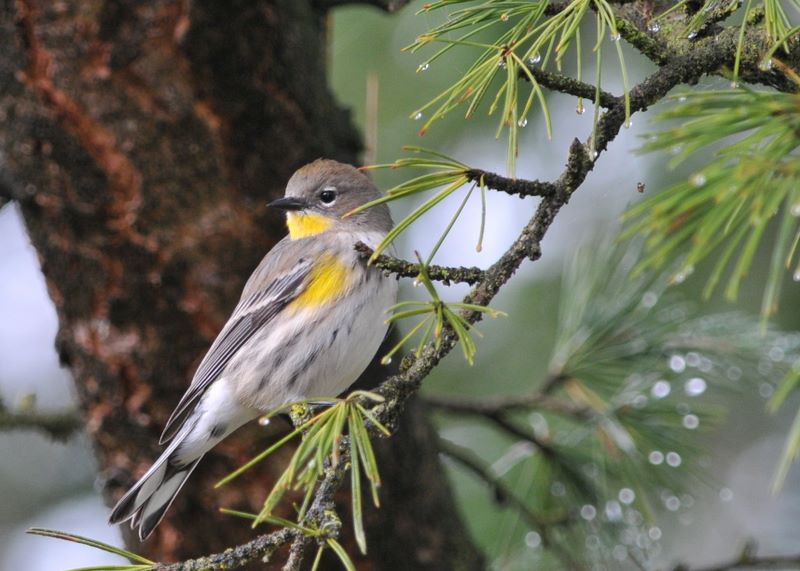
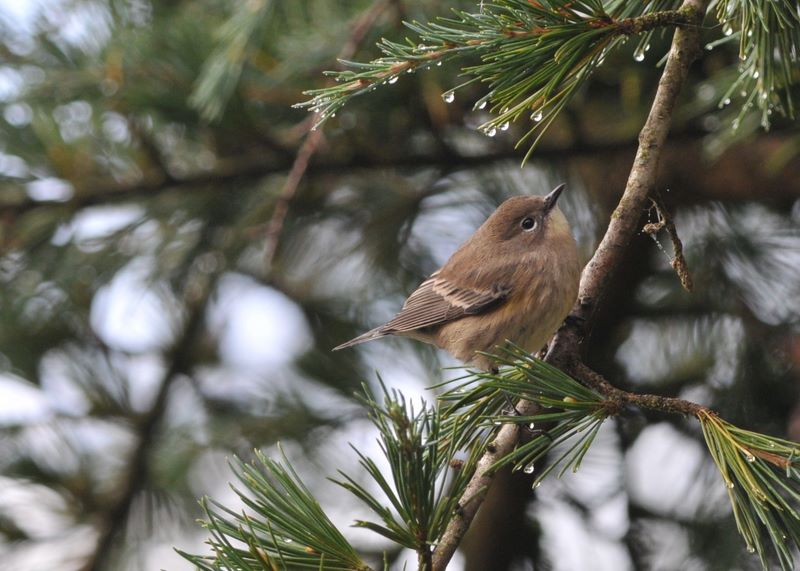 Lots of Yellow-rumped Warblers moving through this past week, typically 20-30 at a time in the row of
aphid-infested poplars behind the house. We hear their chorus of "chik" calls all through the day.
At certain times of the day they seem to concentrate on the southernmost poplar which stands at the
Lots of Yellow-rumped Warblers moving through this past week, typically 20-30 at a time in the row of
aphid-infested poplars behind the house. We hear their chorus of "chik" calls all through the day.
At certain times of the day they seem to concentrate on the southernmost poplar which stands at the
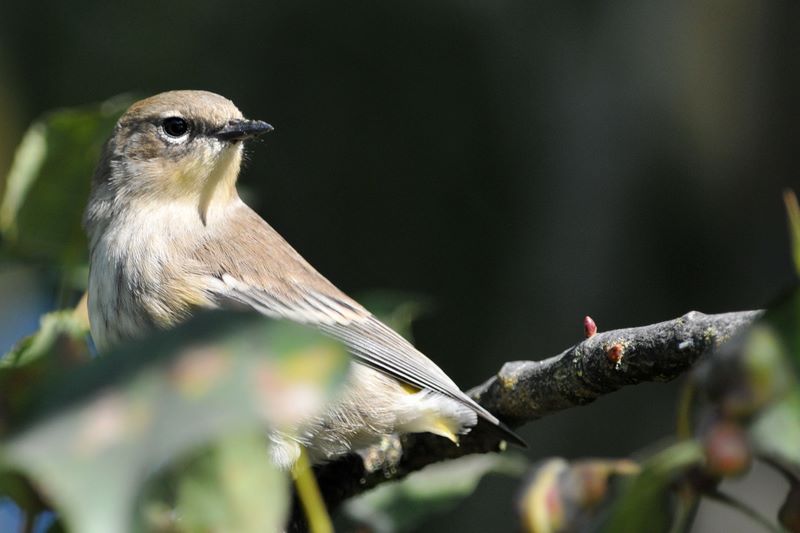 back corner of the workshop. I climb up onto the workshop roof with my 300mm lens and stand about
six feet from the lower branchs of the tree, waiting for the warblers to come close. Eventually
they do; I've snapped close to five hundred pictures over the past week though most of them
weren't worth keeping. It's tough to get clear views of the birds gleaning among the leaves.
The cedar in front of the house makes a better backdrop; I've been able to get a few photos from
the garage roof, including the first two displayed here.
back corner of the workshop. I climb up onto the workshop roof with my 300mm lens and stand about
six feet from the lower branchs of the tree, waiting for the warblers to come close. Eventually
they do; I've snapped close to five hundred pictures over the past week though most of them
weren't worth keeping. It's tough to get clear views of the birds gleaning among the leaves.
The cedar in front of the house makes a better backdrop; I've been able to get a few photos from
the garage roof, including the first two displayed here.
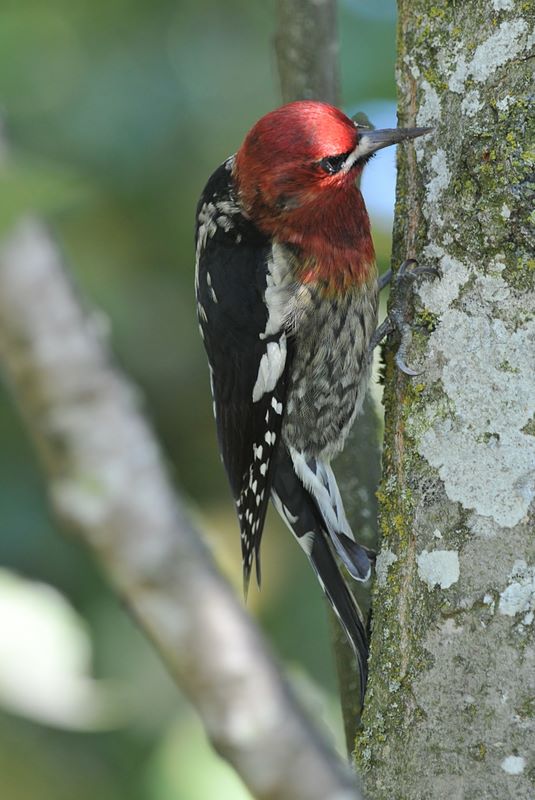
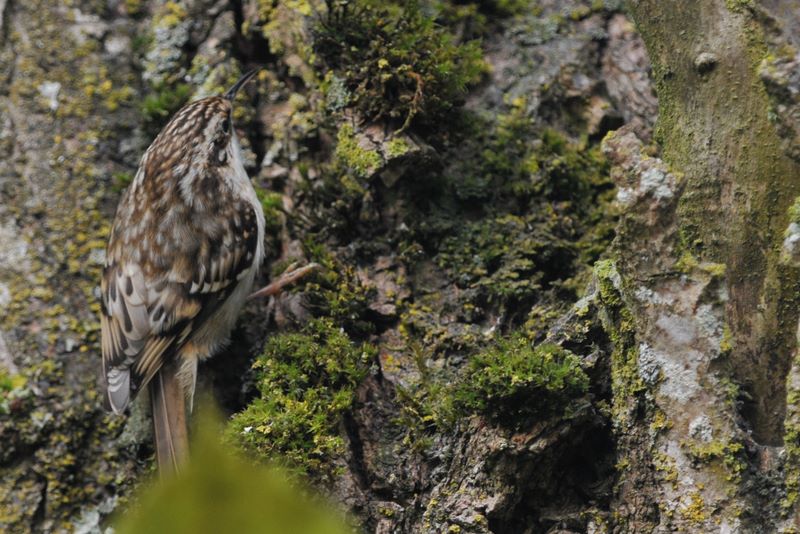
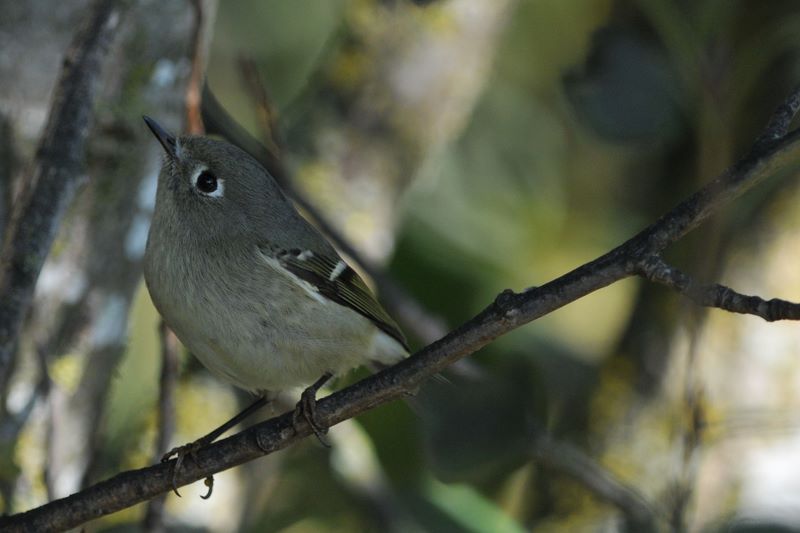
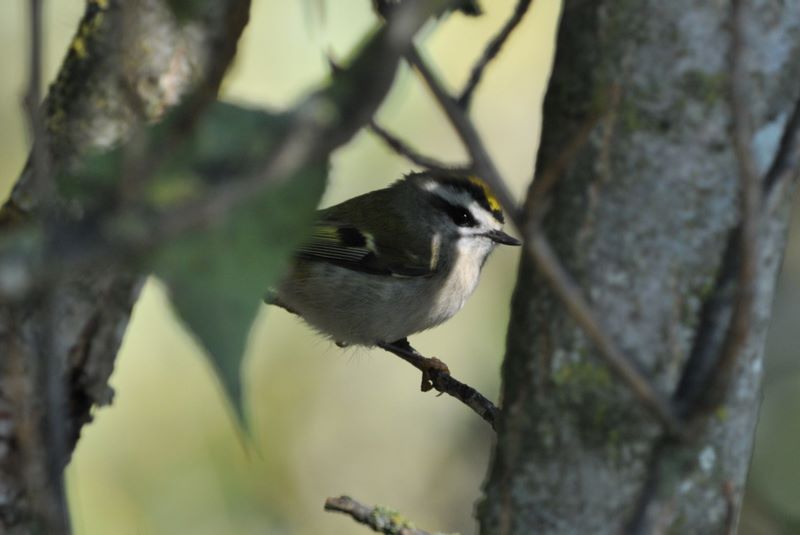 In addition to the butterbutts, over the past month from the same vantage point I've managed to get
closeups of Ruby-crowned and Golden-crowned Kinglets, Black-capped and Chestnut-backed Chickadees,
Bushtits, Brown Creepers, Cedar Waxwings, Downy Woodpeckers, a Red-breasted Sapsucker, a Steller's
Jay, and Orange-crowned, Yellow, Black-throated Gray and Nashville Warblers. The first wave of
warblers, all but the yellow-rumps, came through around the 10th of September. There may have been
earlier migrants, in particular the Wilson's warblers, but if so I missed them. After a lull around
the middle of September the Yellow-rumped Warblers, which had been numerous in the mountains during
my Chikamin Ridge hike, showed up here in the lowlands as well.
In addition to the butterbutts, over the past month from the same vantage point I've managed to get
closeups of Ruby-crowned and Golden-crowned Kinglets, Black-capped and Chestnut-backed Chickadees,
Bushtits, Brown Creepers, Cedar Waxwings, Downy Woodpeckers, a Red-breasted Sapsucker, a Steller's
Jay, and Orange-crowned, Yellow, Black-throated Gray and Nashville Warblers. The first wave of
warblers, all but the yellow-rumps, came through around the 10th of September. There may have been
earlier migrants, in particular the Wilson's warblers, but if so I missed them. After a lull around
the middle of September the Yellow-rumped Warblers, which had been numerous in the mountains during
my Chikamin Ridge hike, showed up here in the lowlands as well.



Note the missing tail

Red-breasted Sapsucker

Brown Creeper

Ruby-crowned Kinglet

Golden-crowned Kinglet
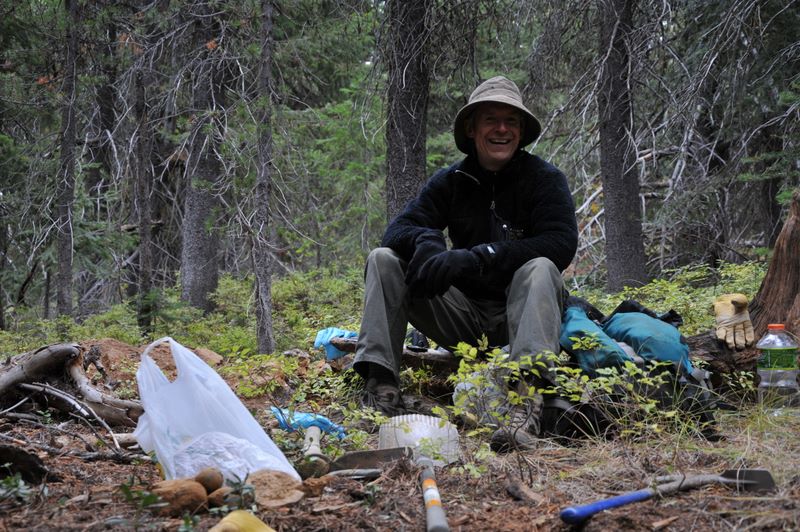
On lunch break
I considered trying to squeeze in one more backpack trip during the long period of mostly sunny and dry weather after the first of October but the deck needed painting and I wasn't quite up to more time alone in the woods so after Susan and I got the deck mostly done I took off with Pat to Red Top instead. I hadn't been there in a couple of years and after a day and a half of digging I remembered why - the eggs are never as numerous in reality as they are in memory. That and I already have plenty of them in piles around the workshop. It's still a thrill though when one of those round agate modules rolls out of the rusty soil as you pick away at the wall of your hole.
The road hadn't been graded since my last visit; some sections are studded with rough rocks, passable but slow. I found Pat's camper still cooling down at the trailhead parking area when I arrived mid-afternoon, having been delayed by a meeting with a retirement planner who told me that if I continued with my plan of working just part of each year, we'd probably still be OK financially. That was welcome news. Pat is already retired; I've had the summer off but am anticipating going back to contract work next month.
Gus found me as I approached the digging area down in the woods north of the lookout. Pat was already deep in a hole, only his head and shoulders showing above ground with a big pile of rocks and dusty soil behind him. He hadn't found much yet but had cleared out an area a couple feet across and four feet deep. I set to work clearing out a hole just uphill from his, a promising spot with a wide exposed bank to work at. By the time we quit for the day we'd worked about three hours and I had several good-sized eggs and a handful of smaller ones. Pat, demonstrating once again his remarkable knack for picking good holes, had about twice as many eggs as I did.
Overnight the temperature dropped into the mid-20's. We both stayed in Pat's camper, appreciating the lights and the propane heater. For supper I steamed fresh corn along with potatoes and carrots, all from Pat's garden. Lacking butter for the corn we used some Brie cheese I'd brought for lunch instead. Pat, who'd never tasted Brie before, decided it made a pretty good butter substitute. After supper we sat at the table in the dim light of the 12-volt lamp overhead and talked some, about rock saws and vegetable gardens and how there were alot of yellowjackets around Pat's place this year.
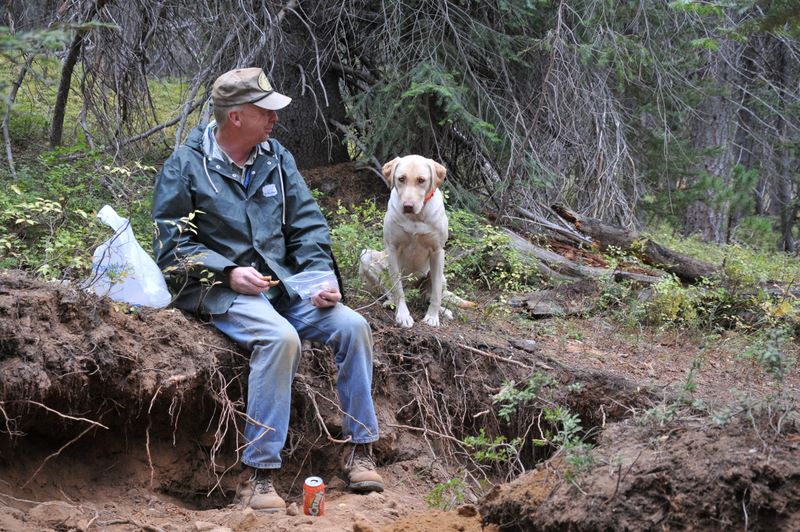
Pat and Gus at lunch
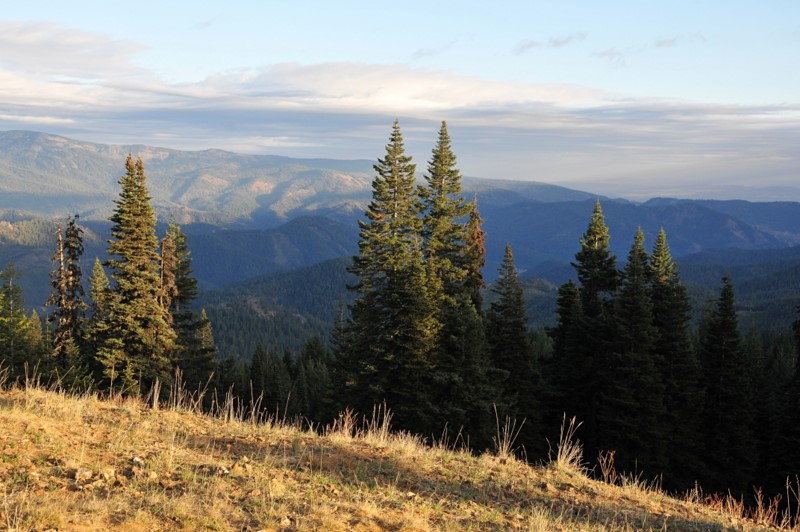
View east late afternoon
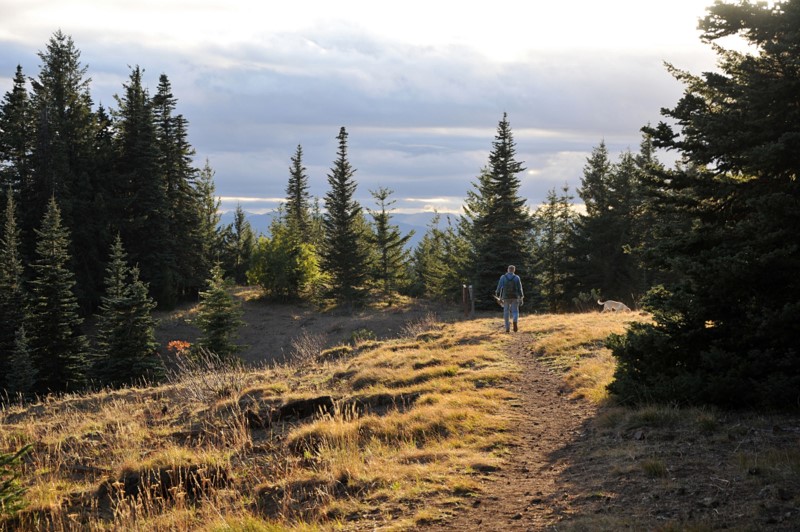
Heading back to camp
The sun came out at the end of the day but the breeze was biting. Odd how in mid-winter 27F feels warm but in early October it seems to penetrate whatever you put on. Approaching the car it occurred to me that I could be home with Susan by 8PM but I didn't say anything to Pat. The plan was to spend another night and anyhow, he'd have quite a bit longer drive home than I would. We were quite comfortable again in his camper, with more of Pat's sweet corn for supper and an Ibuprofen for dessert.
10/10/2009 Aasgard Pass hike Partly cloudy, 25-32
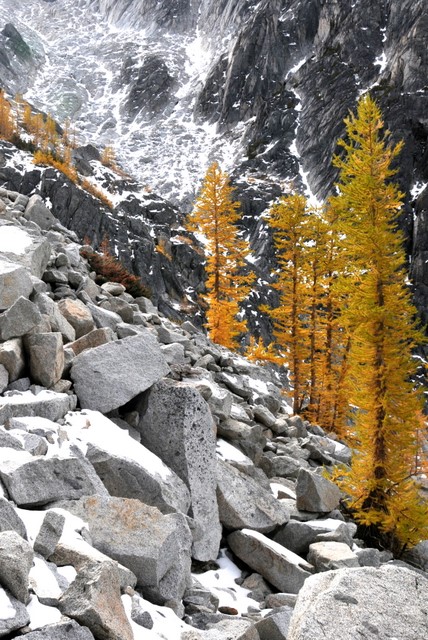 After breakfast Pat and I packed up quickly and were on our way down the hill by 8:15. The stars
had been bright when I'd gotten up at 3AM but the sky was overcast again in the morning with a mid-level
altostratus layer thick enough to block the sun. Considering a hike, I jogged up the road to an
outlook from which I could see Mt Stuart. The summit was visible though faded somewhat by a thin
fog of precipitation but there didn't appear to be any significant new snow, acceptable hiking
conditions. I considered heading home via Yakima the way Pat was going, perhaps stopping at Chinook
Pass for a hike on the way, but I'd never been to Colchuck Lake and it was just an hour away this
morning. Moreover it was Sabbath so even if I went home I wouldn't be finishing up the deck until
tomorrow anyhow. If I hiked up to Colchuck Lake I could eat at El Caporal in Cle Ellum on the way
back and still be home by 9:30 or so.
After breakfast Pat and I packed up quickly and were on our way down the hill by 8:15. The stars
had been bright when I'd gotten up at 3AM but the sky was overcast again in the morning with a mid-level
altostratus layer thick enough to block the sun. Considering a hike, I jogged up the road to an
outlook from which I could see Mt Stuart. The summit was visible though faded somewhat by a thin
fog of precipitation but there didn't appear to be any significant new snow, acceptable hiking
conditions. I considered heading home via Yakima the way Pat was going, perhaps stopping at Chinook
Pass for a hike on the way, but I'd never been to Colchuck Lake and it was just an hour away this
morning. Moreover it was Sabbath so even if I went home I wouldn't be finishing up the deck until
tomorrow anyhow. If I hiked up to Colchuck Lake I could eat at El Caporal in Cle Ellum on the way
back and still be home by 9:30 or so.
I started up a little after 10AM. The trailhead parking lot was full; I got the last space. The overcast was developing a little definition, a good sign, and the temperature was a chilly 27F. Other than a sore knot in the left side of my lower back from all the digging the day before I felt good. That's the spot I first aggravated on a snowshoe/snowboard hike some 15 years ago up one of the big open hillsides east of town in Sun Valley on a March morning. The wind out of the higher mountains was kicking up a fierce ground-blizzard on the exposed ridge and it was all I could do to stay upright and keep frostbite at bay. Somewhere up there I wrenched my back but didn't notice it until I thawed out back down at the car. Today it gave a little twinge every time I planted my left foot all the way up to Aasgard Pass but I mostly didn't notice it and it didn't get any worse all day.
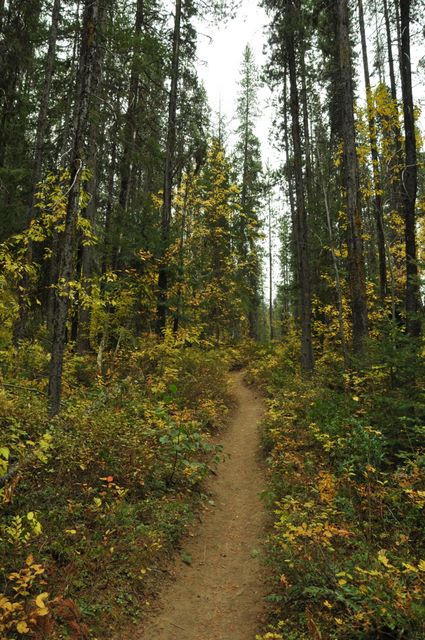
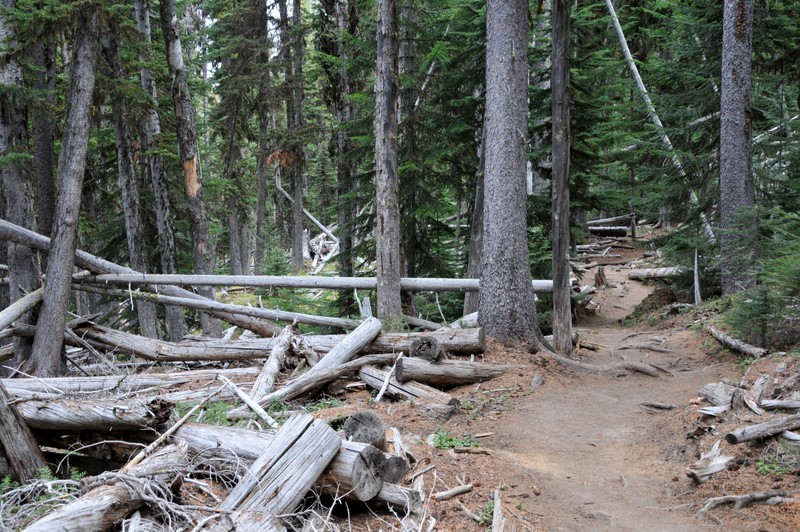 With a few brief photo stops I made it to the lake by noon. The forest in the valley is
mostly lodgepole with evidence of a burn several decades ago. Much of Icicle Creek up to the
trailhead burned 7 years ago (the morels we picked out of the ash along the Icicle Creek road the
following summer are still bagged up in the downstairs freezer) so I tend to think of big fires in
the area as a recent phenomenon, a consequence of warming climate compounded by years of fire
suppression, but the prevalence of lodgepole pine throughout the area indicates that fire has been
active there for a long time. On the way up to the lake the composition of the forest changes to
fir (and spruce?) with limber/whitebark pines mixed in. As they are across the western mountains,
many of the pines are dead or dying from insect infestations, facilitated (I think) like the fire
by warmer conditions in recent years. Bad news for Clark's Nutcrackers which rely on pine seeds as
a staple of their diet. I heard a few on the way down. I noticed very little bird activity on the
way up; they seem to lie low on cold overcast mornings. I listened particularly for crossbill calls,
having seen white-winged crossbills a few weeks ago at Joe Lake, but I heard none, probably due to
the lack of cones on the firs.
With a few brief photo stops I made it to the lake by noon. The forest in the valley is
mostly lodgepole with evidence of a burn several decades ago. Much of Icicle Creek up to the
trailhead burned 7 years ago (the morels we picked out of the ash along the Icicle Creek road the
following summer are still bagged up in the downstairs freezer) so I tend to think of big fires in
the area as a recent phenomenon, a consequence of warming climate compounded by years of fire
suppression, but the prevalence of lodgepole pine throughout the area indicates that fire has been
active there for a long time. On the way up to the lake the composition of the forest changes to
fir (and spruce?) with limber/whitebark pines mixed in. As they are across the western mountains,
many of the pines are dead or dying from insect infestations, facilitated (I think) like the fire
by warmer conditions in recent years. Bad news for Clark's Nutcrackers which rely on pine seeds as
a staple of their diet. I heard a few on the way down. I noticed very little bird activity on the
way up; they seem to lie low on cold overcast mornings. I listened particularly for crossbill calls,
having seen white-winged crossbills a few weeks ago at Joe Lake, but I heard none, probably due to
the lack of cones on the firs.
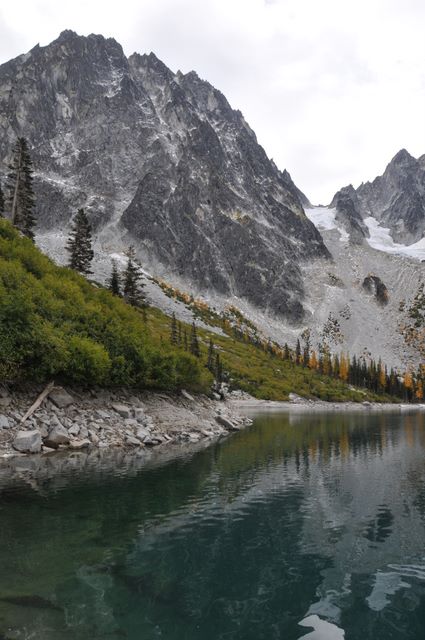
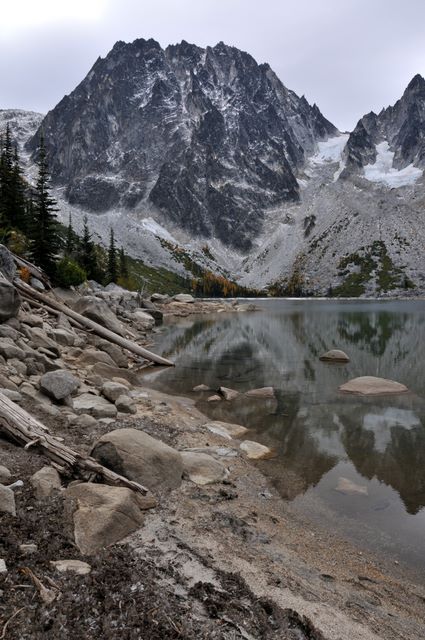 Where the trail approached the lake I dropped down to the shore. Colchuck Lake is not as attractive
as many alpine lakes because the water level fluctuates. A dam at the outlet is the likely culprit. At
low water the lake is surrounded by a ten foot high bathtub ring of bleached boulders and barren
dirt. The exposed shoreline along the far side of the lake, accessible via a makeshift bridge of
driftwood across the outlet channel, appeared to provide a more direct route to the head of the lake
than the up and down trail through the woods along the west shore. I went for it, taking a chance
that the one section I couldn't see, where a cliff appeared to drop right down to the water, would
prove to be passable. It was, though clambering over (and in one spot, under) boulders along the
shore was probably slower than hiking the trail would have been.
Where the trail approached the lake I dropped down to the shore. Colchuck Lake is not as attractive
as many alpine lakes because the water level fluctuates. A dam at the outlet is the likely culprit. At
low water the lake is surrounded by a ten foot high bathtub ring of bleached boulders and barren
dirt. The exposed shoreline along the far side of the lake, accessible via a makeshift bridge of
driftwood across the outlet channel, appeared to provide a more direct route to the head of the lake
than the up and down trail through the woods along the west shore. I went for it, taking a chance
that the one section I couldn't see, where a cliff appeared to drop right down to the water, would
prove to be passable. It was, though clambering over (and in one spot, under) boulders along the
shore was probably slower than hiking the trail would have been.
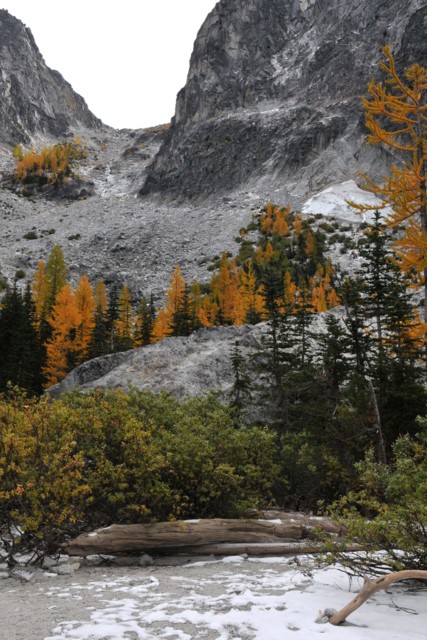 A sandy beach fringed with willow, fir and larch offers waterfront campsites at the head of the
lake. The trail up to Aasgard Pass starts up behind one of the nicer spots. After winding through
young firs and willow scrub for a couple hundred feet it starts up talus. The way could be
difficult to follow were it not for large regularly-spaced cairns. About half way up the route
swings to the left to get around a cliff band capped with colorful larch. Towards the summit the
A sandy beach fringed with willow, fir and larch offers waterfront campsites at the head of the
lake. The trail up to Aasgard Pass starts up behind one of the nicer spots. After winding through
young firs and willow scrub for a couple hundred feet it starts up talus. The way could be
difficult to follow were it not for large regularly-spaced cairns. About half way up the route
swings to the left to get around a cliff band capped with colorful larch. Towards the summit the
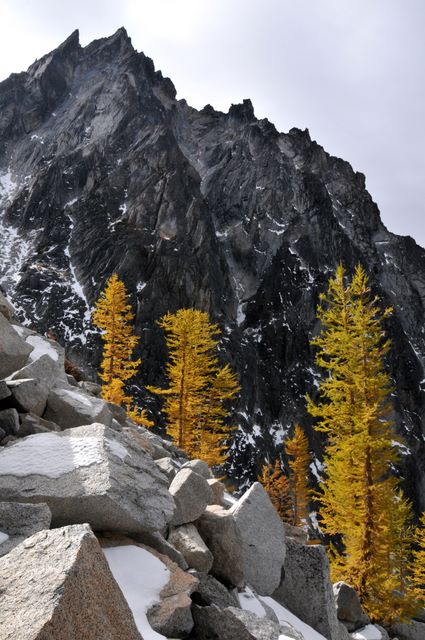 trail scrambles up through a ledgy area. That section was very slippery due to several inches of
snow compacted on the tread; I found the going easier off the trail where I could hop from rock to
rock. A few hundred feet from the top the wind picked up and it got cold fast. I stopped and put
on wind pants (Taku, a steal on sale last month at REI for $50), an extra fleece shirt and my cuddly
Monkey Man fleece (on sale at LL Bean two months ago for $100).
trail scrambles up through a ledgy area. That section was very slippery due to several inches of
snow compacted on the tread; I found the going easier off the trail where I could hop from rock to
rock. A few hundred feet from the top the wind picked up and it got cold fast. I stopped and put
on wind pants (Taku, a steal on sale last month at REI for $50), an extra fleece shirt and my cuddly
Monkey Man fleece (on sale at LL Bean two months ago for $100).
A woman had stopped at the same spot to wait for the rest of her party so we got to talking. They were doing a one-day loop through the Enchantments, 18 miles total with 12 left to go. The rest of her party was apparently having a tough time down in the snowy section. At the rate they were going they'd be doing at least the last 6 miles after dark. I dug out some lunch and sucked mouthfuls of almond butter and honey off the blade of my knife, sticking my freezing fingers into my armpits between bites to ease the pain. At 25F there was no way to spread the honey on my bread. The woman's party began to arrive, including one guy without gloves. He was trying to hold onto his hiking poles and complaining that his hands were numb. I searched in my pack, thinking I might have forgotten to take out the heavy fabric gloves I was digging with yesterday. No such luck. It occurred to me that someone else in his group might have extra gloves, or lacking those, then socks, so I asked the woman's husband I think, who seemed to be the leader. Right away he dug out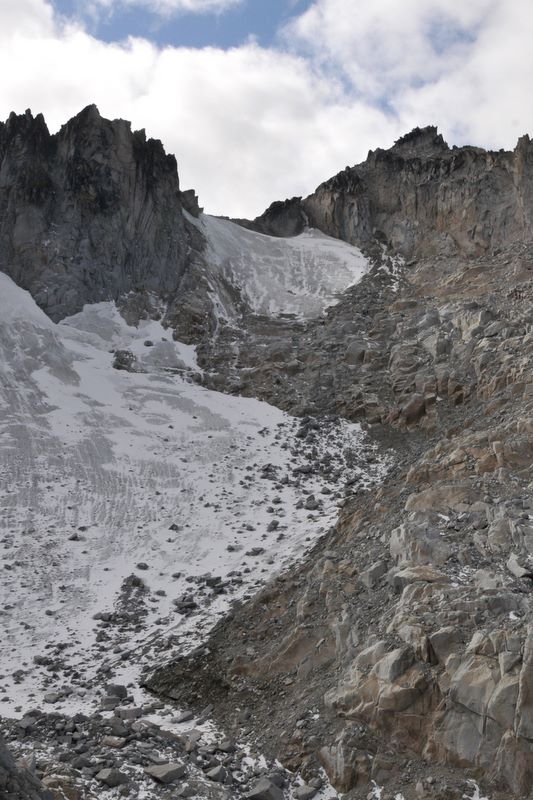
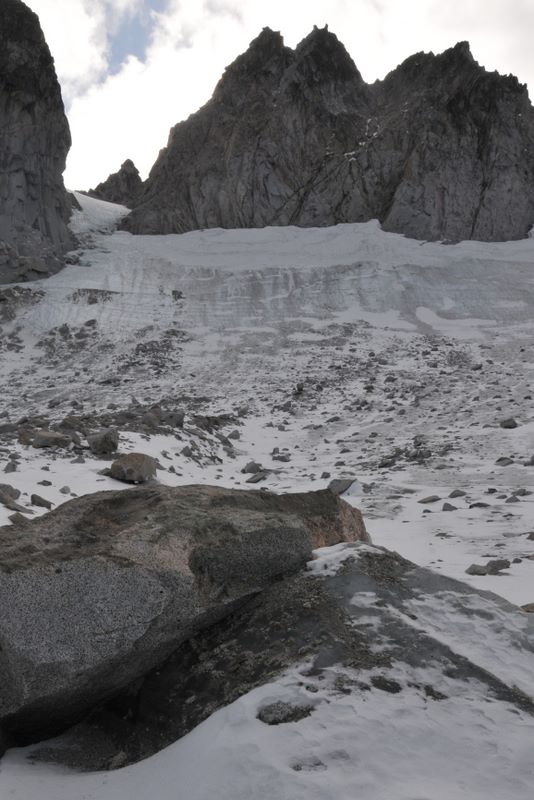 his extra socks and gave them to the guy with numb hands. My first good deed of the day.
his extra socks and gave them to the guy with numb hands. My first good deed of the day.
By the time I reached the pass the overcast was breaking up. The sunshine was very pleasant though it wasn't melting anything. Feeling strong I decided to see if I could get up Dragontail Peak by scrambling up to the right of the senescent glacier southeast of the pass. The glacier is clearly melting away year by year. Rocks which have fallen onto the snow over the years are now perched on little hummocks of blue ice. Along the edges of the glacier shallow ice caves have opened up under the talus. I traversed up across the low angle ice relying on crusty new snow for traction. That worked most of the time. The scrambling was tougher than it looked - lots of smearing up steep ledges but fortunately frequent talus shelves limited the exposure. I made it up to just over 8400'
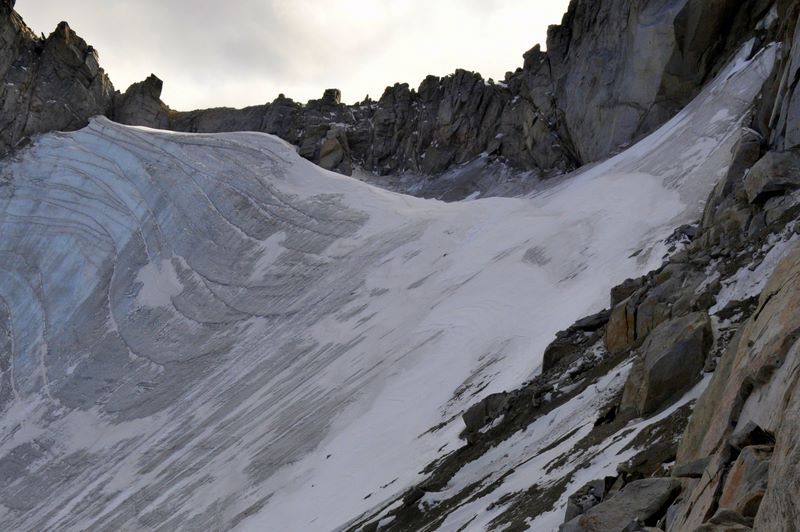
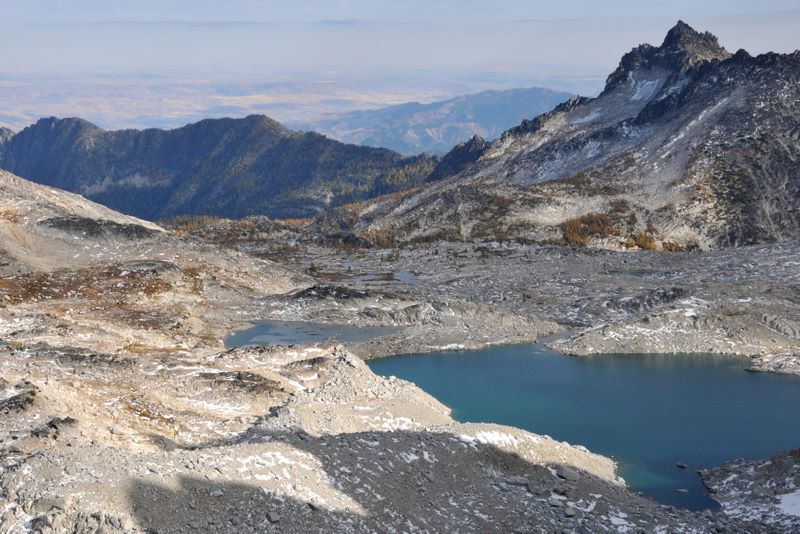
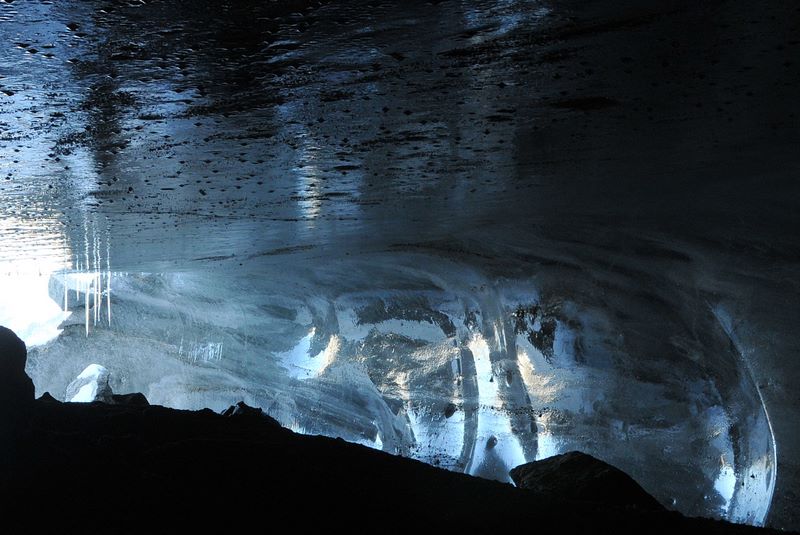 at the base of the summit cliffs. With crampons and an axe I could have traversed across the top of
the glacier and probably gained the ridge but that will have to wait for another trip. The descent
back to Aasgard Pass took another 40 minutes so I ended up starting down at 4PM, exactly an hour
after my planned turnaround time.
at the base of the summit cliffs. With crampons and an axe I could have traversed across the top of
the glacier and probably gained the ridge but that will have to wait for another trip. The descent
back to Aasgard Pass took another 40 minutes so I ended up starting down at 4PM, exactly an hour
after my planned turnaround time.
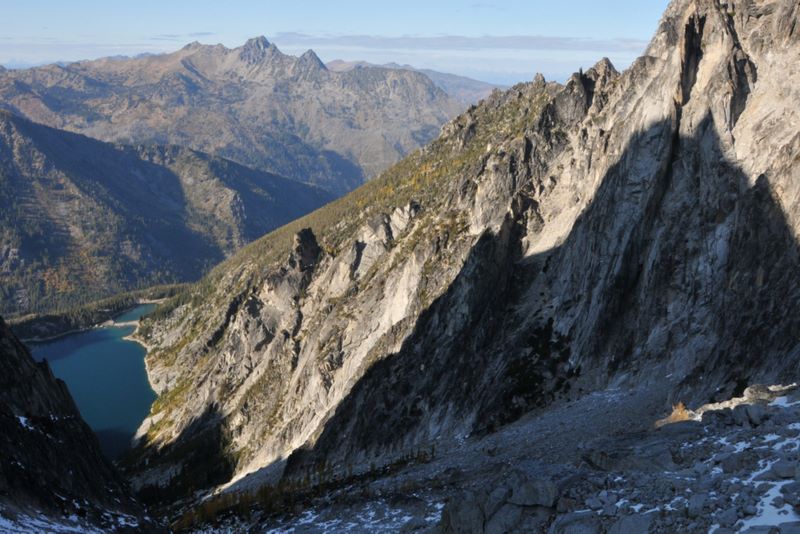
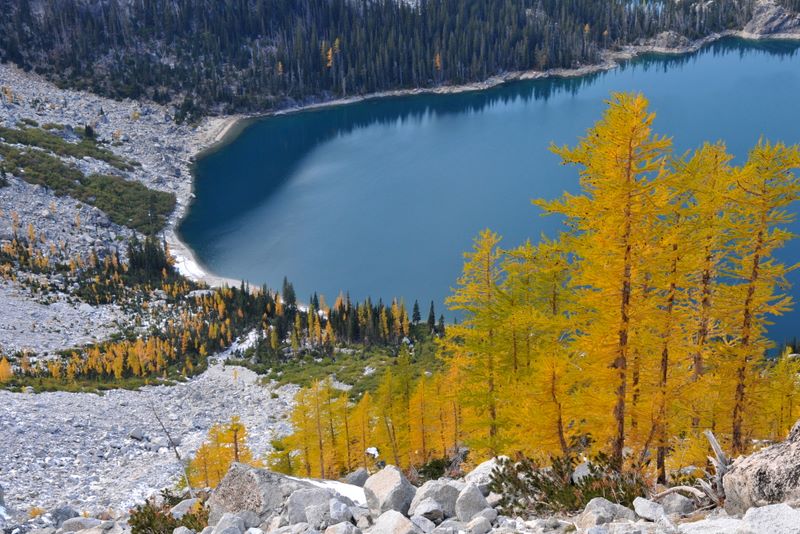
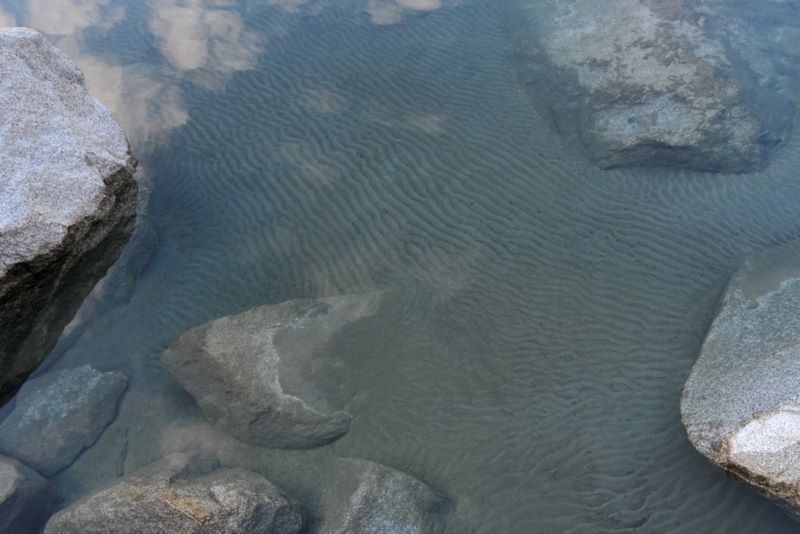 With photo stops I reached the lake outlet at 5:45 via the trail, a faster route than the rocky
shore I'd followed on the way up. The descent of the snowy section near the top of the pass
required considerable care. Other than campers along the lake I saw no-one on the remainder of the
descent until I caught up to a young woman and her 5-year old daughter on the Lake Stuart trail
while still over a mile from the trailhead. It seemed unlikely that they would make it out before
dark so I asked if she had a flashlight. She did not. At the last minute I'd stuck an extra
flashlight in my pack, the lightweight solar-powered light I bought at Costco a couple of weeks ago, so I
gave that one to her and dug out the LED headlamp for myself. They started down the trail while I
repacked my pack and she must have really hustled because it took me quite a while to catch up to
her again. By that time it was already getting a little difficult to spot the roots and rocks in
the trail. I asked if I could hike with them and that was fine with her. Even with a light I don't
particularly like hiking alone after dark, and all the more so since my headlamp batteries were old
and gave barely enough light to see the ground. Her daughter talked almost continually to whichever
of us would respond so the time passed quickly. The woman takes her daughter out hiking every
weekend. She drove all the way from Seattle to hike up to Colchuck Lake but decided on Lake Stuart
instead because they started so late. "Not that pretty", she said. According to the daughter Dad
builds houses. Also he's brown. I didn't ask why he didn't join them on their hikes. When we
reached the trailhead at 7:15 a little light remained in the sky overhead but the woods were
completely dark; it would have been very difficult to follow the last half mile of the trail without
the flashlight. At the trailhead she gave me back the light, told me how grateful she was and said
"God bless you". Too late it occurred to me to respond "He already has", for I too was grateful for
their company and for the opportunity to help. Two good deeds in one day.
With photo stops I reached the lake outlet at 5:45 via the trail, a faster route than the rocky
shore I'd followed on the way up. The descent of the snowy section near the top of the pass
required considerable care. Other than campers along the lake I saw no-one on the remainder of the
descent until I caught up to a young woman and her 5-year old daughter on the Lake Stuart trail
while still over a mile from the trailhead. It seemed unlikely that they would make it out before
dark so I asked if she had a flashlight. She did not. At the last minute I'd stuck an extra
flashlight in my pack, the lightweight solar-powered light I bought at Costco a couple of weeks ago, so I
gave that one to her and dug out the LED headlamp for myself. They started down the trail while I
repacked my pack and she must have really hustled because it took me quite a while to catch up to
her again. By that time it was already getting a little difficult to spot the roots and rocks in
the trail. I asked if I could hike with them and that was fine with her. Even with a light I don't
particularly like hiking alone after dark, and all the more so since my headlamp batteries were old
and gave barely enough light to see the ground. Her daughter talked almost continually to whichever
of us would respond so the time passed quickly. The woman takes her daughter out hiking every
weekend. She drove all the way from Seattle to hike up to Colchuck Lake but decided on Lake Stuart
instead because they started so late. "Not that pretty", she said. According to the daughter Dad
builds houses. Also he's brown. I didn't ask why he didn't join them on their hikes. When we
reached the trailhead at 7:15 a little light remained in the sky overhead but the woods were
completely dark; it would have been very difficult to follow the last half mile of the trail without
the flashlight. At the trailhead she gave me back the light, told me how grateful she was and said
"God bless you". Too late it occurred to me to respond "He already has", for I too was grateful for
their company and for the opportunity to help. Two good deeds in one day.
As usual I stopped at El Caporal in Cle Elum for supper. The salsa and chips were tasty; the Burrito Relleno fat and featureless. Next time I'll go back to the Burrito Vegetal, which though similar has perhaps a little more flavor.

Larches part way up the pass
I started up a little after 10AM. The trailhead parking lot was full; I got the last space. The overcast was developing a little definition, a good sign, and the temperature was a chilly 27F. Other than a sore knot in the left side of my lower back from all the digging the day before I felt good. That's the spot I first aggravated on a snowshoe/snowboard hike some 15 years ago up one of the big open hillsides east of town in Sun Valley on a March morning. The wind out of the higher mountains was kicking up a fierce ground-blizzard on the exposed ridge and it was all I could do to stay upright and keep frostbite at bay. Somewhere up there I wrenched my back but didn't notice it until I thawed out back down at the car. Today it gave a little twinge every time I planted my left foot all the way up to Aasgard Pass but I mostly didn't notice it and it didn't get any worse all day.

Lodgepole along the trail

Fir forest below the lake

Along the far shore 2

Along the far shore 1

View up Aasgard Pass from the beach
The route mostly on the left.
The route mostly on the left.

Larches and Dragontail Peak
A woman had stopped at the same spot to wait for the rest of her party so we got to talking. They were doing a one-day loop through the Enchantments, 18 miles total with 12 left to go. The rest of her party was apparently having a tough time down in the snowy section. At the rate they were going they'd be doing at least the last 6 miles after dark. I dug out some lunch and sucked mouthfuls of almond butter and honey off the blade of my knife, sticking my freezing fingers into my armpits between bites to ease the pain. At 25F there was no way to spread the honey on my bread. The woman's party began to arrive, including one guy without gloves. He was trying to hold onto his hiking poles and complaining that his hands were numb. I searched in my pack, thinking I might have forgotten to take out the heavy fabric gloves I was digging with yesterday. No such luck. It occurred to me that someone else in his group might have extra gloves, or lacking those, then socks, so I asked the woman's husband I think, who seemed to be the leader. Right away he dug out

Dragontail Peak route
(lower left to upper right)
(lower left to upper right)

Rock on ice
By the time I reached the pass the overcast was breaking up. The sunshine was very pleasant though it wasn't melting anything. Feeling strong I decided to see if I could get up Dragontail Peak by scrambling up to the right of the senescent glacier southeast of the pass. The glacier is clearly melting away year by year. Rocks which have fallen onto the snow over the years are now perched on little hummocks of blue ice. Along the edges of the glacier shallow ice caves have opened up under the talus. I traversed up across the low angle ice relying on crusty new snow for traction. That worked most of the time. The scrambling was tougher than it looked - lots of smearing up steep ledges but fortunately frequent talus shelves limited the exposure. I made it up to just over 8400'

Route to the ridge

Upper Enchantments

Ice Cave

Colchuck Lake from Aasgard Pass

Larches and the lake

Writing in the sand
As usual I stopped at El Caporal in Cle Elum for supper. The salsa and chips were tasty; the Burrito Relleno fat and featureless. Next time I'll go back to the Burrito Vegetal, which though similar has perhaps a little more flavor.
10/21/2009 Mt Washington Valleys - mostly sunny, 55; Summit - fog, 31, W 32 Photo Gallery
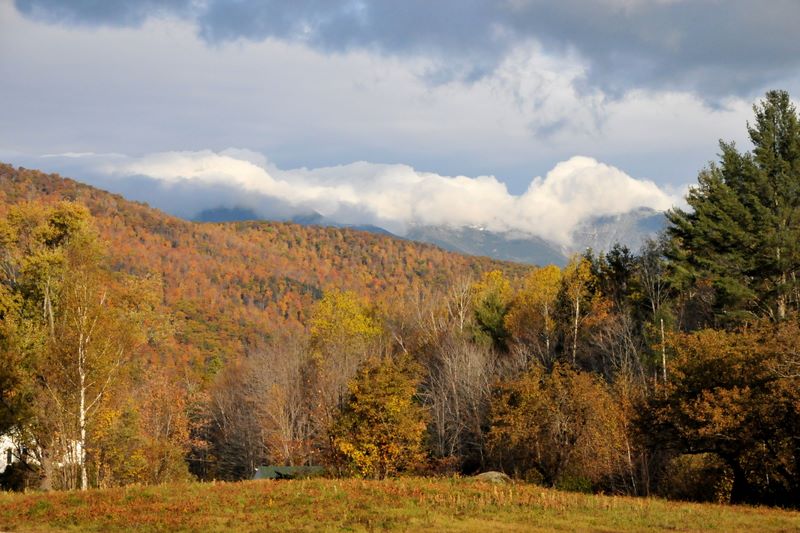 Yesterday evening I suggested to Eric that we do a hike. He'd mentioned Rainbow Ridge which sounded
good to me because I wanted to spend some time in the woods, but this morning he was more interested
in Washington. The forecast called for summits in and out of the clouds with not too much wind,
decent conditions, so I agreed. The route would depend on how much ice there was; we figured
Tuckerman's would be too icy so we chose Boott Spur which kept our options open - we could come back
down Boott Spur or cross over to Lion's Head if that looked OK or even go to the summit.
Yesterday evening I suggested to Eric that we do a hike. He'd mentioned Rainbow Ridge which sounded
good to me because I wanted to spend some time in the woods, but this morning he was more interested
in Washington. The forecast called for summits in and out of the clouds with not too much wind,
decent conditions, so I agreed. The route would depend on how much ice there was; we figured
Tuckerman's would be too icy so we chose Boott Spur which kept our options open - we could come back
down Boott Spur or cross over to Lion's Head if that looked OK or even go to the summit.
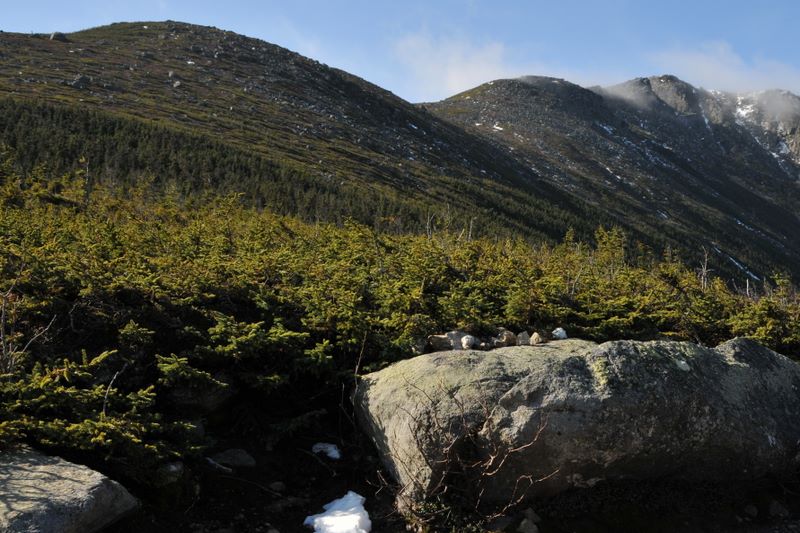 We left Pinkham at 9:40AM in the sunshine and hiked steadily up to the flat spot on the Boott Spur
ridge with just one stop at the overlook not far below treeline where I took a few photos and we put
on clothes - a long-sleeved tech shirt under my slightly damp t-shirt, then a mid-weight tech shirt
and my favorite Monkey Man fleece jacket, a fleece cap and fleece gloves. I hadn't been able to
find my wind shell when I was packing up this morning so I was a bit underdressed for the wind. Ten
minutes later though, we had to strip most of it off again in the sheltered section of trail above
Split Rock.
We left Pinkham at 9:40AM in the sunshine and hiked steadily up to the flat spot on the Boott Spur
ridge with just one stop at the overlook not far below treeline where I took a few photos and we put
on clothes - a long-sleeved tech shirt under my slightly damp t-shirt, then a mid-weight tech shirt
and my favorite Monkey Man fleece jacket, a fleece cap and fleece gloves. I hadn't been able to
find my wind shell when I was packing up this morning so I was a bit underdressed for the wind. Ten
minutes later though, we had to strip most of it off again in the sheltered section of trail above
Split Rock.
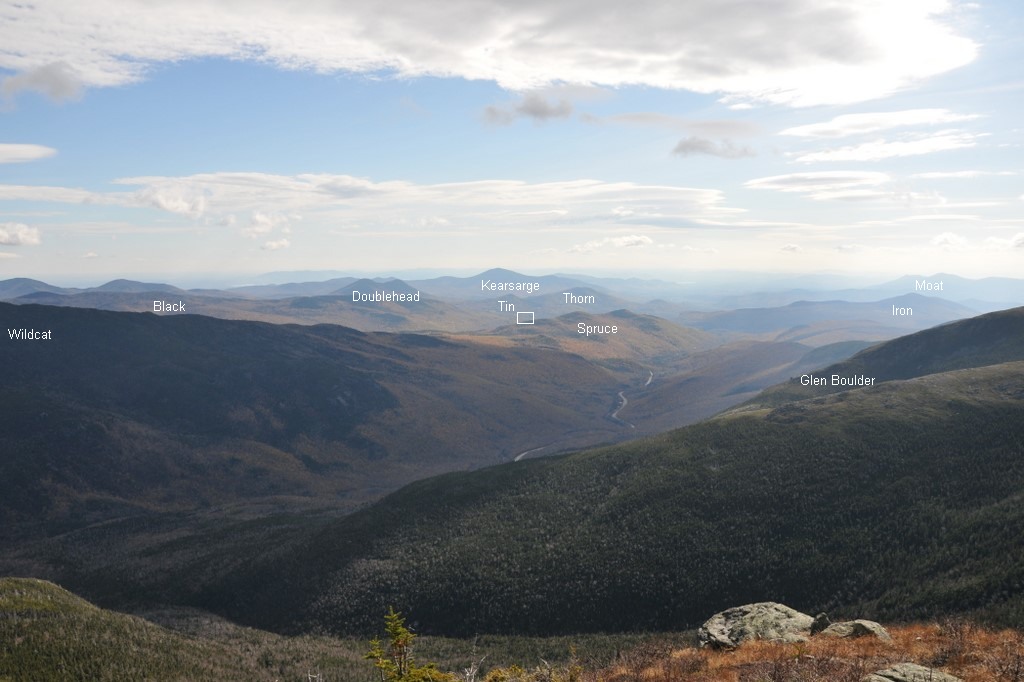 At the flat spot on the ridge at about 4600' we stopped to rest in the sunny lee of a ledge and
ended up eating lunch. Beautiful view down Pinkham Notch to Jackson; with binoculars, and even more
when I zoomed in on a photo taken with the 300mm lens, we could pick out our house over the shoulder
of Spruce. During lunch a stationary roll of cloud developed over the valley, forming on the
windward side and dissipating on the lee side of the first wave crest downwind of Mt Washington.
Boott Spur and the summit, which had been mostly in the clouds when we reached timberline, had
become mostly clear by the time we started up again. From Boott Spur we could see a layer of fluffy
At the flat spot on the ridge at about 4600' we stopped to rest in the sunny lee of a ledge and
ended up eating lunch. Beautiful view down Pinkham Notch to Jackson; with binoculars, and even more
when I zoomed in on a photo taken with the 300mm lens, we could pick out our house over the shoulder
of Spruce. During lunch a stationary roll of cloud developed over the valley, forming on the
windward side and dissipating on the lee side of the first wave crest downwind of Mt Washington.
Boott Spur and the summit, which had been mostly in the clouds when we reached timberline, had
become mostly clear by the time we started up again. From Boott Spur we could see a layer of fluffy
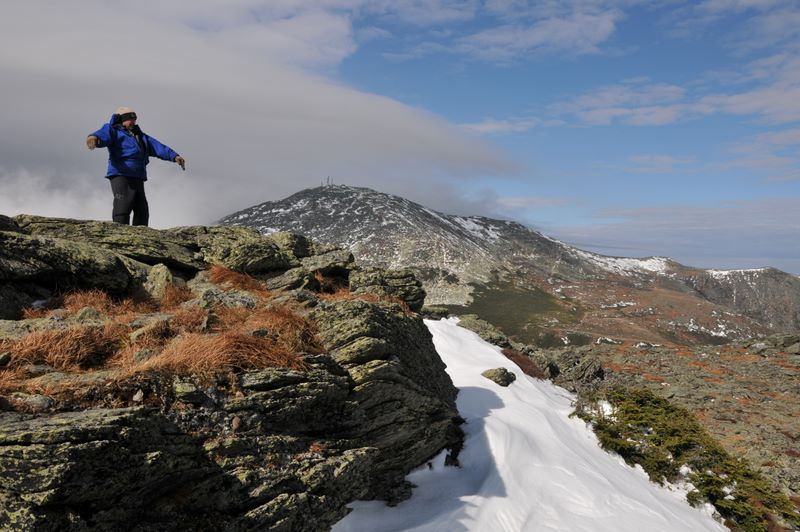
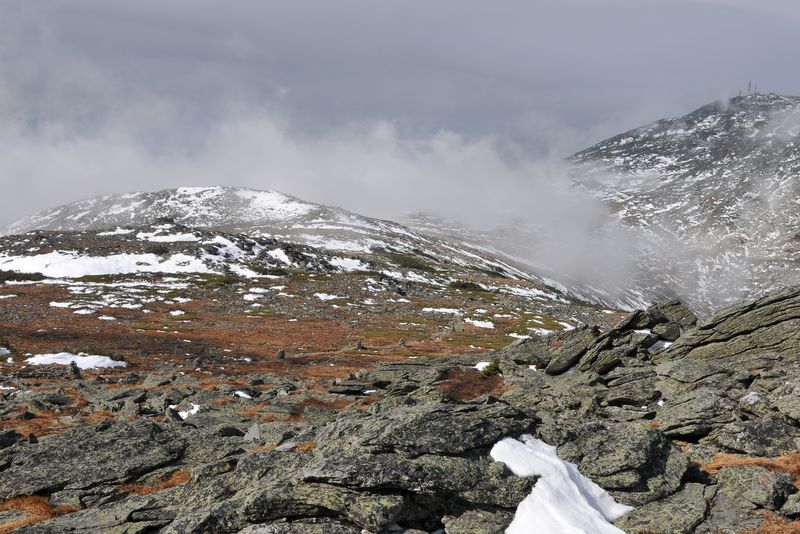 stratus banked up against the summit and the southern peaks. A pretty stiff breeze was blowing from
that direction but the clouds were dissipating over the flats between us and the Cone. We lingered
in the shelter of Boott Spur for another half hour or so to finish up lunch.
stratus banked up against the summit and the southern peaks. A pretty stiff breeze was blowing from
that direction but the clouds were dissipating over the flats between us and the Cone. We lingered
in the shelter of Boott Spur for another half hour or so to finish up lunch.
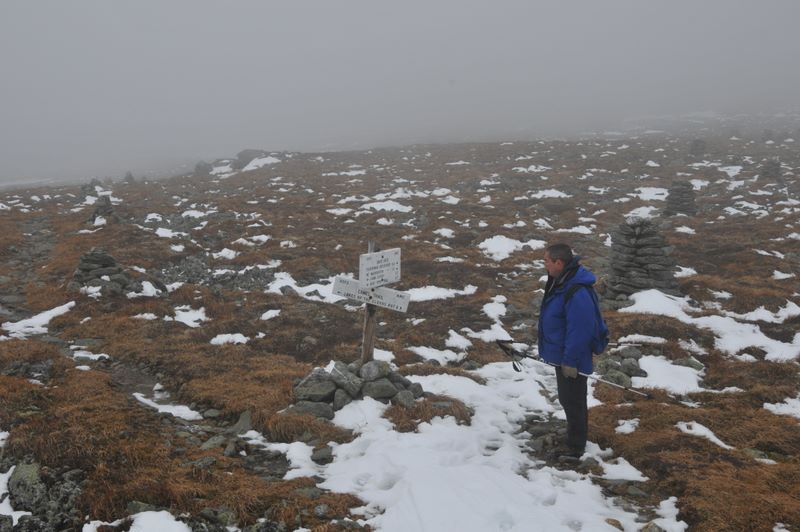 The hike across the flats into the wind was cold. The temperature was only a few degrees above
freezing, the fog closed in on us and my fleece hat didn't do much to stop the wind. At Camel
Junction my fingers had begun to warm up again and we agreed to go for the summit via the Davis and
Crawford Paths. Eric led the way. A few hundred feet below the summit we began to run into a fair
The hike across the flats into the wind was cold. The temperature was only a few degrees above
freezing, the fog closed in on us and my fleece hat didn't do much to stop the wind. At Camel
Junction my fingers had begun to warm up again and we agreed to go for the summit via the Davis and
Crawford Paths. Eric led the way. A few hundred feet below the summit we began to run into a fair
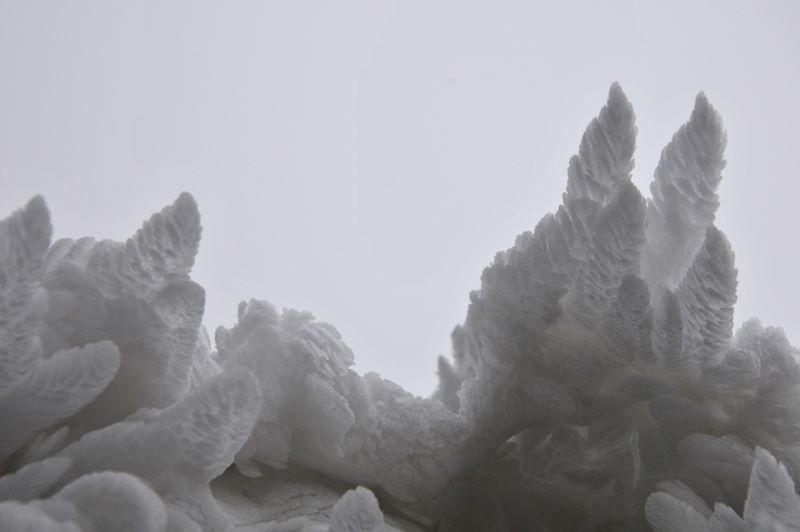
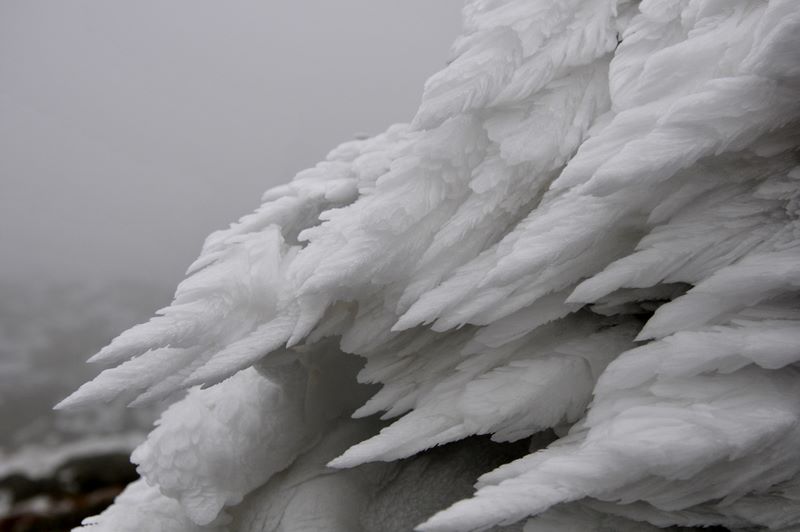 amount of rime ice, probably indicating where freezing level had been the night before. The rime
ice was melting a bit but still in excellent condition. I could have spent an hour or more
photographing the ice formations, feathery-looking spears extending into the wind from every exposed
surface. The ice was best right below the summit, where I noticed that for the first time the fog
was freezing on my fleece.
amount of rime ice, probably indicating where freezing level had been the night before. The rime
ice was melting a bit but still in excellent condition. I could have spent an hour or more
photographing the ice formations, feathery-looking spears extending into the wind from every exposed
surface. The ice was best right below the summit, where I noticed that for the first time the fog
was freezing on my fleece.
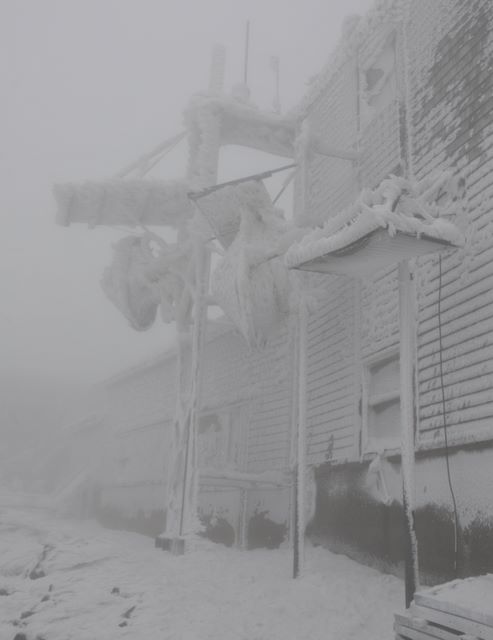
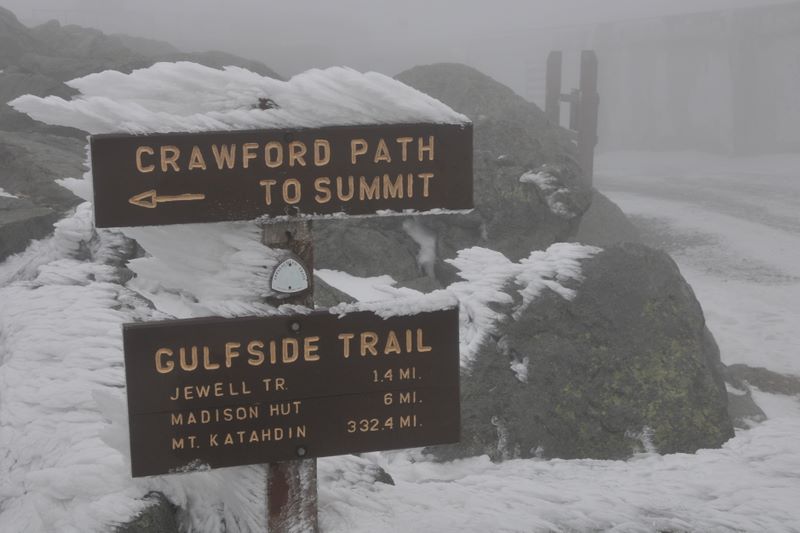 The buildings and towers at the summit looked very wintry all coated with rime. We made the
obligatory 25' pilgrimmage from the parking lot to the official summit, paid a quick visit to the
observation deck and took shelter briefly in the Observatory building where a group of orange-coated
Observatory volunteers were apparently waiting for a ride down. We didn't stay to talk, lingering
only long enough to check the weather board (31F, 32mph wind) before setting out for Pinkham. We
set no speed records on the descent. My legs had been tired all day and particularly so on the trek
down the Fire Trail. I was glad I'd brought John's hiking poles.
The buildings and towers at the summit looked very wintry all coated with rime. We made the
obligatory 25' pilgrimmage from the parking lot to the official summit, paid a quick visit to the
observation deck and took shelter briefly in the Observatory building where a group of orange-coated
Observatory volunteers were apparently waiting for a ride down. We didn't stay to talk, lingering
only long enough to check the weather board (31F, 32mph wind) before setting out for Pinkham. We
set no speed records on the descent. My legs had been tired all day and particularly so on the trek
down the Fire Trail. I was glad I'd brought John's hiking poles.

Washington from the house before our hike

Boott Spur ridge from the overlook

View towards Jackson

Eric on Boott Spur

View from Boott Spur

Eric at Camel Junction




25' to the summit
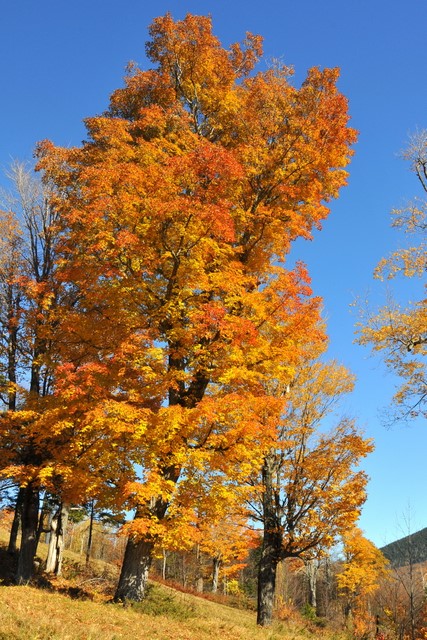
Bright Sugar Maple on Black
Since the hike up Washington with Eric I've been looking for one more opportunity to get out in the mountains before we returned to Seattle, one more sunny day with no obligations. I suggested the ledges on Baldface, one of my favorite hikes, to Eric a couple evenings ago but he didn't want to drive that far. Reluctant to take a whole day alone away from the family, I stayed home and went for a swim with John later in the afternoon instead. Then Saturday was rainy and Sunday was the half marathon so that left only today. Fortunately the weather this morning was perfect.
I wanted a hike where the trees would still have their leaves. On all the higher mountains, most likely including Baldface, the leaves have already fallen, frozen by cold weather and even some snow and swept off by northwest winds. The birches, red maples and most of the sugar maples are already bare, their recently glorious foliage now brown and crisp underfoot. The colors that remain are
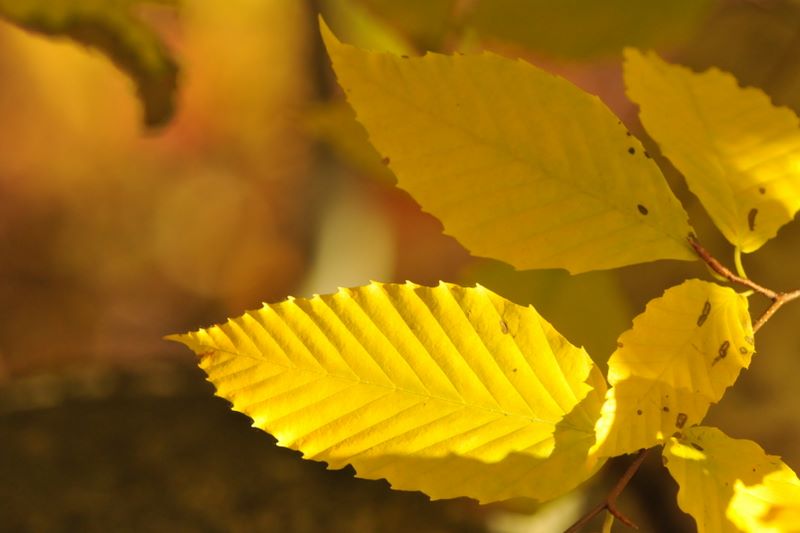
Beech leaves
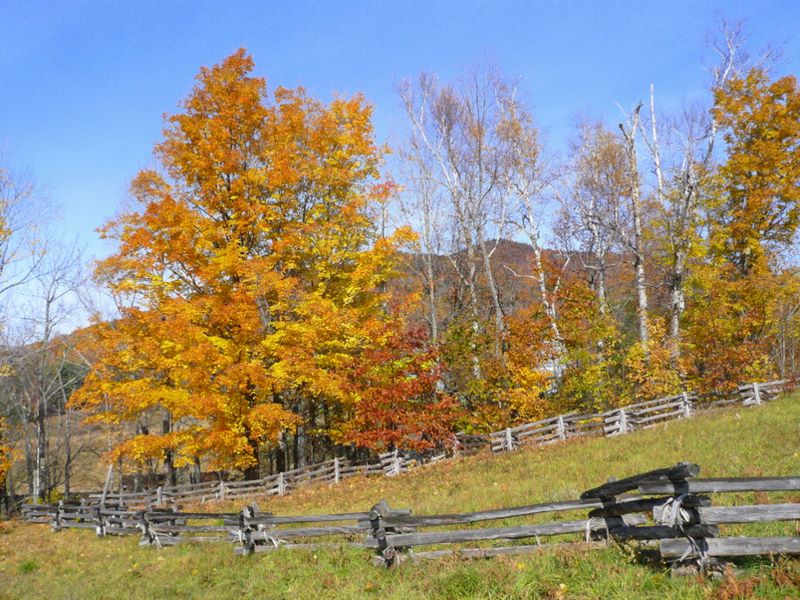
Sugar maples and birches
Black Mountain in background
Black Mountain in background
Recalling successful bird photo outings up on the side of Black Mountain last June and the color lingering a few days ago on the slopes below the Knoll, I decided to hike up the trail behind Overlook. No driving required. John thought he might like to come with me, and then Mom. Figuring Susan could keep up with us I invited her and when Sarah showed up she was interested too. I packed some lunch then ate it while we waited for each other to finish getting ready. Hoping for birds I put on the 300mm lens. John and Sarah and Mom brought hiking poles; years of skiing (or perhaps just their years) have taken a toll on their knees. Mom is scheduled for knee-replacement surgery on both knees a week from today, so this would be her last hike on the joints she was born with.
The hike was just what I was looking for. The trail starts out on what was once probably a logging road but is now a grassy path traversing up a gentle wooded slope. About half the trees were bare; filled with light the forest seemed open and inviting. Part way up, the trail ascends through an area which was logged maybe 15 years ago and has grown up with a dense understory of beech, a flood of yellow in the sunshine. Towards the top the way became quite steep and somewhat difficult to follow, marked by low cairns which were nearly smothered in fallen leaves. It occurred to me that this steep trail slippery with dry leaves was more than Mom and John had bargained for but they managed the irregular rocks and short ledgy sections without much difficulty, and slowly enough that Susan, who is unaccustomed to significant uphill walking, was still able to keep up. I had plenty of time to take photos but the telephoto lens was too long for group shots and I didn't bother to change it out. For birds, I heard only a few chickadees and nuthatches. The trees were more interesting, an open mix of spruce, oak and some of the largest hop-hornbeams I've ever seen. Though not more than 20' tall a couple of them were nearly 18" in diameter, impressive for a tree whose trunk is normally less than 6" thick. The stout trunks and delicately shaggy bark reminded us of old apple trees but the tapered crowns with fine twigs are hard to mistake for anything else.
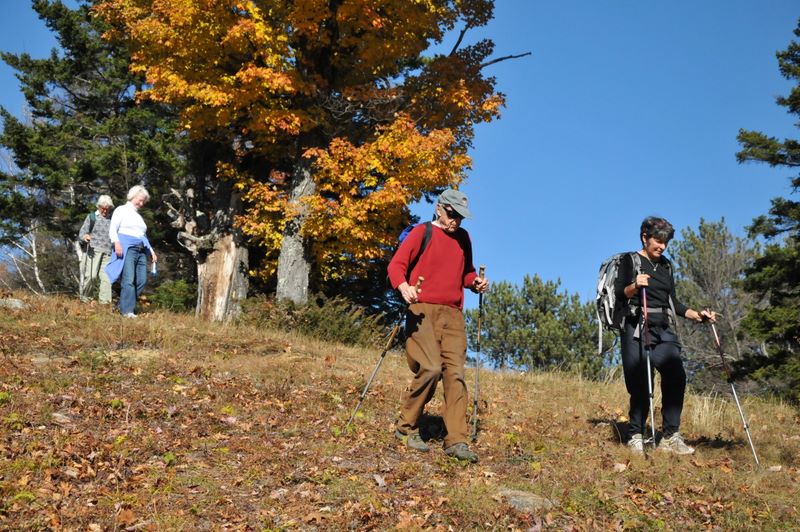
Descending the ski slopes
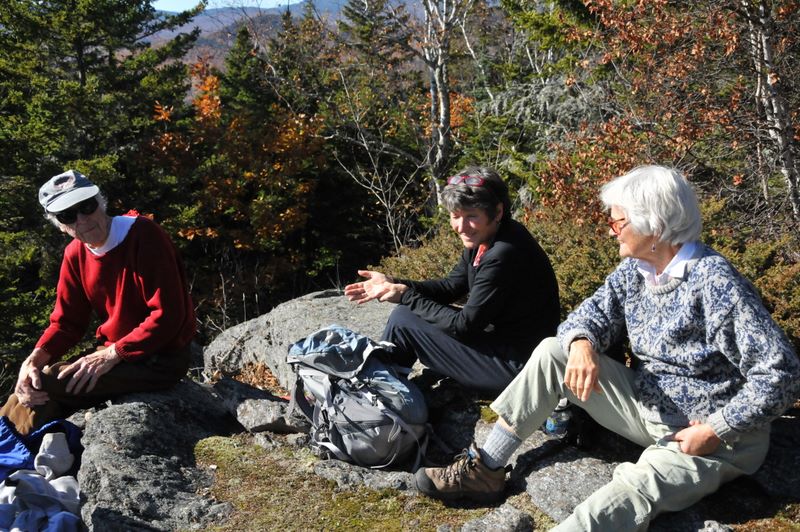
Mom, Sarah and John on the Knoll
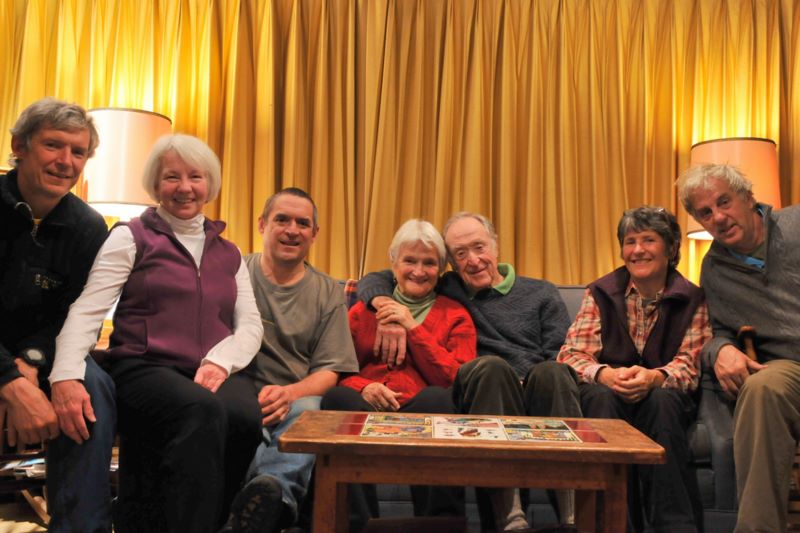
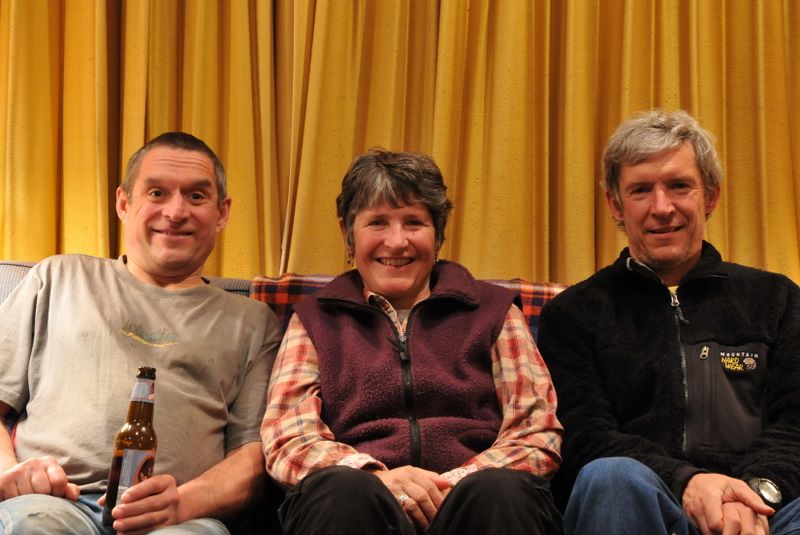
10/28/2009 Boston Rain, 53
The plane was nearly empty; fewer than 50 passengers were on the Jetblue flight to Seattle. That works out to not even one passenger on each side of the aisle per row. The flight attendants said that this evening's flight was an anomaly; usually the plane is reasonably full. I hope so; I like that flight and would hate to see it cancelled.
The plane was nearly empty; fewer than 50 passengers were on the Jetblue flight to Seattle. That works out to not even one passenger on each side of the aisle per row. The flight attendants said that this evening's flight was an anomaly; usually the plane is reasonably full. I hope so; I like that flight and would hate to see it cancelled.
10/30/2009 Rain, 59
Two days we've been back, and what have I accomplished? Well, this evening I cooked fried potatoes, kale and fried onions/carrots/red pepper w/ marjoram, and heated up some creamy tomato soup from Costco for supper for the two of us.
Yesterday for lunch I baked winter squash and opened a jar of big beans and a jar of Shirley's canned tomatoes and mixed them all together with a few capers. For supper Susan and I drove over to UPS and took David and Daniel out to Ferelli's Pizza. I didn't want to go and carped at Susan about it for a while as we drove over but I ended up enjoying the time with the boys. She didn't end up going over again today, so it was good that we went last night. I should have kept my mouth shut.
I also ran 9 miles, 4 in #5 (black GTS7s) shoes with a red insole in the left shoe and 5 in #6 (white GTS7s) shoes with a blue insole in the left shoe. My latest theory is that overpronation is causing my anterior tibialis tendinosis so I'm trying two options for more support for that foot. The red insole is more supportive (and less comfortable) than the blue, so I'm going to work up my mileage with the blue one first. If the insoles don't work I'll try the doctors Jonathan Bernard recommended to me, Mauer and Vincent in Kirkland.
Two days we've been back, and what have I accomplished? Well, this evening I cooked fried potatoes, kale and fried onions/carrots/red pepper w/ marjoram, and heated up some creamy tomato soup from Costco for supper for the two of us.
Yesterday for lunch I baked winter squash and opened a jar of big beans and a jar of Shirley's canned tomatoes and mixed them all together with a few capers. For supper Susan and I drove over to UPS and took David and Daniel out to Ferelli's Pizza. I didn't want to go and carped at Susan about it for a while as we drove over but I ended up enjoying the time with the boys. She didn't end up going over again today, so it was good that we went last night. I should have kept my mouth shut.
I also ran 9 miles, 4 in #5 (black GTS7s) shoes with a red insole in the left shoe and 5 in #6 (white GTS7s) shoes with a blue insole in the left shoe. My latest theory is that overpronation is causing my anterior tibialis tendinosis so I'm trying two options for more support for that foot. The red insole is more supportive (and less comfortable) than the blue, so I'm going to work up my mileage with the blue one first. If the insoles don't work I'll try the doctors Jonathan Bernard recommended to me, Mauer and Vincent in Kirkland.
10/31/2009 Showers, 52
Today was the day I planned to run my first marathon since Boston - the Frightfest Marathon down in Rochester. It's a Bob Green race though someone named Kristina Salazar has apparently taken over as director. Monte is going down; most other Maniacs are headed north to Bellingham. After waffling back and forth for a while I decided this morning not to run it. I didn't want to leave Susan alone all Sabbath, and my left shin is a little sore, both the tibialis muscle and the base of my shin in front of my left ankle although the usual spot on the AT tendon doesn't seem to be the problem today. So no marathon today. I decided not to sign up for CIM but may go for Seattle, a decision I don't need to make for another couple of weeks.
When I saw that Susan was sleeping in, I thought maybe I would go to church over at North Hill but as I started to get ready a strong feeling that I didn't want to go came over me. I thought about how I'd probably feel out of place in Sabbath School class and how awkward I'd feel standing around in the lobby before and after the service, and would probably feel somewhat skeptical during the service too. Not sure where those feelings came from (probably not from the Lord) but I yielded to them and went for a run instead, 7+ miles using the blue insole in my left shoe. I tried to run with a chi sort of style, minimizing heel striking and toe pushing-off in order to reduce strain on the AT muscle and tendon but I had occasional twinges in my shin nonetheless.
On this site I modified the login page to save login info to a cookie so that when I navigate to the home page for the first time in a session, I'm automatically logged in. Leaving the automatic login box unchecked deletes the cookie. I've been thinking about doing that on the Maniacs site for years; turns out it's much easier than I thought. Then today I did my first image map, on the view from Boott Spur linked from the Mt Washington hike on 10/21. That too was straightforward. I'm having some difficulty getting motivated to work on the HalfFanatics pages though; maybe the structure of "going to school" will help.
Today was the day I planned to run my first marathon since Boston - the Frightfest Marathon down in Rochester. It's a Bob Green race though someone named Kristina Salazar has apparently taken over as director. Monte is going down; most other Maniacs are headed north to Bellingham. After waffling back and forth for a while I decided this morning not to run it. I didn't want to leave Susan alone all Sabbath, and my left shin is a little sore, both the tibialis muscle and the base of my shin in front of my left ankle although the usual spot on the AT tendon doesn't seem to be the problem today. So no marathon today. I decided not to sign up for CIM but may go for Seattle, a decision I don't need to make for another couple of weeks.
When I saw that Susan was sleeping in, I thought maybe I would go to church over at North Hill but as I started to get ready a strong feeling that I didn't want to go came over me. I thought about how I'd probably feel out of place in Sabbath School class and how awkward I'd feel standing around in the lobby before and after the service, and would probably feel somewhat skeptical during the service too. Not sure where those feelings came from (probably not from the Lord) but I yielded to them and went for a run instead, 7+ miles using the blue insole in my left shoe. I tried to run with a chi sort of style, minimizing heel striking and toe pushing-off in order to reduce strain on the AT muscle and tendon but I had occasional twinges in my shin nonetheless.
On this site I modified the login page to save login info to a cookie so that when I navigate to the home page for the first time in a session, I'm automatically logged in. Leaving the automatic login box unchecked deletes the cookie. I've been thinking about doing that on the Maniacs site for years; turns out it's much easier than I thought. Then today I did my first image map, on the view from Boott Spur linked from the Mt Washington hike on 10/21. That too was straightforward. I'm having some difficulty getting motivated to work on the HalfFanatics pages though; maybe the structure of "going to school" will help.
11/01/2009 Studebaker Creek Sunny, 50
Beautiful day, sunny and cool. The cottonwoods are turning yellow now, replacing the maples whose leaves have mostly fallen. I was planning to get started on the Half Fanatics profile page and go for a bike ride but Pat called around 9AM to say he was going out to Studebaker Creek with Dan Brown and did I want to come. Having never been there before, and curious also about what Dan might know about the closure of Lucas Creek, I decided to go. Apparently Weyerhauser has closed both Lucas Creek and Ceres Creek to agate hunting because of people digging in the streams. I drove down to Pat's, picked him up and continued down to exit 49 where we met Dan at the Shell station. We drove east on Hwy 504 to Toutle, south on Sightly Road then right on Canal Rd briefly, then left on Moore Rd to near its end where a gated logging road turns off to the left. I'd been there before, when the boys and I hiked up Hemlock Creek a few years ago. The gate was open now.
We followed Dan in across the railroad tracks, turned left then continued past two spur roads to the left. About two miles in we cut sharply back to the left on the third spur road, drove in about a third of a mile on a rocky track and parked. A trail leads through the woods on the left a short distance, maybe 50 yards, to diggings in a marshy area of young cottonwoods and brush. People have been digging there for several years and there are pits everywhere which are usually full of water but today were mostly merely muddy. Rough fragments of yellow to orange agate and some variously-colored jasper are abundant in a clay layer 1-3 feet or more below the surface. Most pieces of any size (occasionally 2-4", infrequently twice that) are filled with quartz of the same color, pretty un-distinctive stuff though nice pieces of banded agate with deeper color show up occasionally. In three hours, working a couple of the existing holes, I dug about 30 pounds of of agate and maybe 10 pounds of leaverite (as in "leave 'er right there"). I didn't see any sign of the creek; turns out it is about a half mile back to the SE, not far from where we turned left onto the third spur road.
On the way home I ate supper with Pat and Shirley. Afterwards they sent me off with 3 half-gallons of grape juice from their grapes and about 10 pounds of mostly ripe tomatoes from their garden. I kept awake on the drive back by shouting at myself and was hoarse when I got home.
Beautiful day, sunny and cool. The cottonwoods are turning yellow now, replacing the maples whose leaves have mostly fallen. I was planning to get started on the Half Fanatics profile page and go for a bike ride but Pat called around 9AM to say he was going out to Studebaker Creek with Dan Brown and did I want to come. Having never been there before, and curious also about what Dan might know about the closure of Lucas Creek, I decided to go. Apparently Weyerhauser has closed both Lucas Creek and Ceres Creek to agate hunting because of people digging in the streams. I drove down to Pat's, picked him up and continued down to exit 49 where we met Dan at the Shell station. We drove east on Hwy 504 to Toutle, south on Sightly Road then right on Canal Rd briefly, then left on Moore Rd to near its end where a gated logging road turns off to the left. I'd been there before, when the boys and I hiked up Hemlock Creek a few years ago. The gate was open now.
We followed Dan in across the railroad tracks, turned left then continued past two spur roads to the left. About two miles in we cut sharply back to the left on the third spur road, drove in about a third of a mile on a rocky track and parked. A trail leads through the woods on the left a short distance, maybe 50 yards, to diggings in a marshy area of young cottonwoods and brush. People have been digging there for several years and there are pits everywhere which are usually full of water but today were mostly merely muddy. Rough fragments of yellow to orange agate and some variously-colored jasper are abundant in a clay layer 1-3 feet or more below the surface. Most pieces of any size (occasionally 2-4", infrequently twice that) are filled with quartz of the same color, pretty un-distinctive stuff though nice pieces of banded agate with deeper color show up occasionally. In three hours, working a couple of the existing holes, I dug about 30 pounds of of agate and maybe 10 pounds of leaverite (as in "leave 'er right there"). I didn't see any sign of the creek; turns out it is about a half mile back to the SE, not far from where we turned left onto the third spur road.
On the way home I ate supper with Pat and Shirley. Afterwards they sent me off with 3 half-gallons of grape juice from their grapes and about 10 pounds of mostly ripe tomatoes from their garden. I kept awake on the drive back by shouting at myself and was hoarse when I got home.
11/02/2009 Sunny early, rain late, 57
Voted, put away gear from rockhunting yesterday, went through the mail which came while we were in NH, put away clothes I've washed over the past month, paid online bills and checked our accounts, spent several hours deleting and filing email to get my Inbox down under one page again, and cooked red rice for lunch and kale from the garden for supper along with Salmon w/ Pineapple and Tomato Salsa using some of Pat and Shirley's tomatoes. I began the day planning to do a long run but didn't get out, then planned to ride but again didn't get out before the rain arrived so did no exercise. I ended the day planning to go to bed at 9:30 but as often happens, when I went downstairs to brush my teeth (neither of the upstairs bathrooms has a working sink) I sat down in the den to watch TV briefly (the last two innings of the fifth game of the World Series between the Yankees and the Phillies) and ended up staying up until midnight watching the movie "Away They Go" with Susan. She spent the whole day in the den watching TV, emerging only for meals.
Daniel called saying he'd received $300 in scholarship funds for the Intervarsity convention in Urbana but I've already bought plane tickets to fly to NH and told him I didn't want to change them. We had decided together a week ago that he wouldn't go to Urbana because he wouldn't be able to use much of what he learned about Christian leadership there since he will be in Spain for the next 6 months. Something he said, I forget now exactly what it was, reminded me of my own struggles with being a Christian. He told me that he hasn't had much of a Christian experience for the past year and a half, since his very spiritual summer in Alaska. He doubted now that he would ever go into Christian ministry so what he might learn in Urbana wouldn't be very relevant anyhow.. He sounded discouraged, tired. He's been going out blues dancing a night or two a week, basically staying up all night, and sometimes two nights in a row, so I can understand the fatigue. Discouragement with being a Christian I can relate to as well for I know I should walk with God but I do not.
Voted, put away gear from rockhunting yesterday, went through the mail which came while we were in NH, put away clothes I've washed over the past month, paid online bills and checked our accounts, spent several hours deleting and filing email to get my Inbox down under one page again, and cooked red rice for lunch and kale from the garden for supper along with Salmon w/ Pineapple and Tomato Salsa using some of Pat and Shirley's tomatoes. I began the day planning to do a long run but didn't get out, then planned to ride but again didn't get out before the rain arrived so did no exercise. I ended the day planning to go to bed at 9:30 but as often happens, when I went downstairs to brush my teeth (neither of the upstairs bathrooms has a working sink) I sat down in the den to watch TV briefly (the last two innings of the fifth game of the World Series between the Yankees and the Phillies) and ended up staying up until midnight watching the movie "Away They Go" with Susan. She spent the whole day in the den watching TV, emerging only for meals.
Daniel called saying he'd received $300 in scholarship funds for the Intervarsity convention in Urbana but I've already bought plane tickets to fly to NH and told him I didn't want to change them. We had decided together a week ago that he wouldn't go to Urbana because he wouldn't be able to use much of what he learned about Christian leadership there since he will be in Spain for the next 6 months. Something he said, I forget now exactly what it was, reminded me of my own struggles with being a Christian. He told me that he hasn't had much of a Christian experience for the past year and a half, since his very spiritual summer in Alaska. He doubted now that he would ever go into Christian ministry so what he might learn in Urbana wouldn't be very relevant anyhow.. He sounded discouraged, tired. He's been going out blues dancing a night or two a week, basically staying up all night, and sometimes two nights in a row, so I can understand the fatigue. Discouragement with being a Christian I can relate to as well for I know I should walk with God but I do not.
11/03/2009 Fog and stratus in AM, sun later, 50
Tweaked the login page to get it to display correctly in both Firefox and IE8 by adjusting width and padding of div's and span's, then composed an email to Brian Lewis to clarify our objectives in our legal action against Washington University regarding the boys' inheritance from Betty.
I finally got out for a run around midday. I drove over to the Cedar River trail, parked two miles below Landsberg and ran up and back, then down to the Lake Wilderness trail and back, then back down to the LW trail and 2.3 miles up it and back. Total about 21 miles. Felt slow and somewhat tired during most of the run, with some gas and 3 potty stops. I used the red insole in the left #4 shoe for the first 10 miles, then the blue insole in the left #6 shoe for the remaining 11. Occasional hint of irritation in front of L ankle late in the run, along with some stiffness in hip flexors and upper hamstrings. The L shin irritation persisted after the run but the leg stiffness cleared up promptly. It doesn't feel like I'm fully recovered yet from the two hard half marathons back east, but it also felt as though I could have completed another 5 miles without too much discomfort.
Tweaked the login page to get it to display correctly in both Firefox and IE8 by adjusting width and padding of div's and span's, then composed an email to Brian Lewis to clarify our objectives in our legal action against Washington University regarding the boys' inheritance from Betty.
I finally got out for a run around midday. I drove over to the Cedar River trail, parked two miles below Landsberg and ran up and back, then down to the Lake Wilderness trail and back, then back down to the LW trail and 2.3 miles up it and back. Total about 21 miles. Felt slow and somewhat tired during most of the run, with some gas and 3 potty stops. I used the red insole in the left #4 shoe for the first 10 miles, then the blue insole in the left #6 shoe for the remaining 11. Occasional hint of irritation in front of L ankle late in the run, along with some stiffness in hip flexors and upper hamstrings. The L shin irritation persisted after the run but the leg stiffness cleared up promptly. It doesn't feel like I'm fully recovered yet from the two hard half marathons back east, but it also felt as though I could have completed another 5 miles without too much discomfort.
11/04/2009 Green Mt Fog and sun in AM, high clouds and sun later, low 60's
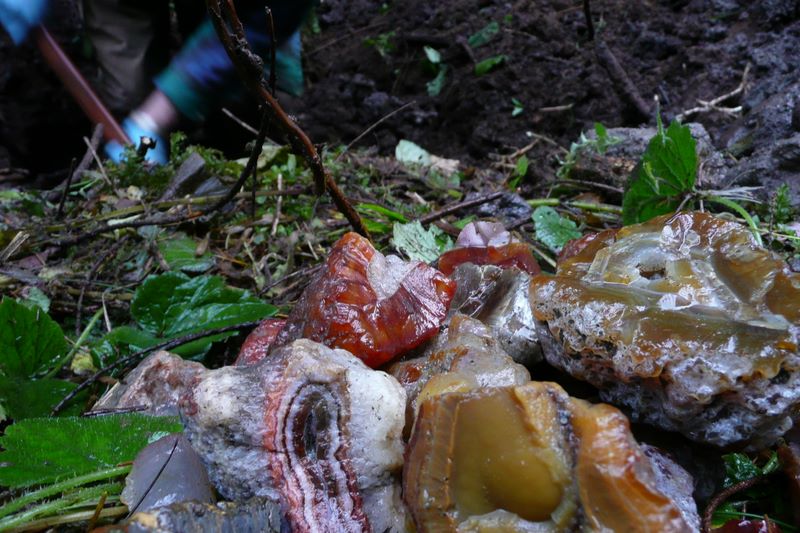
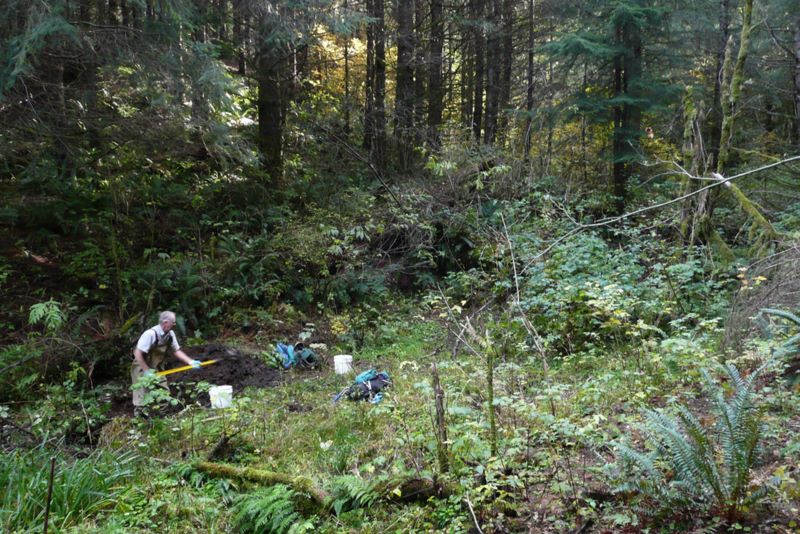 Pat and I drove down to Kalama and bicycled in to our digging area on Green Mountain from the gate
by the beaver marsh. I left our house at 7:15 and we were digging by 11. Pat chose a spot just
below where my hole was last time and I dug my hole about 30' above where his hole was last time.
We did about equally well; my spot may have been a little richer but was harder to dig. Though the
sun never rose quite high enough to reach us down in the hollow, the air was warm and I worked with
no shirt on until lunchtime.
Pat and I drove down to Kalama and bicycled in to our digging area on Green Mountain from the gate
by the beaver marsh. I left our house at 7:15 and we were digging by 11. Pat chose a spot just
below where my hole was last time and I dug my hole about 30' above where his hole was last time.
We did about equally well; my spot may have been a little richer but was harder to dig. Though the
sun never rose quite high enough to reach us down in the hollow, the air was warm and I worked with
no shirt on until lunchtime.
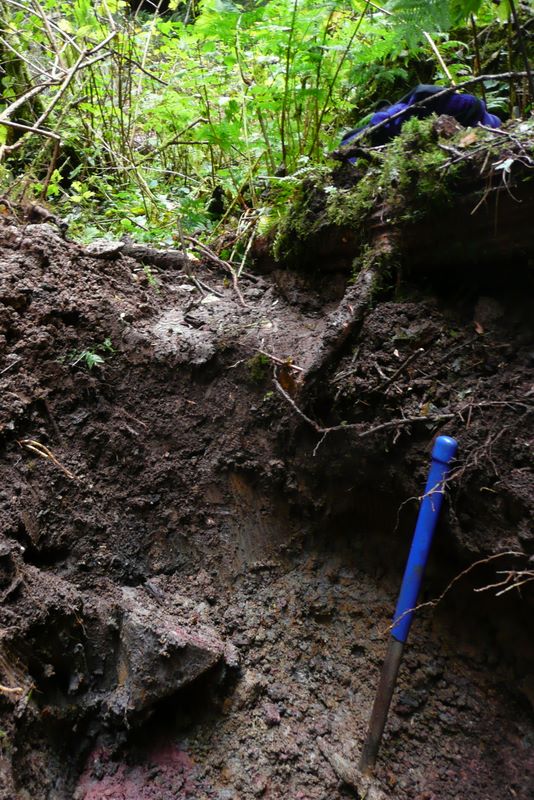 I dug down about 2' to the pink/orange ash then worked horizontally following a thin layer of rusty
yellowish gravel sandwiched between the ash below and a layer of miry gray and/or orange clay above.
Above the miry clay is about a foot of brown muddy clay and above that, about a 6" layer of
humus-rich soil. Most of the agate lies in the gravel layer though the miry clay contained some
agate as well as larger chunks of crystal, and agates are sometimes embedded in the pink ash. The
agates do not appear to have been worn by transport. Most of the smaller nodules are intact but the
larger ones are usually broken or at least chipped, and most of the crystal chunks appear to be
fragments of much larger geodes. Mingled with the agate are chunks of basalt. Rounded by
I dug down about 2' to the pink/orange ash then worked horizontally following a thin layer of rusty
yellowish gravel sandwiched between the ash below and a layer of miry gray and/or orange clay above.
Above the miry clay is about a foot of brown muddy clay and above that, about a 6" layer of
humus-rich soil. Most of the agate lies in the gravel layer though the miry clay contained some
agate as well as larger chunks of crystal, and agates are sometimes embedded in the pink ash. The
agates do not appear to have been worn by transport. Most of the smaller nodules are intact but the
larger ones are usually broken or at least chipped, and most of the crystal chunks appear to be
fragments of much larger geodes. Mingled with the agate are chunks of basalt. Rounded by
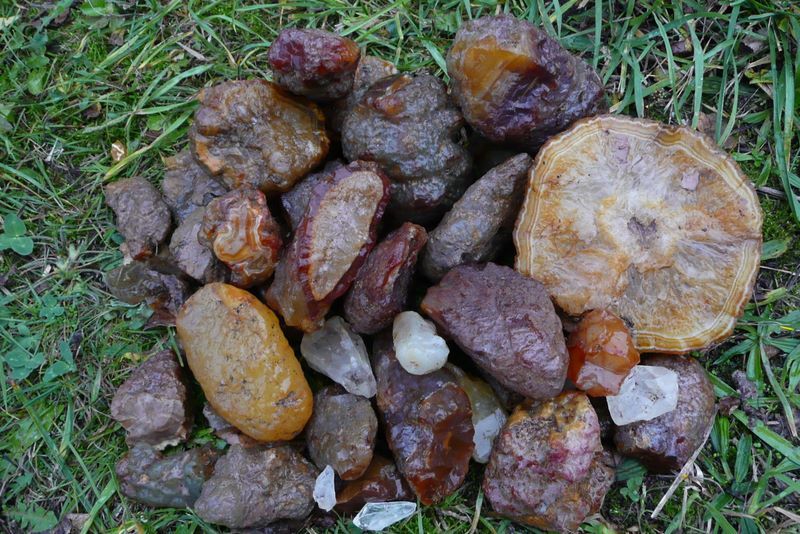 weathering, they occur at all levels from the pink ash up to near the surface and they range in size
from pebbles to boulders too heavy to move.
weathering, they occur at all levels from the pink ash up to near the surface and they range in size
from pebbles to boulders too heavy to move.
Pat and I both came home with maybe 15lbs of agate nodules including a couple good ones (3-4" diameter) each. Shirley fixed mashed potatoes and vegetables with chanterelle gravy and Pat opened a jar of his brother's smoked salmon, a fine combination. A nap during Jeopardy after supper enabled me to stay awake on the drive home.




Pat and I both came home with maybe 15lbs of agate nodules including a couple good ones (3-4" diameter) each. Shirley fixed mashed potatoes and vegetables with chanterelle gravy and Pat opened a jar of his brother's smoked salmon, a fine combination. A nap during Jeopardy after supper enabled me to stay awake on the drive home.
11/05/2009 Clouds surfing the south wind in AM, rain in PM, 56-48
Enjoyed a great morning ride in a stiff but warm southerly breeze with dramatic clouds overhead then did little the rest of the day, a consequence of too little sleep last night.
Enjoyed a great morning ride in a stiff but warm southerly breeze with dramatic clouds overhead then did little the rest of the day, a consequence of too little sleep last night.
11/06/2009 Rain, break, rain, 44-52
Ran during the break, including 5 miles barefoot on mostly dry pavement. The rain returned just 15 minutes after I finished running. In the morning I perused websites to get ideas on style and layout using the Wind River Range as a subject for my search. In so doing I ran across Peggy Abbott's ecotourism company Naturalist Journeys LLC. I "dated" her briefly the year after I graduated from college and haven't heard anything about her since - nice to see that she's done well.
Ran during the break, including 5 miles barefoot on mostly dry pavement. The rain returned just 15 minutes after I finished running. In the morning I perused websites to get ideas on style and layout using the Wind River Range as a subject for my search. In so doing I ran across Peggy Abbott's ecotourism company Naturalist Journeys LLC. I "dated" her briefly the year after I graduated from college and haven't heard anything about her since - nice to see that she's done well.
11/07/2009 Westport Showers, low 50's
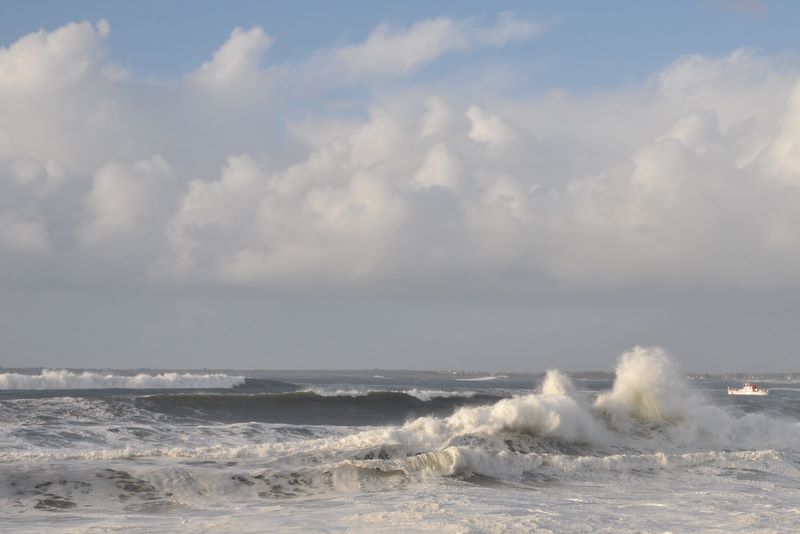 David, Nick and I drove down to Westport today to see the surf. The NOAA online weather site warned
of swells 25-30' high last night along the Oregon and Washington coasts, diminishing to about 20' by
Sunday afternoon. We decided on Westport after considering Cape Disappointment where the waves
would have been larger, but we left too late and weren't really up for that long a drive anyhow.
The waves at Westport, having already crossed the bar and entered the bay, were no longer 25' high
but they were still impressive. As we drove up they were crashing over the breakwater and sending
sheets of foamy water flooding down the streets.
David, Nick and I drove down to Westport today to see the surf. The NOAA online weather site warned
of swells 25-30' high last night along the Oregon and Washington coasts, diminishing to about 20' by
Sunday afternoon. We decided on Westport after considering Cape Disappointment where the waves
would have been larger, but we left too late and weren't really up for that long a drive anyhow.
The waves at Westport, having already crossed the bar and entered the bay, were no longer 25' high
but they were still impressive. As we drove up they were crashing over the breakwater and sending
sheets of foamy water flooding down the streets.
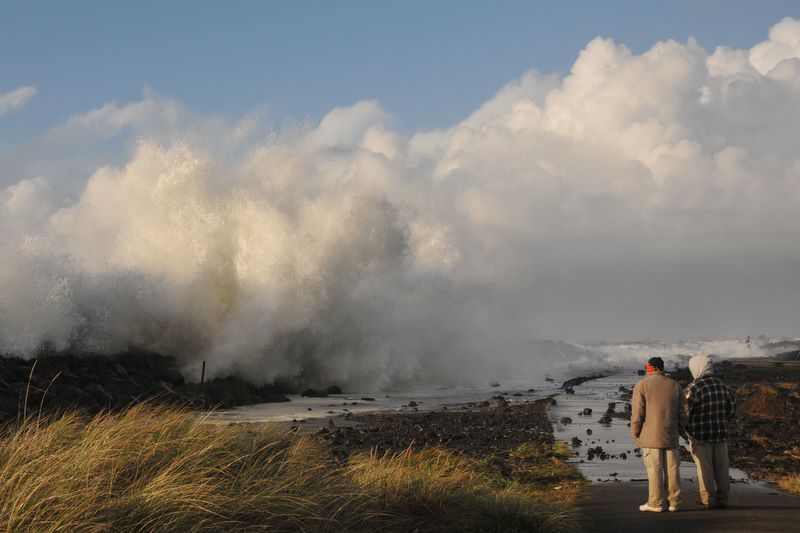 The breakwater is a wall of dark basalt boulders 2-4' in diameter piled up about 8' high all along
the north end of town and east around the point over to the marina. A paved walkway runs parallel
to the breakwater west about a quarter mile from a viewing tower out to a long sandy beach. The
path is separated from the breakwater by a low ridge of dune grass as it approaches the beach but in
town only a flat area of sand and rubble lies between the breakwater and the tower, which in turn
stands at the north end of the main street along the big marina fronting the town. We parked near
the breakwater one or two streets west of the tower, perhaps not the best choice since within 15
minutes after we arrived our car was standing in a shallow lake of salt water. Fortunately that
drained mostly away by the time we wanted to get back to the car.
The breakwater is a wall of dark basalt boulders 2-4' in diameter piled up about 8' high all along
the north end of town and east around the point over to the marina. A paved walkway runs parallel
to the breakwater west about a quarter mile from a viewing tower out to a long sandy beach. The
path is separated from the breakwater by a low ridge of dune grass as it approaches the beach but in
town only a flat area of sand and rubble lies between the breakwater and the tower, which in turn
stands at the north end of the main street along the big marina fronting the town. We parked near
the breakwater one or two streets west of the tower, perhaps not the best choice since within 15
minutes after we arrived our car was standing in a shallow lake of salt water. Fortunately that
drained mostly away by the time we wanted to get back to the car.
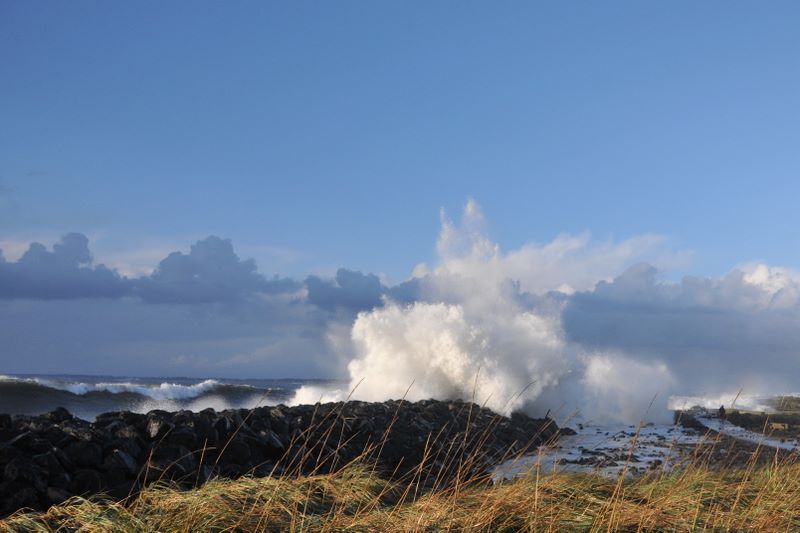
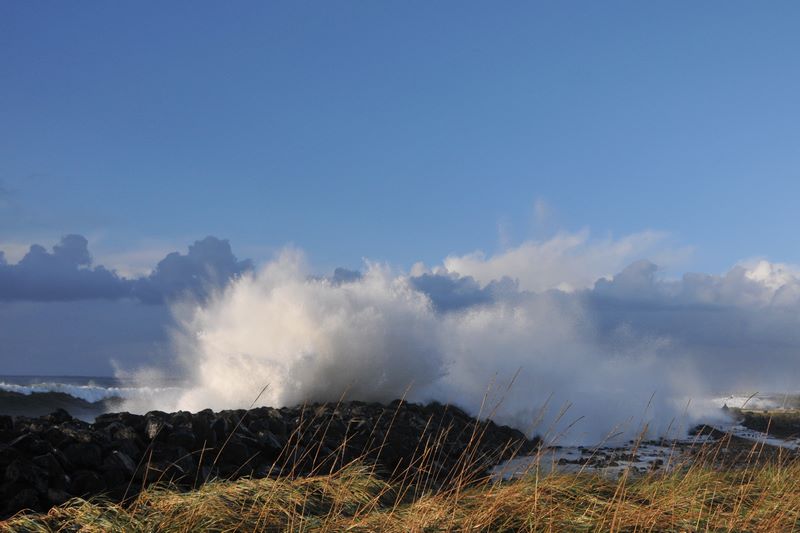
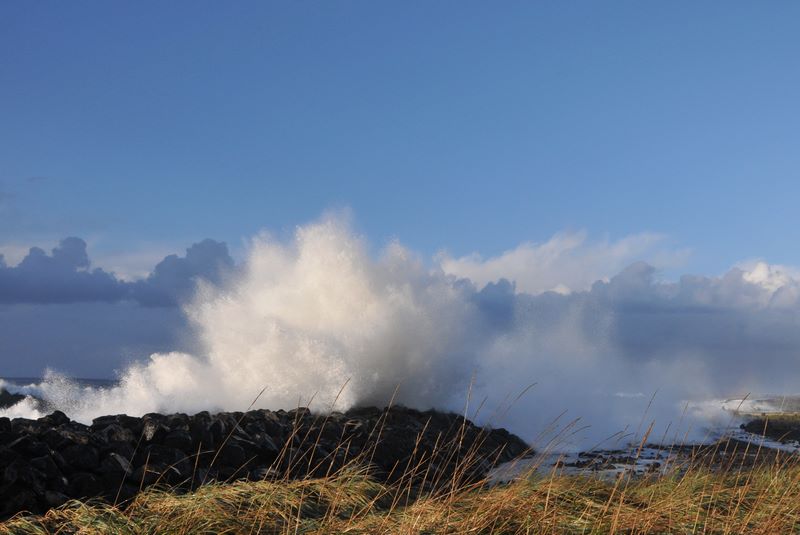
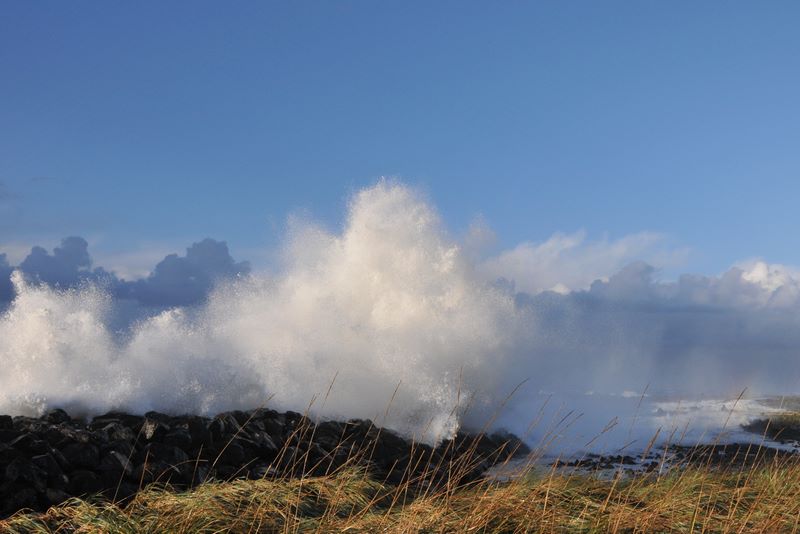 Note the person on the path at the far right side of the above series of photos.
Note the person on the path at the far right side of the above series of photos.
We hiked up onto the dune grass hill to where we could see over the breakwater and marvel at the big breakers rolling in. We were thrilled by the sound and sight of the huge waves and by the prospect that every now and then one of them would blast a flood of salt spray over the wall and onto the hill where we stood. The waves to watch for were those that waited to break until they were just on the other side of the wall from us. We managed to elude a soaking but we watched several nearby spectators get doused, even down on the path.
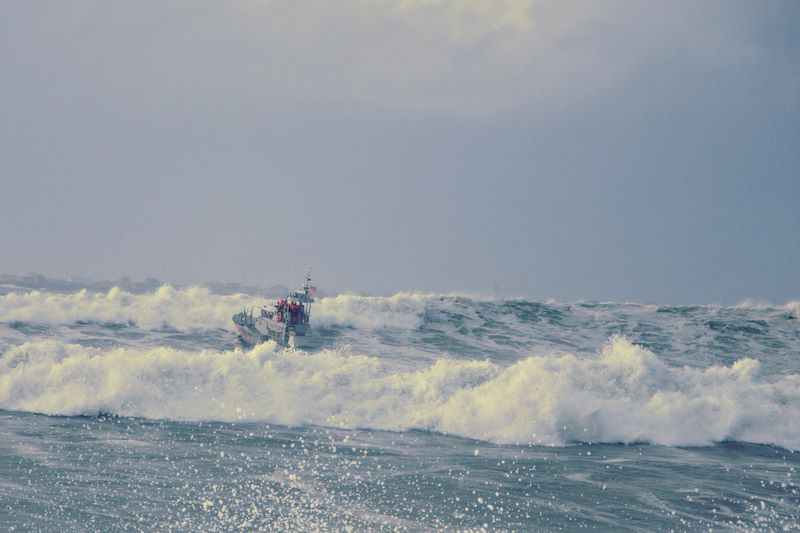 The big ones came in sets of three or four alternating with half a dozen smaller swells. Sometimes
the larger waves would all break while they were still a quarter mile or more from shore, walls of
tumbling white water six or eight feet high on top of parallel ridges of gray-green water. By
comparing the waves with a couple of Coast Guard boats practicing rough water techniques offshore we
estimated the larger waves to be at least 15' high, over the heads of the crewmembers crowded on the
superstructure of their boats 10' or more above the water. Several times we lost sight of the boats
entirely when they dropped into troughs between the waves. They were big boats too, maybe as much
as 50' long and 20' tall. They took most of the waves head on and would rear up at a 30-40 degree
angle off the crest of a breaking wave before crashing down on the back side. As the waves
approached the wall of boulders they would mount up into a concave wall of foamy water almost high
enough to obscure the horizon before crashing down with a rumbling roar that seemed to reverberate
inside us.
The big ones came in sets of three or four alternating with half a dozen smaller swells. Sometimes
the larger waves would all break while they were still a quarter mile or more from shore, walls of
tumbling white water six or eight feet high on top of parallel ridges of gray-green water. By
comparing the waves with a couple of Coast Guard boats practicing rough water techniques offshore we
estimated the larger waves to be at least 15' high, over the heads of the crewmembers crowded on the
superstructure of their boats 10' or more above the water. Several times we lost sight of the boats
entirely when they dropped into troughs between the waves. They were big boats too, maybe as much
as 50' long and 20' tall. They took most of the waves head on and would rear up at a 30-40 degree
angle off the crest of a breaking wave before crashing down on the back side. As the waves
approached the wall of boulders they would mount up into a concave wall of foamy water almost high
enough to obscure the horizon before crashing down with a rumbling roar that seemed to reverberate
inside us.
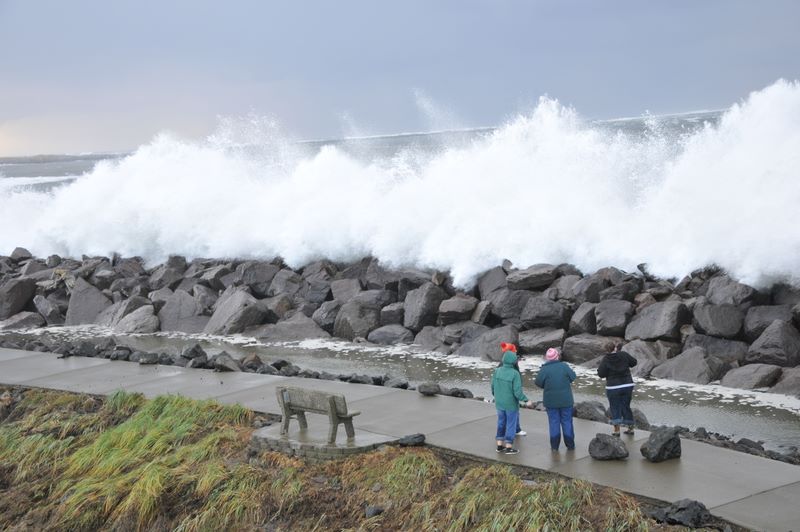
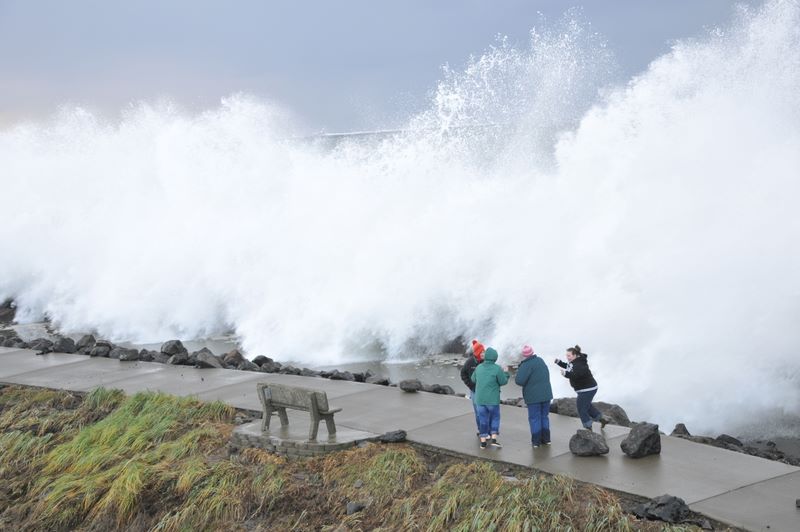
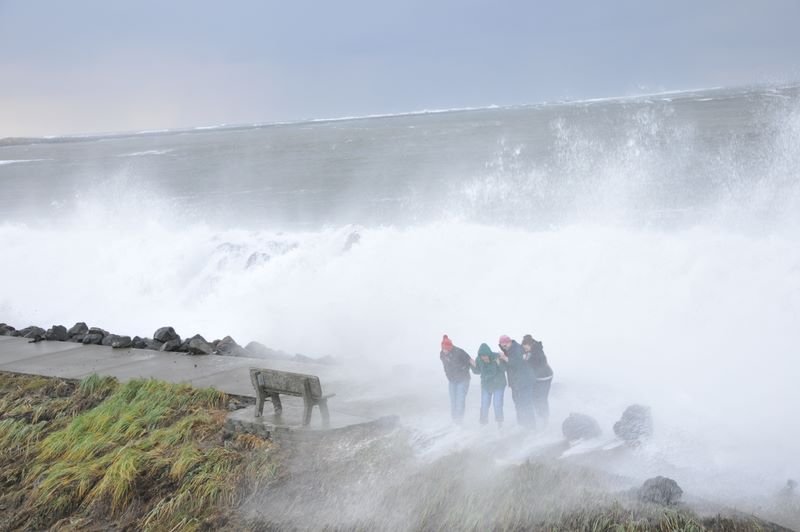 David and I tried to take pictures without getting too much salt spray on our cameras. The trick
was to wait for the spray from the last wave to blow past, then pull the camera out from the folds
of our rain gear, snap a quick picture or two then tuck the camera away again just ahead of the
shower of spray from the next wave. Hopefully during those few seconds that wave would be putting
on a good show. The waves were coming in at a bit of an angle so the blast of whitewater and spray
would start near the tower and explode progressively up the breakwater towards where we stood.
David and I tried to take pictures without getting too much salt spray on our cameras. The trick
was to wait for the spray from the last wave to blow past, then pull the camera out from the folds
of our rain gear, snap a quick picture or two then tuck the camera away again just ahead of the
shower of spray from the next wave. Hopefully during those few seconds that wave would be putting
on a good show. The waves were coming in at a bit of an angle so the blast of whitewater and spray
would start near the tower and explode progressively up the breakwater towards where we stood.
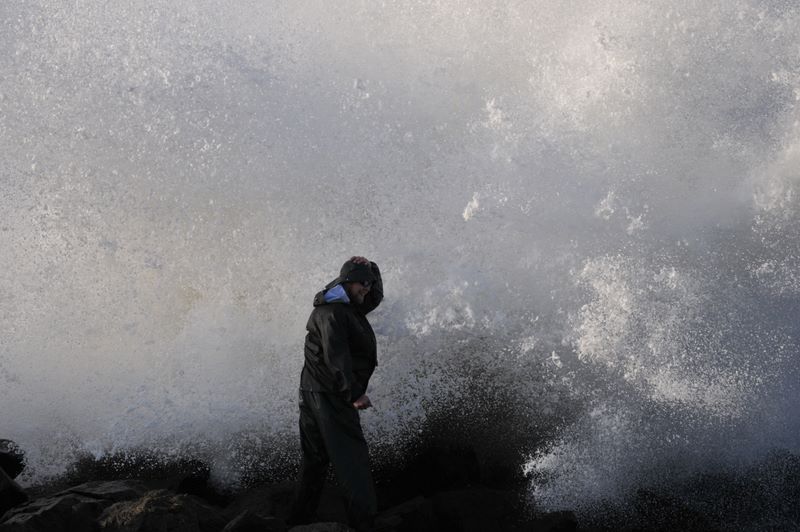
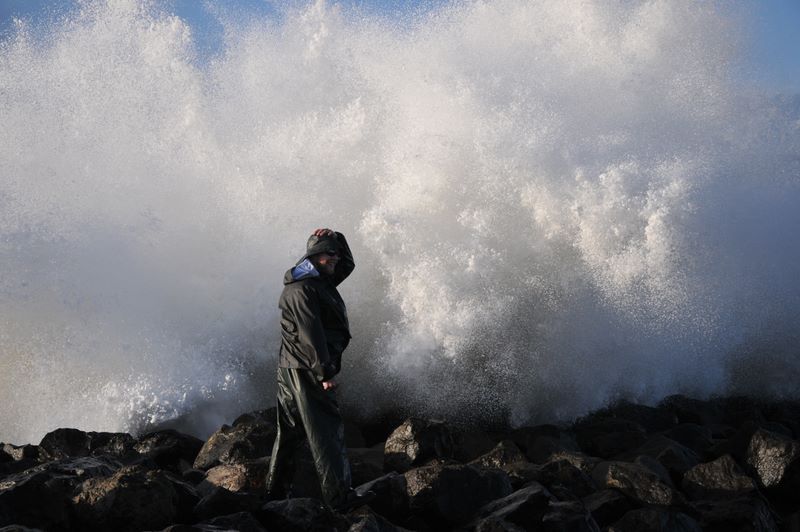
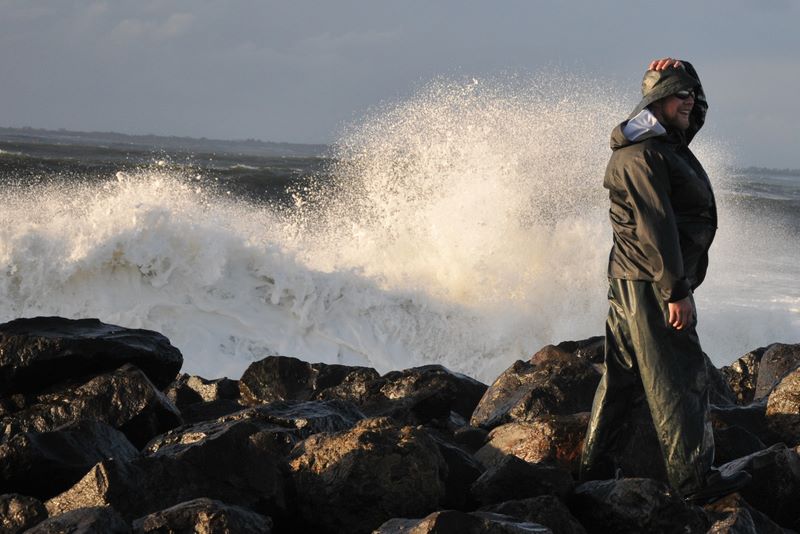 One man, from Enumclaw it turned out, climbed up on top of the breakwater for a better view and
braved several showers of spray from smaller waves before a big one came and thrust up a wall of
white spray perhaps 20' tall behind him. I snapped a couple of photos then sprinted down the hill.
When I turned around, he was gone. That was spooky. A few moments later he crawled up out of the
ditch between the breakwater and the dune grass hill I'd been standing on. He was fortunate to get
One man, from Enumclaw it turned out, climbed up on top of the breakwater for a better view and
braved several showers of spray from smaller waves before a big one came and thrust up a wall of
white spray perhaps 20' tall behind him. I snapped a couple of photos then sprinted down the hill.
When I turned around, he was gone. That was spooky. A few moments later he crawled up out of the
ditch between the breakwater and the dune grass hill I'd been standing on. He was fortunate to get
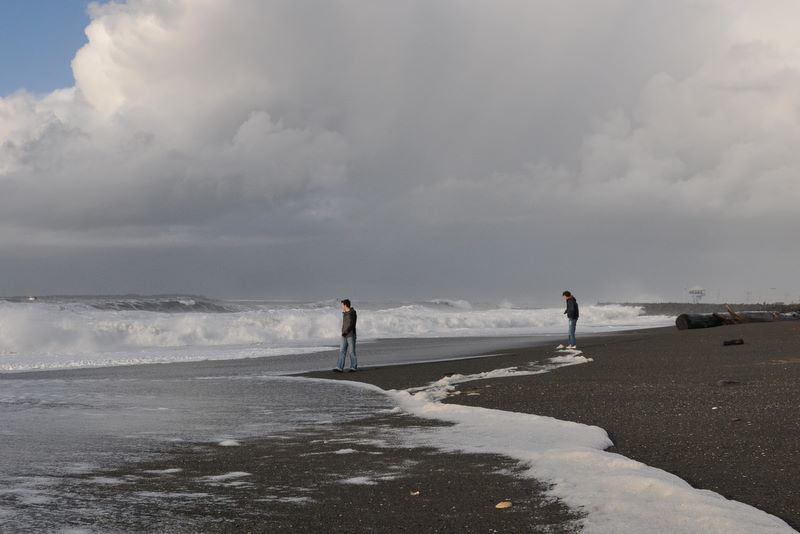 away with just a bump on his forehead, considering he fell six feet or more onto rough boulders when
the wave swept him off the wall.
away with just a bump on his forehead, considering he fell six feet or more onto rough boulders when
the wave swept him off the wall.
We ate an early supper at Los Arcos on the cross street by the supermarket where the patrol car is parked with a dummy officer, complete with sunglasses, inside. The relleno was oily and the burrito not much better - for the most part not nearly as good as I remembered from last summer though the pico de gallo was perhaps the best I've ever tasted. I kept awake by listening to Replay during the long, dark and wet drive home.






We hiked up onto the dune grass hill to where we could see over the breakwater and marvel at the big breakers rolling in. We were thrilled by the sound and sight of the huge waves and by the prospect that every now and then one of them would blast a flood of salt spray over the wall and onto the hill where we stood. The waves to watch for were those that waited to break until they were just on the other side of the wall from us. We managed to elude a soaking but we watched several nearby spectators get doused, even down on the path.








David and Nick on the beach
We ate an early supper at Los Arcos on the cross street by the supermarket where the patrol car is parked with a dummy officer, complete with sunglasses, inside. The relleno was oily and the burrito not much better - for the most part not nearly as good as I remembered from last summer though the pico de gallo was perhaps the best I've ever tasted. I kept awake by listening to Replay during the long, dark and wet drive home.
11/09/2009 Black-tailed Gull Showers, low 50's
After tying my brain in knots for most of the morning trying to get my divs and spans to work the way I want them to on the Half Fanatics pages (finally working on the new Profile page), I decided to take the canoe over to Tacoma and see if I could find the Black-tailed Gull. It's been roosting with a big flock of other gulls, mostly Mew and Bonaparte's with a few California, Glaucous-winged and Western gulls thrown in, on a log boom off Marine Shore Drive at the NE 5000 block, about 0.3 miles SE of the Tyee Marina. I spent the last hour or two of daylight after delivering the boys back to school yesterday afternoon scoping the gull flock but was unable to pick it out. Today I had more success with the bird, though not so much with the canoe.
A birder from northern California, Gary Bloomfield, already had the bird in his scope and graciously shared his view with me. Not great light but I was able to see the black tail, the gray mantle slightly darker than the adjacent Mew Gulls, the dark wingtips with small terminal white spots on the last few primaries, the yellowish legs and whitish head with dusky streaked nape. Only the black tail decisively distinguished our target from the similar-sized California Gulls nearby. At our distance we couldn't quite make out the pale eye or the red and black on the tip of the bill. The slightly darker mantle and the reduced white in the wingtips would also distinguish the Black-tailed from an adult California, but a 3rd cycle California has variable terminal black on the tail and minimal white in the wingtips. However, the gull we saw had a broad subterminal black band across the tail and much less contrast between the black wingtips and the gray wings than would be shown by a 3rd cycle California Gull. So despite Gary's questions, I think we saw the Black-tailed.
Having not used the canoe in a few years I felt quite adventurous taking it out today, particularly since a brisk southwest breeze made conditions a bit challenging. Gary helped me get it down the bank and I set out to try for a closer look at the gull. I found it difficult to turn the canoe into the wind from my solo paddling position kneeling in the center of the boat; I realized later that I should have been kneeling in front of rather than behind the center thwart. Once I rounded the corner of the log boom I was exposed to the incoming chop which, though barely noticeable from shore, was high enough to come within an inch or two of the gunwales. The wind was stronger too and the only way I was able to make upwind progress was to turn around and paddle backwards. It was, of course, difficult to watch the gulls when my back was towards them, and in any case the canoe was too unstable to permit studying the gulls for more than a second or two at a time. I couldn't even think about getting out my camera; the moment I stopped paddling the canoe would swing around and begin drifting swiftly away from the log boom. Tacking backwards back and forth near the gulls I wasn't able to spot the Black-tailed Gull until I inadvertently swung too close and flushed them. I did see it then, had a clear view of its back and tail in flight. Small white terminal spots on outer primaries, broad band of black in the tail, minimal contrast between wingtips and mantle. I still didn't get a good look at the eye and bill though. I'd had enough and paddled back to shore; I'll try again on a calmer day. Maybe tomorrow morning.
After tying my brain in knots for most of the morning trying to get my divs and spans to work the way I want them to on the Half Fanatics pages (finally working on the new Profile page), I decided to take the canoe over to Tacoma and see if I could find the Black-tailed Gull. It's been roosting with a big flock of other gulls, mostly Mew and Bonaparte's with a few California, Glaucous-winged and Western gulls thrown in, on a log boom off Marine Shore Drive at the NE 5000 block, about 0.3 miles SE of the Tyee Marina. I spent the last hour or two of daylight after delivering the boys back to school yesterday afternoon scoping the gull flock but was unable to pick it out. Today I had more success with the bird, though not so much with the canoe.
A birder from northern California, Gary Bloomfield, already had the bird in his scope and graciously shared his view with me. Not great light but I was able to see the black tail, the gray mantle slightly darker than the adjacent Mew Gulls, the dark wingtips with small terminal white spots on the last few primaries, the yellowish legs and whitish head with dusky streaked nape. Only the black tail decisively distinguished our target from the similar-sized California Gulls nearby. At our distance we couldn't quite make out the pale eye or the red and black on the tip of the bill. The slightly darker mantle and the reduced white in the wingtips would also distinguish the Black-tailed from an adult California, but a 3rd cycle California has variable terminal black on the tail and minimal white in the wingtips. However, the gull we saw had a broad subterminal black band across the tail and much less contrast between the black wingtips and the gray wings than would be shown by a 3rd cycle California Gull. So despite Gary's questions, I think we saw the Black-tailed.
Having not used the canoe in a few years I felt quite adventurous taking it out today, particularly since a brisk southwest breeze made conditions a bit challenging. Gary helped me get it down the bank and I set out to try for a closer look at the gull. I found it difficult to turn the canoe into the wind from my solo paddling position kneeling in the center of the boat; I realized later that I should have been kneeling in front of rather than behind the center thwart. Once I rounded the corner of the log boom I was exposed to the incoming chop which, though barely noticeable from shore, was high enough to come within an inch or two of the gunwales. The wind was stronger too and the only way I was able to make upwind progress was to turn around and paddle backwards. It was, of course, difficult to watch the gulls when my back was towards them, and in any case the canoe was too unstable to permit studying the gulls for more than a second or two at a time. I couldn't even think about getting out my camera; the moment I stopped paddling the canoe would swing around and begin drifting swiftly away from the log boom. Tacking backwards back and forth near the gulls I wasn't able to spot the Black-tailed Gull until I inadvertently swung too close and flushed them. I did see it then, had a clear view of its back and tail in flight. Small white terminal spots on outer primaries, broad band of black in the tail, minimal contrast between wingtips and mantle. I still didn't get a good look at the eye and bill though. I'd had enough and paddled back to shore; I'll try again on a calmer day. Maybe tomorrow morning.
11/10/2009 Tacoma Increasing clouds, low 50's, calm - rain and wind later
 I left the canoe on top of the car to inspire me to drive back over to Tacoma in the morning, and so
it did. Conditions were nearly perfect for close-up inspection of the gulls on the logboom when I
arrived shortly after 8AM. No breeze at all ruffled the water and though the hazy gray stratus to
the west threatened rain, only a few sprinkles fell all morning. The cloud layer broke up a few
I left the canoe on top of the car to inspire me to drive back over to Tacoma in the morning, and so
it did. Conditions were nearly perfect for close-up inspection of the gulls on the logboom when I
arrived shortly after 8AM. No breeze at all ruffled the water and though the hazy gray stratus to
the west threatened rain, only a few sprinkles fell all morning. The cloud layer broke up a few
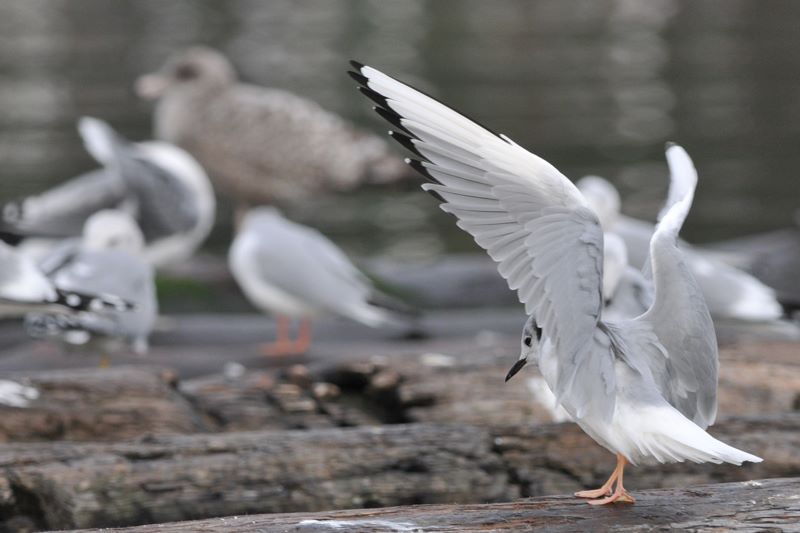
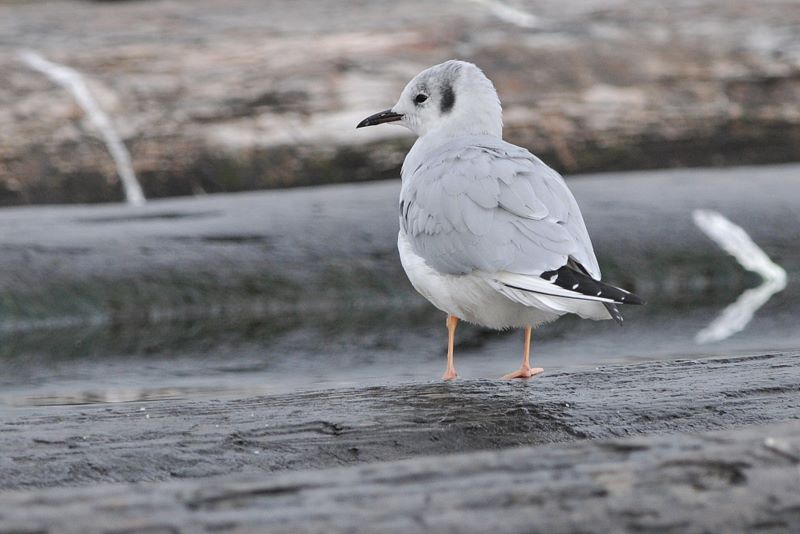 miles east of Tacoma and low winter sunshine cast a golden glow over the rusty cranes and ships on
the nearby waterfront and even slipped in under the clouds now and then to illuminate the birds. I
paddled and drifted around for several hours taking photographs and scanning the gull flock with
binoculars. The longer I studied the gulls the less certain I became of my identifications, but
I can say with certainty that the Black-tailed Gull wasn't around.
miles east of Tacoma and low winter sunshine cast a golden glow over the rusty cranes and ships on
the nearby waterfront and even slipped in under the clouds now and then to illuminate the birds. I
paddled and drifted around for several hours taking photographs and scanning the gull flock with
binoculars. The longer I studied the gulls the less certain I became of my identifications, but
I can say with certainty that the Black-tailed Gull wasn't around.
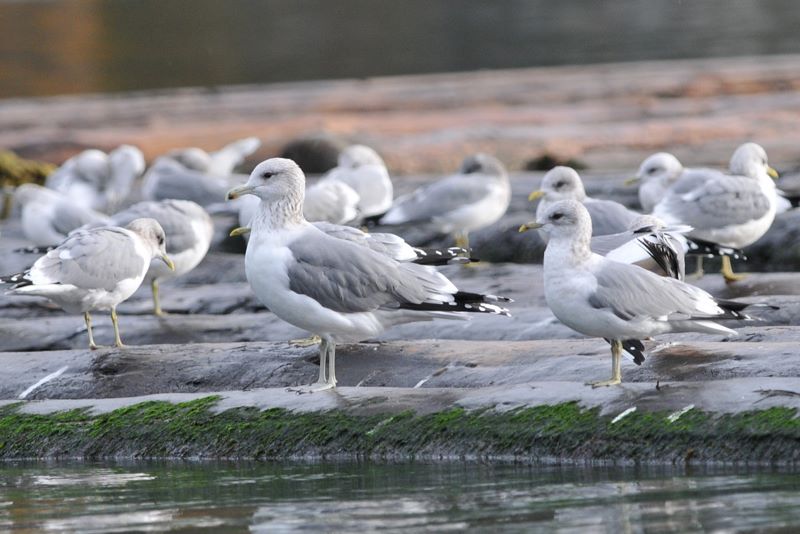
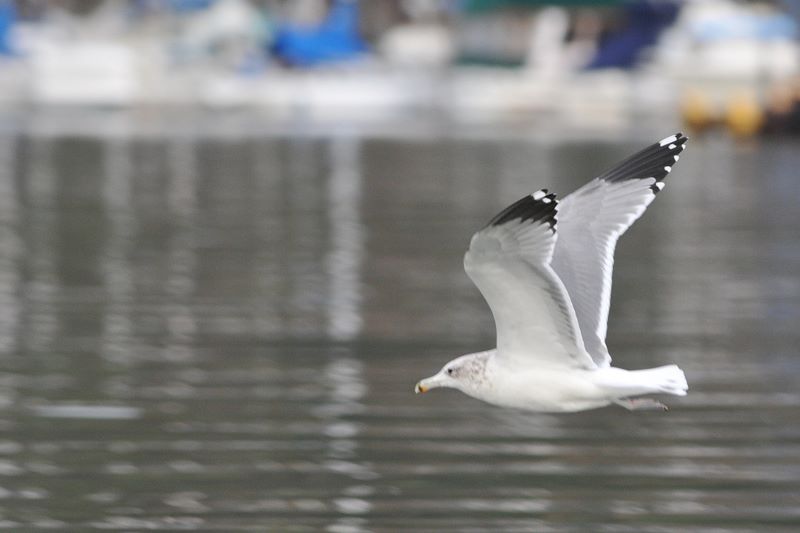
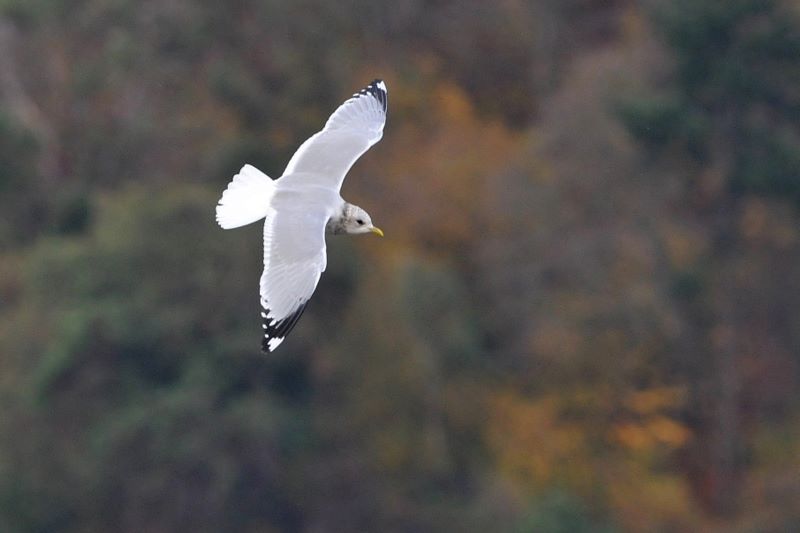 Bonaparte's and Mew Gulls made up the bulk of the gull flock, which overall was substantially smaller
than it had been the evening before. There were a handful of California Gulls present and a few
Glaucous-winged and hybrid pink-legged gulls but no Western's or other species. I scrutinized
every California and they all had either a dark eye or limited black on the bill or a white tail.
I did see several gulls with black on the tail but they were clearly smaller and the black was more
limited - most likely 2nd year Mew Gulls. Among the gulls and scattered elsewhere along the log booms
Bonaparte's and Mew Gulls made up the bulk of the gull flock, which overall was substantially smaller
than it had been the evening before. There were a handful of California Gulls present and a few
Glaucous-winged and hybrid pink-legged gulls but no Western's or other species. I scrutinized
every California and they all had either a dark eye or limited black on the bill or a white tail.
I did see several gulls with black on the tail but they were clearly smaller and the black was more
limited - most likely 2nd year Mew Gulls. Among the gulls and scattered elsewhere along the log booms
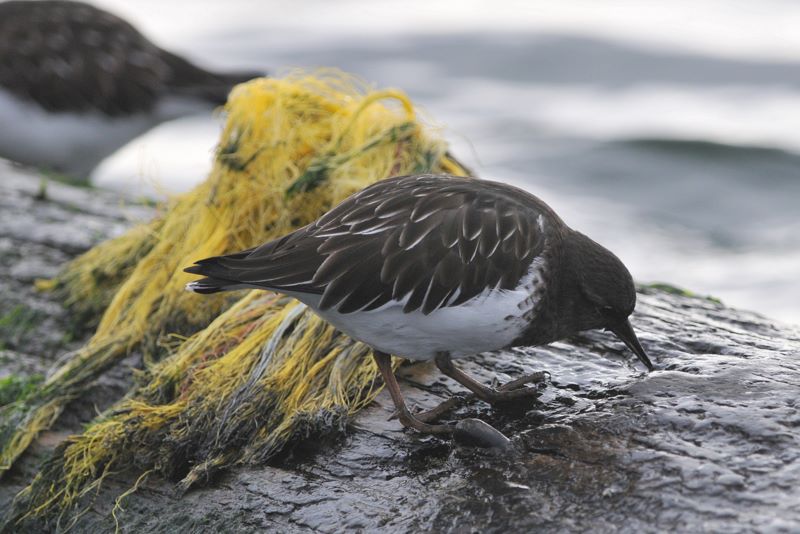
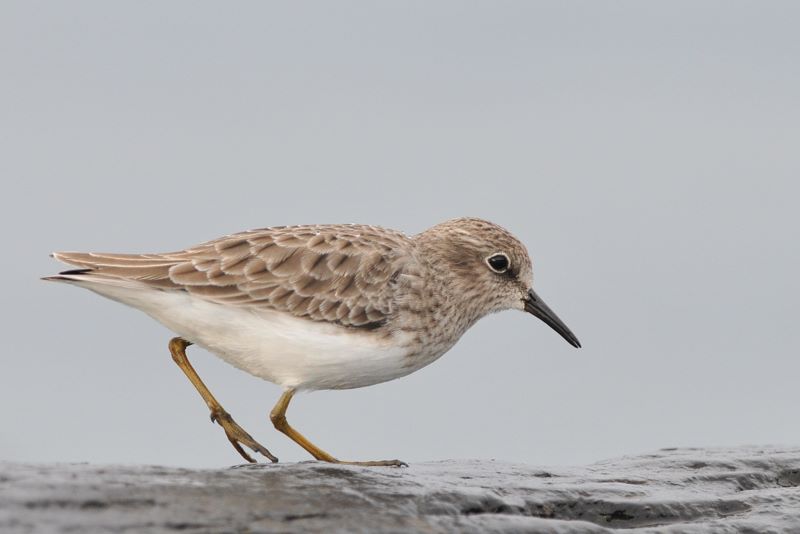 were half a dozen, maybe more, Black Turnstones and at least two Least Sandpipers. These were
less skittish than the gulls. By allowing the canoe to drift closer to them while I hunched down
were half a dozen, maybe more, Black Turnstones and at least two Least Sandpipers. These were
less skittish than the gulls. By allowing the canoe to drift closer to them while I hunched down
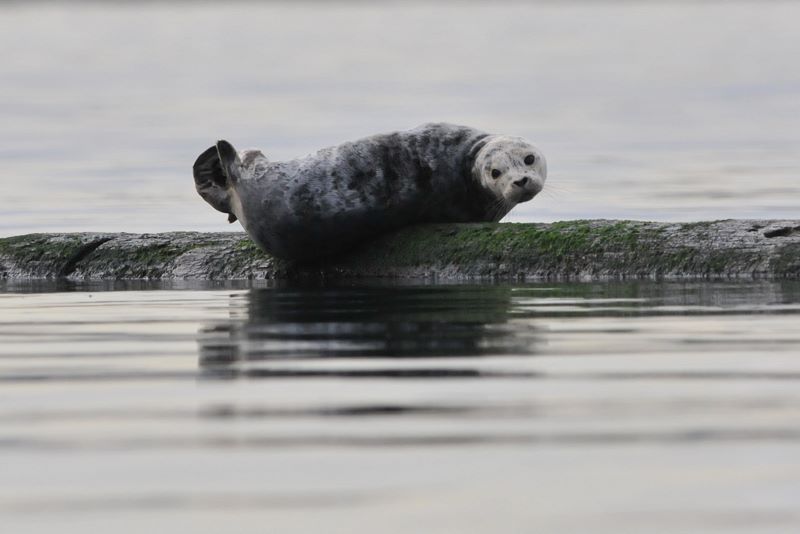 with the camera, I was able to get some pretty good closeup shots, along with photos of a nearby
Harbor Seal. I also tried for a few gulls in flight - they're identifiable, if not particularly sharp.
Light conditions were barely sufficient for ISO 500 without VR; only about one shot in ten was completely
free of motion blur but I nonetheless kept probably a quarter of the photos I took.
with the camera, I was able to get some pretty good closeup shots, along with photos of a nearby
Harbor Seal. I also tried for a few gulls in flight - they're identifiable, if not particularly sharp.
Light conditions were barely sufficient for ISO 500 without VR; only about one shot in ten was completely
free of motion blur but I nonetheless kept probably a quarter of the photos I took.


Bonaparte's Gull

Bonaparte's Gull

California and Mew Gulls

California Gull

Mew Gull

Black Turnstone

Least Sandpiper

Harbor Seal
11/11/2009 Veteran's Day Half Partly sunny, high 40's
Drove up to Bothell for Adrian Call's Veteran's Day Half Marathon. He had a pretty good crowd including a number of Maniacs I haven't seen in a while - Monte, Prez, Ray, Marie, Jill, Francesca, Linda B, Mare P, and of course, Adrian. I ran hard despite never feeling particularly strong and was pretty sore afterwards in unexpected places - L knee, R glutes, mid-calves. Some irritation in the front of my lower L shin too, as usual. I finished in 6th place behind Prez and James Duggan (a relatively new Half Fanatic who ran a PR today). Ray's been doing speedwork and ran 1:50 and change today, close to a 6-minute PR. I ran with him for the first 5 miles at about an 8 minute pace so he must have slowed somewhat in the second half. I finished in 1:43:30 with an average HR of 172. My second half was almost 2 minutes faster than my first and it felt like it too; I couldn't quite maintain my pace for the last couple of miles. Based on my GPS the course was a bit short so for comparison with the halves I ran last month my time was probably close to 1:45. It was a beautiful run. Fog lay blue on the fields as we ran out to the turnaround and cottonwoods, washed clean by the rain overnight, lined the trail all tall and misty yellow in the morning sunshine during our run back to the finish.
I listened to Deloris Claiborne by Stephen King on the drive up and back. The story is narrated entirely in the first person in a very authentic-sounding Maine accent with lots of local color. This was my second time through that book and it had me close to tears several times; I don't remember having such an emotional response the first time I listened to it. Definitely one to share with Susan and the boys on our next long trip together.
Drove up to Bothell for Adrian Call's Veteran's Day Half Marathon. He had a pretty good crowd including a number of Maniacs I haven't seen in a while - Monte, Prez, Ray, Marie, Jill, Francesca, Linda B, Mare P, and of course, Adrian. I ran hard despite never feeling particularly strong and was pretty sore afterwards in unexpected places - L knee, R glutes, mid-calves. Some irritation in the front of my lower L shin too, as usual. I finished in 6th place behind Prez and James Duggan (a relatively new Half Fanatic who ran a PR today). Ray's been doing speedwork and ran 1:50 and change today, close to a 6-minute PR. I ran with him for the first 5 miles at about an 8 minute pace so he must have slowed somewhat in the second half. I finished in 1:43:30 with an average HR of 172. My second half was almost 2 minutes faster than my first and it felt like it too; I couldn't quite maintain my pace for the last couple of miles. Based on my GPS the course was a bit short so for comparison with the halves I ran last month my time was probably close to 1:45. It was a beautiful run. Fog lay blue on the fields as we ran out to the turnaround and cottonwoods, washed clean by the rain overnight, lined the trail all tall and misty yellow in the morning sunshine during our run back to the finish.
I listened to Deloris Claiborne by Stephen King on the drive up and back. The story is narrated entirely in the first person in a very authentic-sounding Maine accent with lots of local color. This was my second time through that book and it had me close to tears several times; I don't remember having such an emotional response the first time I listened to it. Definitely one to share with Susan and the boys on our next long trip together.
11/12/2009 Mostly sunny, high 40's
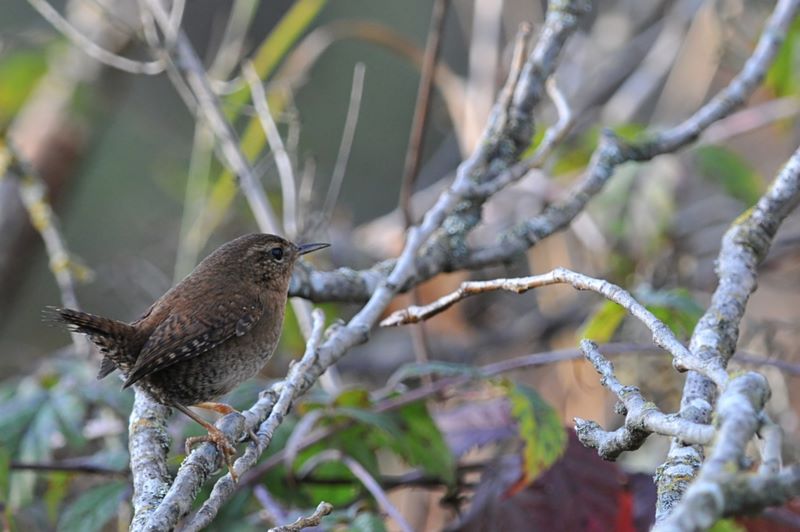
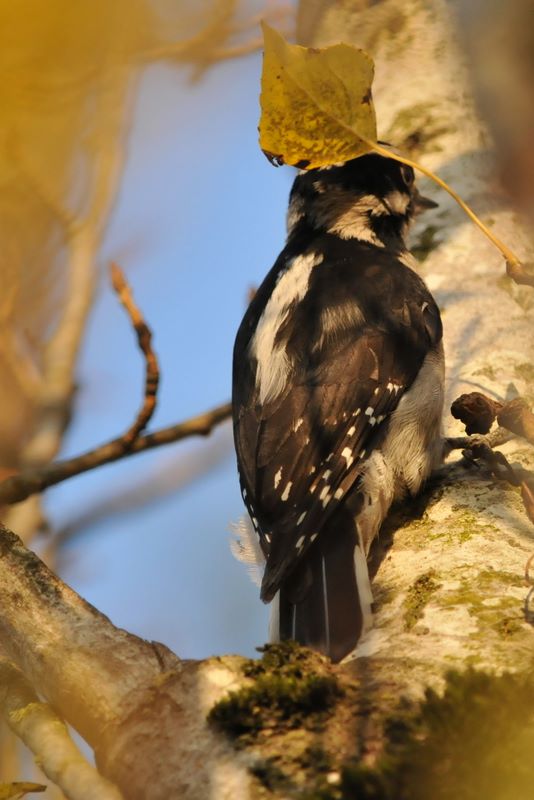 This afternoon as I was taking out the compost I heard the dry two-note "chek chek" of a Winter Wren
calling persistently from the brush around the herb garden behind the house. The sun had not quite
slipped behind the Treese's trees so I dashed inside and grabbed the camera. With it I got my
best-ever photos of a Winter Wren (which isn't saying much), though I missed the best close-up shots
because I accidentally had the focus-limiter switch set to 3m. There were 5 Winter Wrens around the
bases of the poplars along the back yard, the first time I've seen them in the yard this fall. Also
in the poplars were 4 Ruby-crowned Kinglets, 3 Brown Creepers, 2 Downy Woodpeckers and a Bewick's
Wren. I managed to get one half-decent shot of a kinglet though again I missed the best shot by not
having the camera ready when the bird perched on a nearby branch. Surprising how difficult it is to
This afternoon as I was taking out the compost I heard the dry two-note "chek chek" of a Winter Wren
calling persistently from the brush around the herb garden behind the house. The sun had not quite
slipped behind the Treese's trees so I dashed inside and grabbed the camera. With it I got my
best-ever photos of a Winter Wren (which isn't saying much), though I missed the best close-up shots
because I accidentally had the focus-limiter switch set to 3m. There were 5 Winter Wrens around the
bases of the poplars along the back yard, the first time I've seen them in the yard this fall. Also
in the poplars were 4 Ruby-crowned Kinglets, 3 Brown Creepers, 2 Downy Woodpeckers and a Bewick's
Wren. I managed to get one half-decent shot of a kinglet though again I missed the best shot by not
having the camera ready when the bird perched on a nearby branch. Surprising how difficult it is to
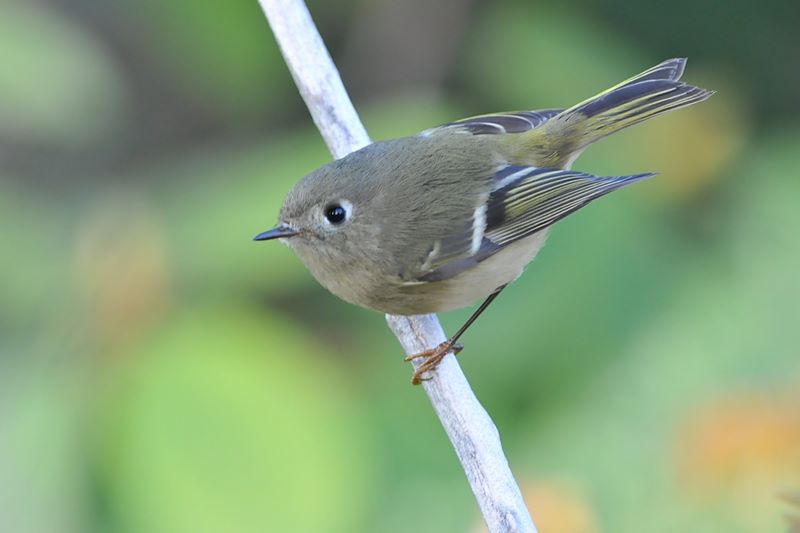
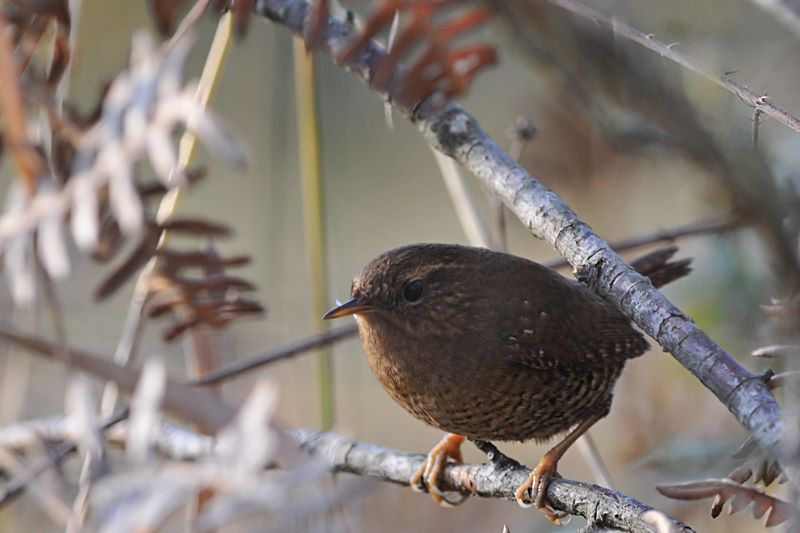 get good bird photos. I had perhaps a dozen opportunities with the kinglets but in almost every
photo the bird was facing away from me.
get good bird photos. I had perhaps a dozen opportunities with the kinglets but in almost every
photo the bird was facing away from me.
I'd planned to take the canoe over to Commencement Bay to try for more gull photos but before packing up I called Shep since he told me last night that he'd be out in his boat again in the early afternoon. He was, and reported that there were only Bonaparte's and Mew Gulls and a few Californias on the log booms. The Black-tailed Gull, along with most of the California Gulls, has apparently left town. I was tired from a fairly strenuous 24-mile bike ride so decided not to go out this afternoon after all. I'm glad I got to see the gull before it left though I wish I'd been able to get a better view, and some photos. As it turned out Gary and I were the last to see it.

Winter Wren


Ruby-crowned Kinglet

I'd planned to take the canoe over to Commencement Bay to try for more gull photos but before packing up I called Shep since he told me last night that he'd be out in his boat again in the early afternoon. He was, and reported that there were only Bonaparte's and Mew Gulls and a few Californias on the log booms. The Black-tailed Gull, along with most of the California Gulls, has apparently left town. I was tired from a fairly strenuous 24-mile bike ride so decided not to go out this afternoon after all. I'm glad I got to see the gull before it left though I wish I'd been able to get a better view, and some photos. As it turned out Gary and I were the last to see it.
11/14/2009 Sabbath High clouds, mid 40's
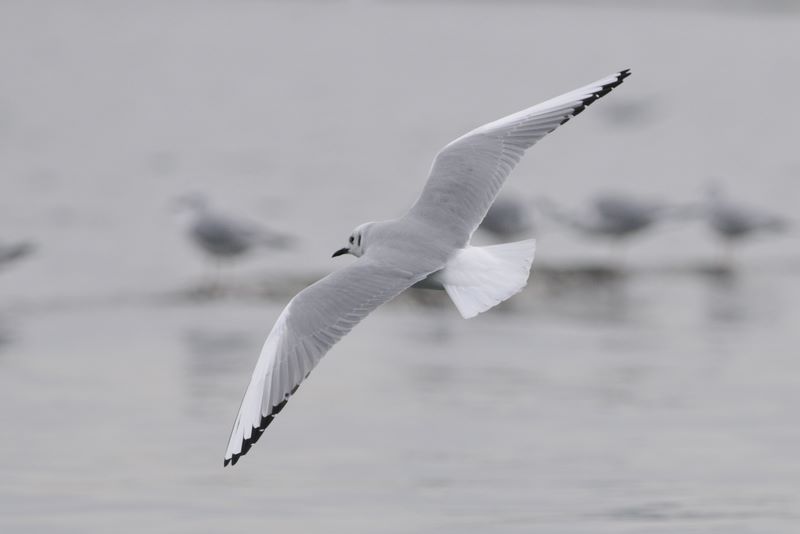 Another calm day on Commencement Bay. I took the canoe out around mid-morning, studied the gulls
Another calm day on Commencement Bay. I took the canoe out around mid-morning, studied the gulls
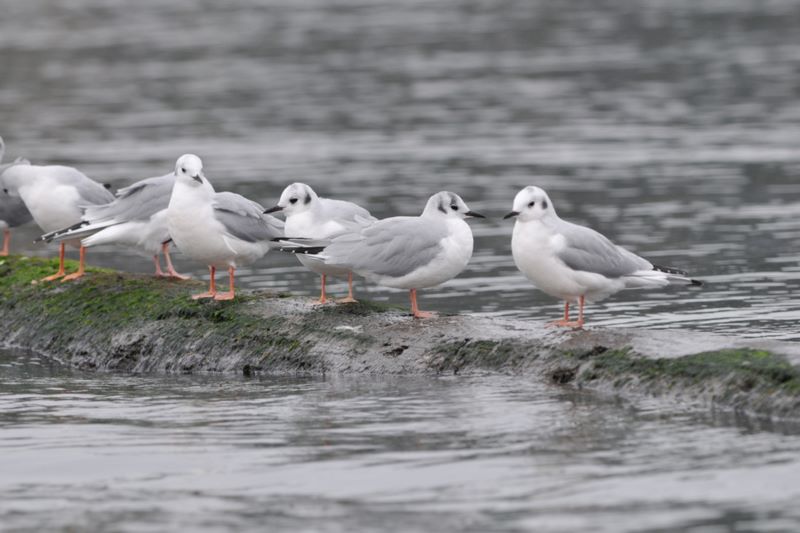 for a while and talked to Gary down in California about our id of the Black-tailed Gull for a while
then paddled over to Charlie's Marina and back to the gull flock where I photographed Bonaparte's
gulls for a while before heading back in to shore. Gary was returning my call from earlier in the
week. We agreed that it was the Black-tailed Gull that we saw, even though we weren't able to pick
out all the field marks, based on the size, the gray mantle grading into dark wingtips, the
yellowish legs and the extent of the black on the tail.
for a while and talked to Gary down in California about our id of the Black-tailed Gull for a while
then paddled over to Charlie's Marina and back to the gull flock where I photographed Bonaparte's
gulls for a while before heading back in to shore. Gary was returning my call from earlier in the
week. We agreed that it was the Black-tailed Gull that we saw, even though we weren't able to pick
out all the field marks, based on the size, the gray mantle grading into dark wingtips, the
yellowish legs and the extent of the black on the tail.
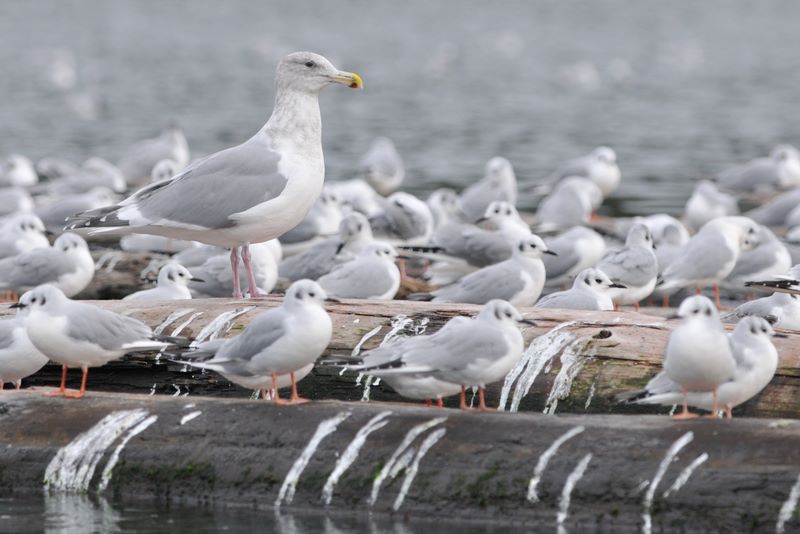
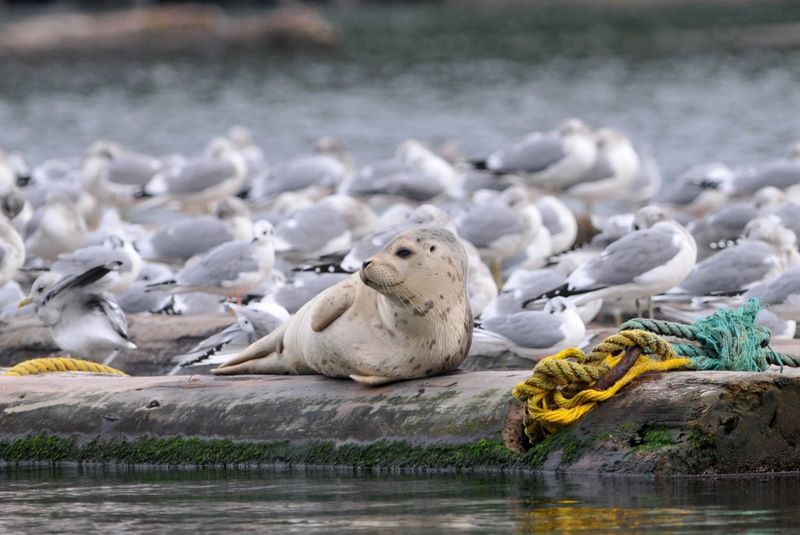 Bonaparte's gulls made up most of the flock today, their numbers augmented around noon by many new
arrivals from SE across the bay. They made the Mew Gulls look large and the Glaucous-winged, huge.
Other birds included the raft of Barrow's Goldeneyes, a solitary American Wigeon, a couple Brandt's
Cormorants and quite a few Double-crested, two Great Blue Herons, a few Black Turnstones and a small
flock of Least Sandpipers.
Bonaparte's gulls made up most of the flock today, their numbers augmented around noon by many new
arrivals from SE across the bay. They made the Mew Gulls look large and the Glaucous-winged, huge.
Other birds included the raft of Barrow's Goldeneyes, a solitary American Wigeon, a couple Brandt's
Cormorants and quite a few Double-crested, two Great Blue Herons, a few Black Turnstones and a small
flock of Least Sandpipers.



Huge Glaucous-winged Gull

A particularly cute Harbor Seal
11/15/2009 Cold rain
We watched David Eckblad get baptised this morning at the Wabash church. Their interim pastor seemed to claim in his sermon that by virtue of being baptised these young people were entering the portals of heaven and would (could?) now go out and save their communities. The candidates themselves each read a statement describing why they were choosing to be baptised. In virtually every case they had been raised in Christian families and first accepted Christ at a very young age, typically around 4 years old and were being baptised now that they had a more complete understanding of what it meant. Afterwards the Eckblad's hosted a number of friends for lunch. Nikki was delighted to see Susan, and Zack and I agreed to get back together for our morning Bible study and fellowship sometime soon.
We watched David Eckblad get baptised this morning at the Wabash church. Their interim pastor seemed to claim in his sermon that by virtue of being baptised these young people were entering the portals of heaven and would (could?) now go out and save their communities. The candidates themselves each read a statement describing why they were choosing to be baptised. In virtually every case they had been raised in Christian families and first accepted Christ at a very young age, typically around 4 years old and were being baptised now that they had a more complete understanding of what it meant. Afterwards the Eckblad's hosted a number of friends for lunch. Nikki was delighted to see Susan, and Zack and I agreed to get back together for our morning Bible study and fellowship sometime soon.
11/16/2009 Mild wind, then steady rain
I filled a trash barrel with junk from the carport/workshop this morning, including the old manual mitre saw I bought at a yard sale a decade ago. For 10 years it has been taking up room on one shelf or another in the workshop. For 10 years every time I've noticed it I've felt a little pang of regret for buying it and not using it and keeping it around occupying up valuable shelf space. For 10 years I've been unable to throw out a useless but perfectly usable (except that the saw blade is dull) mitre saw. Well, 10 years is long enough; as of today it will trouble me no longer!
While I was out we had a power outage which shut down my laptop and when I started it up again, PGP Desktop couldn't find my private keyring so I couldn't mount the encrypted disks on which I store financial and personal information. It took a while to find the keyring files and to figure out how to fix the problem - by overwriting the now-empty secret keying file with a backup copy, importing the keys from it then rebooting the laptop. It looks like the same thing may have happened last April but in the meantime I'd forgotten how to fix the problem and had to figure it out all over again. Well, note to self - check here for the solution next time.
Once I got the laptop working again, I signed up for the Seattle marathon. For the third time in the last 7 years, and I haven't been able to run it yet. But this time I think I'll make it.
I filled a trash barrel with junk from the carport/workshop this morning, including the old manual mitre saw I bought at a yard sale a decade ago. For 10 years it has been taking up room on one shelf or another in the workshop. For 10 years every time I've noticed it I've felt a little pang of regret for buying it and not using it and keeping it around occupying up valuable shelf space. For 10 years I've been unable to throw out a useless but perfectly usable (except that the saw blade is dull) mitre saw. Well, 10 years is long enough; as of today it will trouble me no longer!
While I was out we had a power outage which shut down my laptop and when I started it up again, PGP Desktop couldn't find my private keyring so I couldn't mount the encrypted disks on which I store financial and personal information. It took a while to find the keyring files and to figure out how to fix the problem - by overwriting the now-empty secret keying file with a backup copy, importing the keys from it then rebooting the laptop. It looks like the same thing may have happened last April but in the meantime I'd forgotten how to fix the problem and had to figure it out all over again. Well, note to self - check here for the solution next time.
Once I got the laptop working again, I signed up for the Seattle marathon. For the third time in the last 7 years, and I haven't been able to run it yet. But this time I think I'll make it.
11/18/2009 Sunny w/ increasing clouds, 45
Emptied the rain guage this morning - 5" since the beginning of the month, on top of 5" during the second half of October. That's a quarter of our annual rainfall in the past four weeks.
I took advantage of the break in the weather today by driving over to Four Corners and running the Lake Wilderness and Cedar River trails, both gravel rail trails with a gentle gradient. From the start my left knee was a bit stiff and my calves a little tight from a fairly hard run late yesterday afternoon. I ran eight miles yesterday, three of them barefoot at a brisk pace. Though it was 42 and wet and the soles of my feet were half numb afterwards, it was worth it to run barefoot, my feet so light and quick. Today I ran at a more comfortable pace, around 10:00/mile, for 19.4 miles. I just watched the trail go by for the first eight miles then finished up Deloris Claiborne during miles 9-14 and listened to Chopin Etudes and Nocturnes for the last five miles. My knee stiffened up during the drive home and stayed pretty sore for an hour or two afterwards. My lower left shin, the usual trouble spot, didn't feel quite right during the second half of the run and afterwards but didn't become sore either. I wore the blue insole in my left shoe for more support, testing my theory that my shin problems are associated with excessive pronation in that foot. I think that arrangement will work for the marathon.
Two noteworthy birds today, a Northern Shrike at the junction of SE 384th and 212th SE on the Auburn-Enumclaw plateau and a Peregrine Falcon circling over where Highway 18 crosses the Cedar River in Maple Valley, headed north.
Emptied the rain guage this morning - 5" since the beginning of the month, on top of 5" during the second half of October. That's a quarter of our annual rainfall in the past four weeks.
I took advantage of the break in the weather today by driving over to Four Corners and running the Lake Wilderness and Cedar River trails, both gravel rail trails with a gentle gradient. From the start my left knee was a bit stiff and my calves a little tight from a fairly hard run late yesterday afternoon. I ran eight miles yesterday, three of them barefoot at a brisk pace. Though it was 42 and wet and the soles of my feet were half numb afterwards, it was worth it to run barefoot, my feet so light and quick. Today I ran at a more comfortable pace, around 10:00/mile, for 19.4 miles. I just watched the trail go by for the first eight miles then finished up Deloris Claiborne during miles 9-14 and listened to Chopin Etudes and Nocturnes for the last five miles. My knee stiffened up during the drive home and stayed pretty sore for an hour or two afterwards. My lower left shin, the usual trouble spot, didn't feel quite right during the second half of the run and afterwards but didn't become sore either. I wore the blue insole in my left shoe for more support, testing my theory that my shin problems are associated with excessive pronation in that foot. I think that arrangement will work for the marathon.
Two noteworthy birds today, a Northern Shrike at the junction of SE 384th and 212th SE on the Auburn-Enumclaw plateau and a Peregrine Falcon circling over where Highway 18 crosses the Cedar River in Maple Valley, headed north.
11/19/2009 Rainy, windy, 40's, then high 50's in evening
Nearly missed a fine symphony concert this evening; I didn't remember it until I logged into the computer after supper, just 20 minutes before we had to leave. Susan was already out so we met and left a car at the Costco parking lot. We weren't quite the last ones in before they closed the doors.
Sumi Hahn in the Seattle Times online 11/20/09 described the concert better than I can.
Nearly missed a fine symphony concert this evening; I didn't remember it until I logged into the computer after supper, just 20 minutes before we had to leave. Susan was already out so we met and left a car at the Costco parking lot. We weren't quite the last ones in before they closed the doors.
Sumi Hahn in the Seattle Times online 11/20/09 described the concert better than I can.
11/20/2009 Ovc, showers, low 40's
Spent most of the day investigating generator options, which range from about $1000 for a 6.5KW gas-powered portable to $7000 or more for a 17KW automatic standby generator powered by propane from a 500 gallon tank. Bruce from DSquared in North Bend came by to give us a bid on the latter option, their specialty. That might be overkill though, considering that we've lived here almost two decades and have never in all that time owned a functioning generator of any kind. I think there was one power outage where we lost some food in our freezers, perhaps $200 worth, and some of the fish in our fish tank died from the chill, and another time when I borrowed a 5KW generator from Pat for a few days which proved insufficient to power our well. Right now the most appealing option is an 8KW propane generator with a 120 gallon tank, which we might be able to get installed for $3500 or so, about the same price as a Honda 6500 watt gas-powered inverter generator. The propane setup is more trouble initially but would be considerably more convenient to use than gasoline.
Spent most of the day investigating generator options, which range from about $1000 for a 6.5KW gas-powered portable to $7000 or more for a 17KW automatic standby generator powered by propane from a 500 gallon tank. Bruce from DSquared in North Bend came by to give us a bid on the latter option, their specialty. That might be overkill though, considering that we've lived here almost two decades and have never in all that time owned a functioning generator of any kind. I think there was one power outage where we lost some food in our freezers, perhaps $200 worth, and some of the fish in our fish tank died from the chill, and another time when I borrowed a 5KW generator from Pat for a few days which proved insufficient to power our well. Right now the most appealing option is an 8KW propane generator with a 120 gallon tank, which we might be able to get installed for $3500 or so, about the same price as a Honda 6500 watt gas-powered inverter generator. The propane setup is more trouble initially but would be considerably more convenient to use than gasoline.
11/21/2009 Sabbath Ovc, showers, mid 40's
The boys came home for the evening. Somewhat after sunset I lit a fire in the fireplace because the living room was cold (about 62F). Seeing the fire, Susan suggested I call the boys up for worship. We haven't done that much recently but I agreed. When she didn't have any ideas as to what to read, I chose 2 Corinthians 5:17-21. No particular reason, other than it was only a few pages from where I'd left the little marking ribbon the last time I was reading my Bible.
I've never particularly liked this passage. The verse which troubles me is 17: "Therefore, if anyone is in Christ he is a new creation; old things have passed away; behold, all things have become new." I've always understood things to refer to the character, the thoughts and desires and habits. In that view, the verse seems to say that when I am converted and living a new life in Christ, then my character is changed and my thoughts and desires no longer oppose God, but rather come into harmony with Him. Unfortunately that has not been my experience, and I have taken the persistence of "the old man", as Paul refers to it in Romans 6, to indicate that I am not in Christ after all. Because I didn't see much evidence that "all things have become new", I concluded that the Gospel "didn't work" in my case. And as to the rest of the passage, what incentive was there to go out and preach reconciliation if I that reconciliation didn't apply to me personally?
This evening however, and for the first time, I saw this passage in a different light. The reference to things being changed for those who are in Christ now seemed to be saying that for those who have been reconciled to God, the rules are different. The paradigm has changed. Under the old rules, my behavior did count and it wasn't good enough. My continuing failure to measure up to His standards excluded me from His grace. But this verse says that the old rules don't apply. They've been replaced by a new arrangement between God and me through Christ. Under the new rules, I am reconciled to God through Jesus' death and established in God's grace through Jesus' life. That which was done by God's action ("God was in Christ reconciling the world to Himself, not imputing their trespasses to them" v19), is not undone by mine. Once I have been reconciled to God, my actions, whether good or bad, no longer affect my standing with Him.
I read the passage aloud and talked briefly about it, something along the lines of what I've written here. I don't know if it struck a chord with the boys or not. Immersed as they are in the secular environment of college, they may not have much opportunity or inclination to consider spiritual things right now. Our boys were raised in a Christian home but perhaps with more ambivalence than David Eckblad and his fellow baptismal candidates last weekend. I haven't tried to hide my struggles from them, nor have we concealed our distrust of much of Christian culture and politics. Unfortunately in our distaste for the bathwater we may have discarded the baby, with regard to our influence on their life with God.
On a cheerier note, I completed our 2009 Christmas Letter this evening, first a print version then this online edition. Susan liked the layout but found the content a little boring. I can see her point; our lives wouldn't make for very interesting reality TV, but on the other hand things certainly could be worse.
The boys came home for the evening. Somewhat after sunset I lit a fire in the fireplace because the living room was cold (about 62F). Seeing the fire, Susan suggested I call the boys up for worship. We haven't done that much recently but I agreed. When she didn't have any ideas as to what to read, I chose 2 Corinthians 5:17-21. No particular reason, other than it was only a few pages from where I'd left the little marking ribbon the last time I was reading my Bible.
I've never particularly liked this passage. The verse which troubles me is 17: "Therefore, if anyone is in Christ he is a new creation; old things have passed away; behold, all things have become new." I've always understood things to refer to the character, the thoughts and desires and habits. In that view, the verse seems to say that when I am converted and living a new life in Christ, then my character is changed and my thoughts and desires no longer oppose God, but rather come into harmony with Him. Unfortunately that has not been my experience, and I have taken the persistence of "the old man", as Paul refers to it in Romans 6, to indicate that I am not in Christ after all. Because I didn't see much evidence that "all things have become new", I concluded that the Gospel "didn't work" in my case. And as to the rest of the passage, what incentive was there to go out and preach reconciliation if I that reconciliation didn't apply to me personally?
This evening however, and for the first time, I saw this passage in a different light. The reference to things being changed for those who are in Christ now seemed to be saying that for those who have been reconciled to God, the rules are different. The paradigm has changed. Under the old rules, my behavior did count and it wasn't good enough. My continuing failure to measure up to His standards excluded me from His grace. But this verse says that the old rules don't apply. They've been replaced by a new arrangement between God and me through Christ. Under the new rules, I am reconciled to God through Jesus' death and established in God's grace through Jesus' life. That which was done by God's action ("God was in Christ reconciling the world to Himself, not imputing their trespasses to them" v19), is not undone by mine. Once I have been reconciled to God, my actions, whether good or bad, no longer affect my standing with Him.
I read the passage aloud and talked briefly about it, something along the lines of what I've written here. I don't know if it struck a chord with the boys or not. Immersed as they are in the secular environment of college, they may not have much opportunity or inclination to consider spiritual things right now. Our boys were raised in a Christian home but perhaps with more ambivalence than David Eckblad and his fellow baptismal candidates last weekend. I haven't tried to hide my struggles from them, nor have we concealed our distrust of much of Christian culture and politics. Unfortunately in our distaste for the bathwater we may have discarded the baby, with regard to our influence on their life with God.
On a cheerier note, I completed our 2009 Christmas Letter this evening, first a print version then this online edition. Susan liked the layout but found the content a little boring. I can see her point; our lives wouldn't make for very interesting reality TV, but on the other hand things certainly could be worse.
11/22/2009 Ovc, showers, mid 40's
Spent most of the day at the computer, revising the format of my Journal pages as well as some of the other brianpen.com pages. In the new format, the page content is framed by a thin gold border and floats in a field of dark gray. Passing parameter "print=Y" in the query string removes the heading, frame and breadcrumb links for printing.
Spent most of the day at the computer, revising the format of my Journal pages as well as some of the other brianpen.com pages. In the new format, the page content is framed by a thin gold border and floats in a field of dark gray. Passing parameter "print=Y" in the query string removes the heading, frame and breadcrumb links for printing.
11/23/2009 Ovc, showers, mid 40's
At dusk this evening I stepped out of the workshop for a moment just as the Great-horned Owl flew over, flapping stiffly, steadily, silently less than 30 feet overhead. We've been hearing it call in the night for a couple of months but this was the first time I've seen it.
At dusk this evening I stepped out of the workshop for a moment just as the Great-horned Owl flew over, flapping stiffly, steadily, silently less than 30 feet overhead. We've been hearing it call in the night for a couple of months but this was the first time I've seen it.
11/24/2009 Fog, drizzle, upper 40's
I don't know what I did yesterday, but today I put up an online version of our 2008 Christmas letter, something I never got around to doing last year. I made an image map for the collage so each image in the collage links to either a larger version of the shot, or a photo gallery, or a journal entry. It's pretty cool. Little by little I'm learning more HTML and CSS, which is also cool.
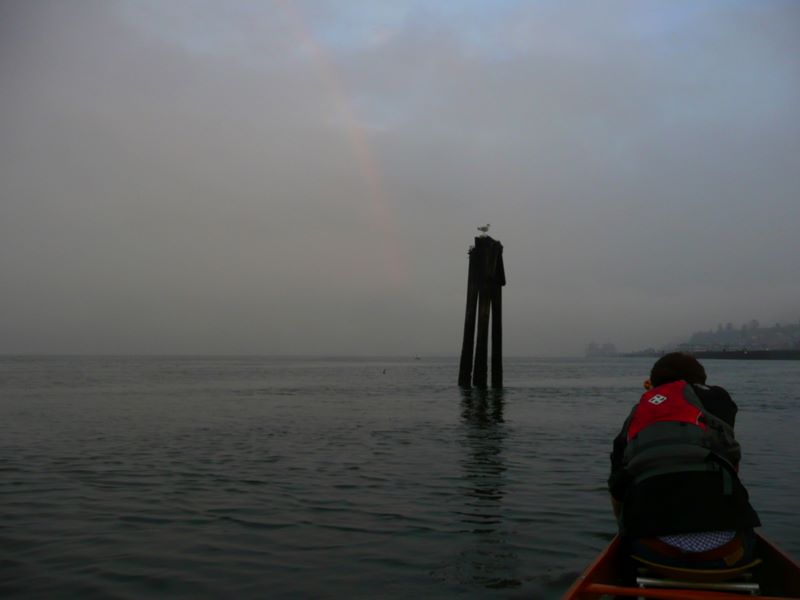 This afternoon I drove over to Tacoma and picked up Daniel, then we took the canoe out on Commencement
Bay below Old Town. We paddled NE past the pair of big gray ships moored east of town then W over to
"GI Shenanigans" restaurant along Ruston Way west of Old Town. It was misty and quiet when we set out
but a bit of a breeze came up and cleared the air somewhat by sunset, revealing some color off to the
southwest and a hint of a rainbow over the bay.
This afternoon I drove over to Tacoma and picked up Daniel, then we took the canoe out on Commencement
Bay below Old Town. We paddled NE past the pair of big gray ships moored east of town then W over to
"GI Shenanigans" restaurant along Ruston Way west of Old Town. It was misty and quiet when we set out
but a bit of a breeze came up and cleared the air somewhat by sunset, revealing some color off to the
southwest and a hint of a rainbow over the bay.
After supper I baked the last piece of my 2008 salmon. It came out remarkably well (baked w/ onion, capers and red wine) considering how long it has been sitting in the freezer. White wine, or perhaps no wine, would have been better; the red is a little strong for fish.
I don't know what I did yesterday, but today I put up an online version of our 2008 Christmas letter, something I never got around to doing last year. I made an image map for the collage so each image in the collage links to either a larger version of the shot, or a photo gallery, or a journal entry. It's pretty cool. Little by little I'm learning more HTML and CSS, which is also cool.

After supper I baked the last piece of my 2008 salmon. It came out remarkably well (baked w/ onion, capers and red wine) considering how long it has been sitting in the freezer. White wine, or perhaps no wine, would have been better; the red is a little strong for fish.
11/25/2009 Fog early, then partly sunny w/ increasing clouds late, 40-55
I fixed our Internet again this morning. Being out of range of both Cable and DSL we depend for internet access on a chain of points of failure consisting of a transmitter on top of a peak north of Mt Rainier, a relay antenna on the corner of the roof of a house at the end of our street, a dish antenna nailed to the several trunks of a 40' tall Western White Pine out in our field and a 300' run of CAT5 cable from the dish in the pine down to and across the field past the garden gate to the driveway fence where it is coupled to another run of CAT5 cable under the driveway and up through a hole our living room wall to the router on top of the bookcase. Unfortunately nature, in the form of two cottonwoods and a young Douglas fir on the property of an irascible neighbor down the street, is steadily encroaching on the tenuous connection between the relay station and our dish. On dry days the signal gets through clearly but rain and wind can confuse it and drizzle seems to disrupt it entirely. My theory is that the signal can evade small twigs and branches but cannot penetrate the water which during calm drizzly conditions such as this evening collects in the form of a droplet on each and every needle of that Douglas Fir.
A couple of days ago our Internet quit entirely so I climbed the pine, which this time of year is coated with a seasonal skin of crumbly slimy green algae, and discovered that the windstorm earlier this week had pulled the dish bracket (an old piece of 2x6 lumber) free from trunk #3 so the dish was facing east towards the street rather than south towards the source of the signal. I reattached the 2x6 and for good measure tied the dish into position with baling twine. After my repair our signal was as strong as I've ever measured it (4500 download and 1350 upload at Speakeasy).
After I got the internet working I went out for a run and did 8.3 miles barefoot, my longest barefoot run ever, from BV back to the Grange with side trips up 176th and down 180th. Rough chipseal in the second mile left my feet pretty tender but by mile 3 I found smoother pavement and the feet recovered. Afterwards they were a little sore, particularly around the outer edges of my heels, an area which seems to be aggravated by running downhill.
^ *
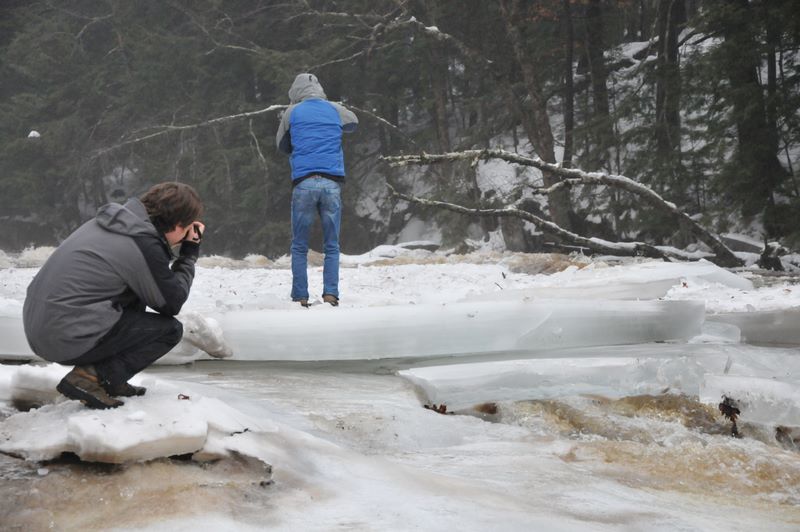
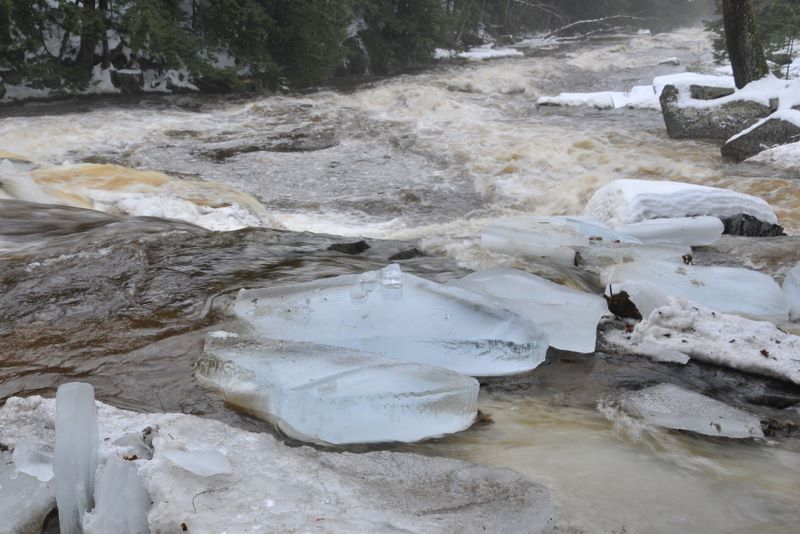
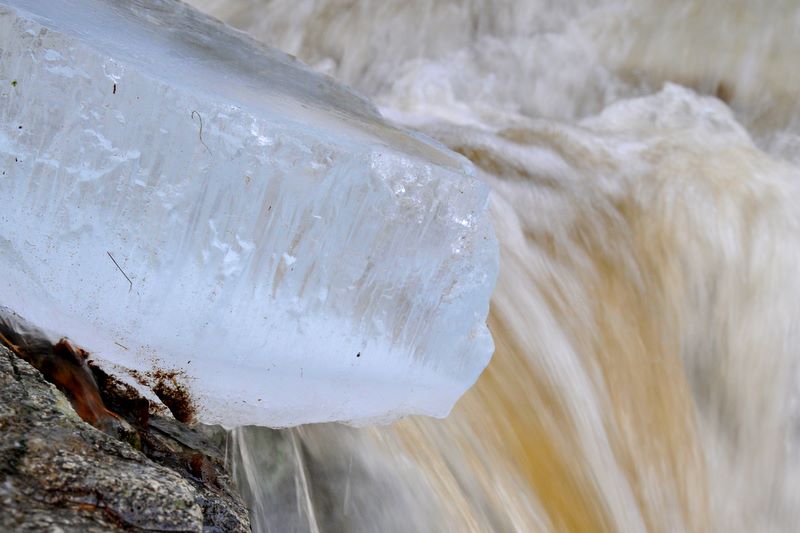
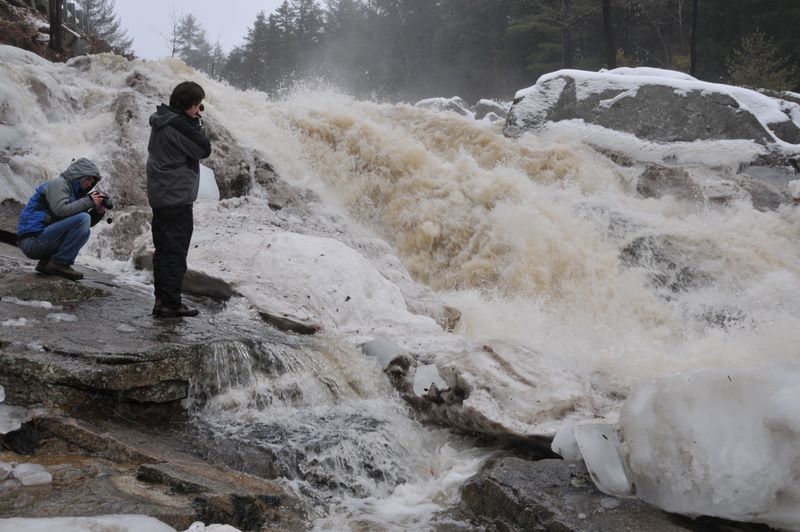
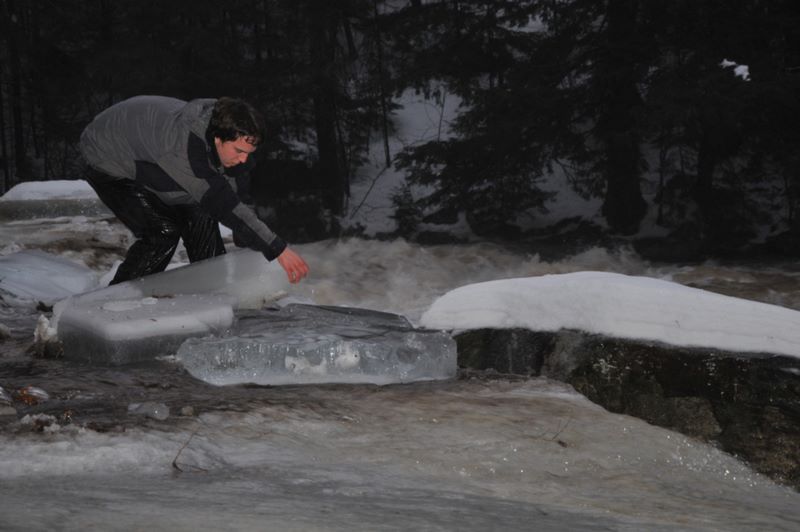 12/27/2009 Jackson Falls ice out Wet, high 30's
12/27/2009 Jackson Falls ice out Wet, high 30's
The day after Christmas Daniel, Silas, Kirsten and I skied down to the village and up to the warming shack on the Ellis River trail. We wore ourselves out trying to keep up with Silas. Heavy rain overnight into the 27th turned the hard-packed snow in the driveway to slush so I shoveled it all out of the way. Great Brook cleared all the ice and snow out of its way too. Late in the afternoon the rain finally let up so the boys and I drove down to check out Jackson Falls. We took photos while the light held up then Daniel and David pushed beached slabs of ice back into the raging torrent. Tough work but someone had to do it.
I fixed our Internet again this morning. Being out of range of both Cable and DSL we depend for internet access on a chain of points of failure consisting of a transmitter on top of a peak north of Mt Rainier, a relay antenna on the corner of the roof of a house at the end of our street, a dish antenna nailed to the several trunks of a 40' tall Western White Pine out in our field and a 300' run of CAT5 cable from the dish in the pine down to and across the field past the garden gate to the driveway fence where it is coupled to another run of CAT5 cable under the driveway and up through a hole our living room wall to the router on top of the bookcase. Unfortunately nature, in the form of two cottonwoods and a young Douglas fir on the property of an irascible neighbor down the street, is steadily encroaching on the tenuous connection between the relay station and our dish. On dry days the signal gets through clearly but rain and wind can confuse it and drizzle seems to disrupt it entirely. My theory is that the signal can evade small twigs and branches but cannot penetrate the water which during calm drizzly conditions such as this evening collects in the form of a droplet on each and every needle of that Douglas Fir.
A couple of days ago our Internet quit entirely so I climbed the pine, which this time of year is coated with a seasonal skin of crumbly slimy green algae, and discovered that the windstorm earlier this week had pulled the dish bracket (an old piece of 2x6 lumber) free from trunk #3 so the dish was facing east towards the street rather than south towards the source of the signal. I reattached the 2x6 and for good measure tied the dish into position with baling twine. After my repair our signal was as strong as I've ever measured it (4500 download and 1350 upload at Speakeasy).
After I got the internet working I went out for a run and did 8.3 miles barefoot, my longest barefoot run ever, from BV back to the Grange with side trips up 176th and down 180th. Rough chipseal in the second mile left my feet pretty tender but by mile 3 I found smoother pavement and the feet recovered. Afterwards they were a little sore, particularly around the outer edges of my heels, an area which seems to be aggravated by running downhill.
^ *
(.*?)
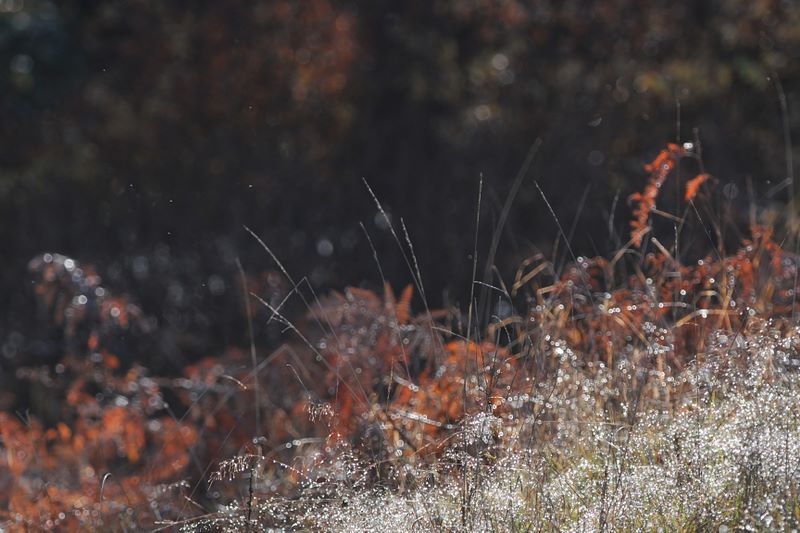
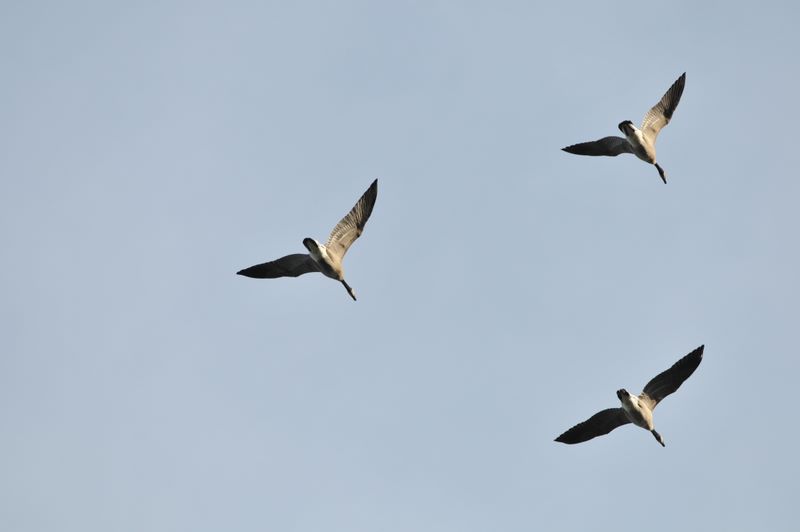
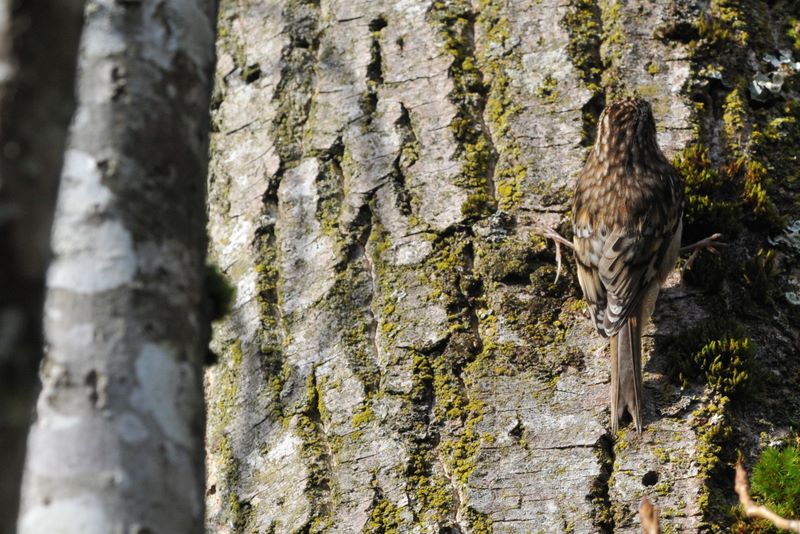
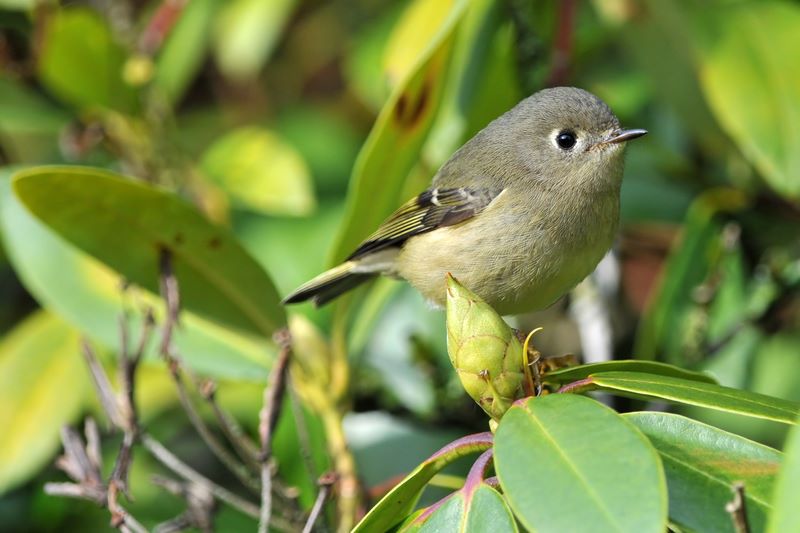
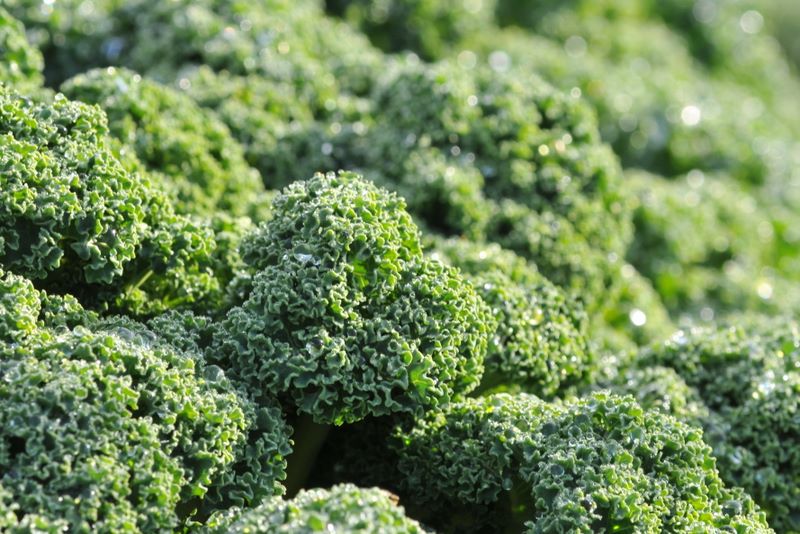 12/01/2009 Sunny
12/01/2009 Sunny
Got a nice portrait of a Ruby-crowned Kinglet in the rhododendron behind the herb garden this afternoon. There are still several of them around the house, along with Winter Wrens, Brown Creepers, Dark-eyed Juncos, Golden-crowned Kinglets, Bewick's Wrens and the other usual suspects.
11/26/2009 Thanksgiving Heavy overcast w/ light rain, upper 40's
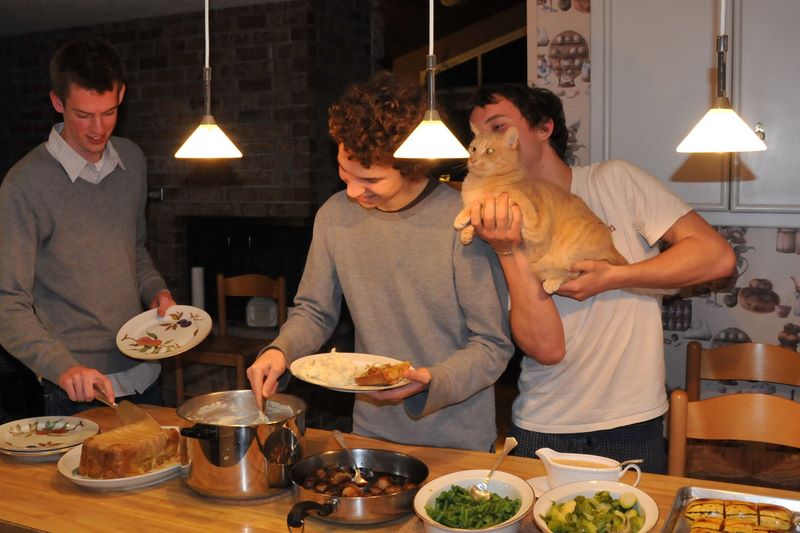 ^ *
^ *

Cody, David, Daniel & Puss
(.*?)
11/29/2009 Seattle Marathon
I left the house around 6:30AM and found parking along Westlake Ave about a mile from the start. I exited at Madison and took Boren down to Denny, then failed to get off Denny soon enough so ended up sitting in traffic for an extra 10 minutes. Next time it would be better to turn left onto Westlake, and perhaps also spring for the extra $5 to park in a lot near the start.
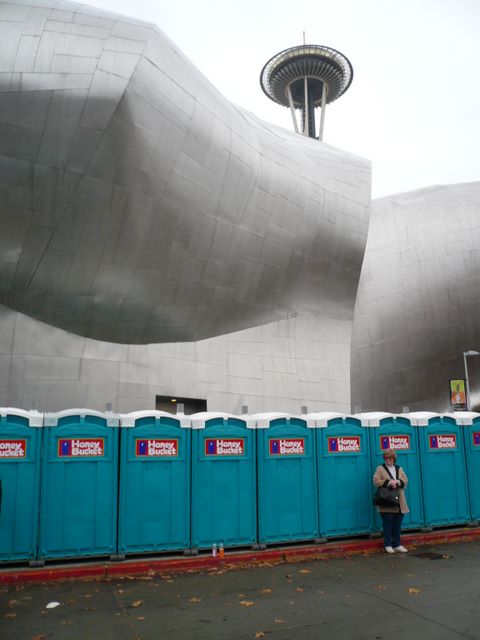
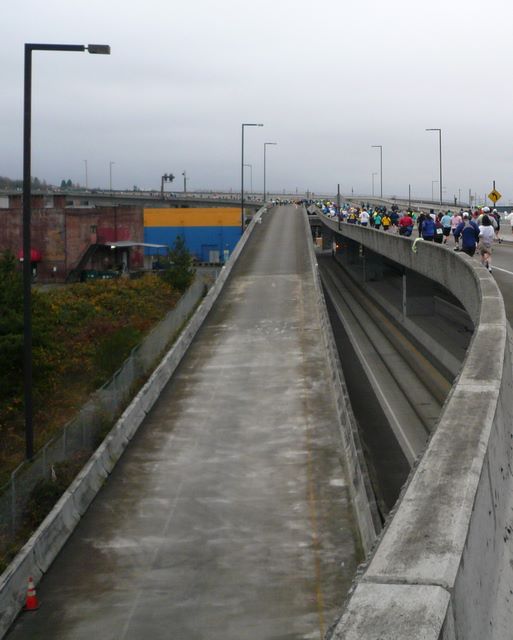
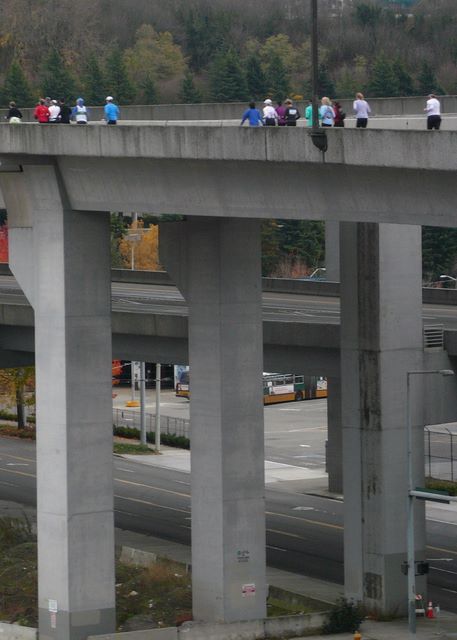
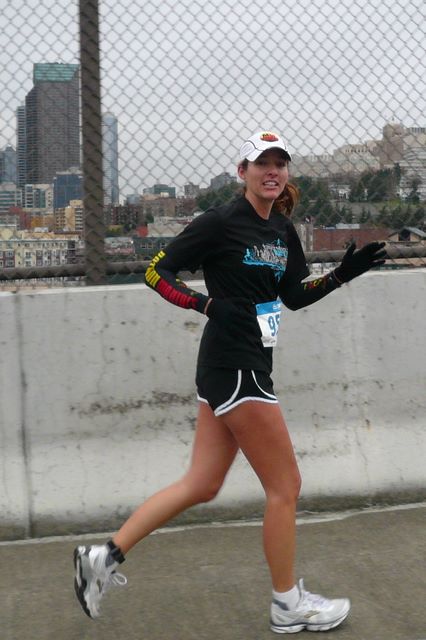
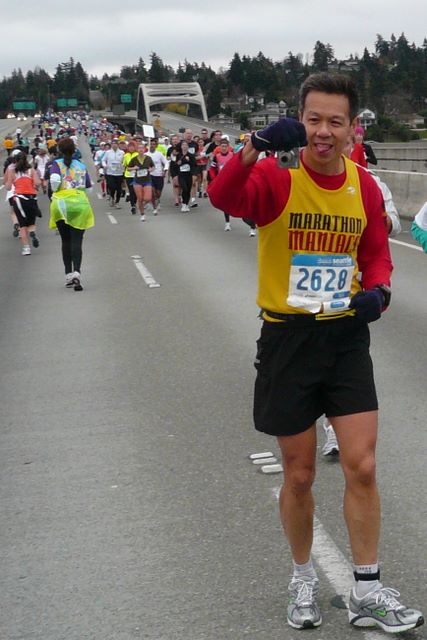
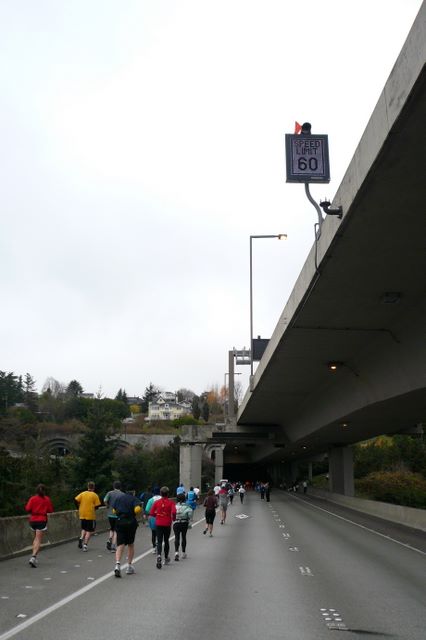 I reached the starting area about a half hour before the 8:15AM start and right away ran into Tony
and his friend Lori #1700 whose last name I never quite caught, though I ended up running with her
on and off for most of the race. I found a few more Maniacs over by the bag drop, then wandered
over to the long lines of nearly unoccupied Porta Potties by EMP. Interesting photo compositions.
Lori and I caught up to Barefoot Todd #210 around mile 5 on the I-90 floating bridge. I slowed down
to run with him for awhile. He greeted me like an old friend though I don't think he quite
remembered where he'd run across me before, and though I said my name I forgot to mention that we'd
met previously at the Tahoe Triple. We talked about barefoot running, of course. I ran back across
the bridge with Jim Boyd, a particularly friendly Maniac who's a big fan of our races, and with whom
I always enjoy running and visiting. Once I got off the freeway at mile 8 I didn't take any more
pictures, to my regret since Seattle is such a scenic course. I caught up to Lori again somewhere
south of the bridge, then continued on ahead intending to catch Marilou #285 with whom we'd started
out. I caught up to her and David Hamilton #505 at the start of the loop around Seward Park. and
took off my shoes. That was about mile 12 and I made it to mile 18 before the rough road began to
be too much for my tender feet. Around mile 16 I passed my inspiration Barefoot Jon #209 who was
delightfully excited to see me running barefoot, and a little while later met Jill #535. I found
Monte #438 around mile 18 and ran with him for a few minutes. He's slowed down since ankle surgery
last April and his ankle is still bothering him though he's run 11 marathons since June nonetheless.
Somewhere around mile 20, shortly before the Galer hill, I met up with Larry Macon #120 and walked
with him for the next half hour. He's on his 90'th this year, #598 lifetime. He told me he works
80 hours a week as a trial lawyer in Texas so isn't able to run as many marathons as he'd like. I
told him what I've been doing and he observed that I have alot of hobbies. After all that walking
I'd gotten stiff but loosened up as I ran through the woods up the Interlaken hill, one of my
favorite parts of the course. I caught up to Lori again at mile 24 where Boylston crosses under the
freeway. Before I drifted ahead on the downhill over the freeway I told her we were on track for
4:22 but I was a couple minutes too optimistic. I finished in 4:23:11 feeling very good considering
I haven't run one in a while, basically just stiff from the waist down and that loosened up with a
little stretching.
I reached the starting area about a half hour before the 8:15AM start and right away ran into Tony
and his friend Lori #1700 whose last name I never quite caught, though I ended up running with her
on and off for most of the race. I found a few more Maniacs over by the bag drop, then wandered
over to the long lines of nearly unoccupied Porta Potties by EMP. Interesting photo compositions.
Lori and I caught up to Barefoot Todd #210 around mile 5 on the I-90 floating bridge. I slowed down
to run with him for awhile. He greeted me like an old friend though I don't think he quite
remembered where he'd run across me before, and though I said my name I forgot to mention that we'd
met previously at the Tahoe Triple. We talked about barefoot running, of course. I ran back across
the bridge with Jim Boyd, a particularly friendly Maniac who's a big fan of our races, and with whom
I always enjoy running and visiting. Once I got off the freeway at mile 8 I didn't take any more
pictures, to my regret since Seattle is such a scenic course. I caught up to Lori again somewhere
south of the bridge, then continued on ahead intending to catch Marilou #285 with whom we'd started
out. I caught up to her and David Hamilton #505 at the start of the loop around Seward Park. and
took off my shoes. That was about mile 12 and I made it to mile 18 before the rough road began to
be too much for my tender feet. Around mile 16 I passed my inspiration Barefoot Jon #209 who was
delightfully excited to see me running barefoot, and a little while later met Jill #535. I found
Monte #438 around mile 18 and ran with him for a few minutes. He's slowed down since ankle surgery
last April and his ankle is still bothering him though he's run 11 marathons since June nonetheless.
Somewhere around mile 20, shortly before the Galer hill, I met up with Larry Macon #120 and walked
with him for the next half hour. He's on his 90'th this year, #598 lifetime. He told me he works
80 hours a week as a trial lawyer in Texas so isn't able to run as many marathons as he'd like. I
told him what I've been doing and he observed that I have alot of hobbies. After all that walking
I'd gotten stiff but loosened up as I ran through the woods up the Interlaken hill, one of my
favorite parts of the course. I caught up to Lori again at mile 24 where Boylston crosses under the
freeway. Before I drifted ahead on the downhill over the freeway I told her we were on track for
4:22 but I was a couple minutes too optimistic. I finished in 4:23:11 feeling very good considering
I haven't run one in a while, basically just stiff from the waist down and that loosened up with a
little stretching.
I left the house around 6:30AM and found parking along Westlake Ave about a mile from the start. I exited at Madison and took Boren down to Denny, then failed to get off Denny soon enough so ended up sitting in traffic for an extra 10 minutes. Next time it would be better to turn left onto Westlake, and perhaps also spring for the extra $5 to park in a lot near the start.











Got a nice portrait of a Ruby-crowned Kinglet in the rhododendron behind the herb garden this afternoon. There are still several of them around the house, along with Winter Wrens, Brown Creepers, Dark-eyed Juncos, Golden-crowned Kinglets, Bewick's Wrens and the other usual suspects.
12/05/2009 Sabbath Sunny, 25-36, windy late
A White-throated Sparrow showed up at the feeder today, perhaps the same one from last winter. One of these days I'll get out and try for some photos.
We were very social today. Not only did we make it to church but we also attended two parties in the evening. At church we visited with Greg and Grace Gratias who mentioned that Brandon is living with them this winter and may be looking for a partner for some mountaineering outings, and with Keith and Sandy Rodman who are back from a couple of years in the South Pacific. Keith suggested David go to Yap and teach English but David wasn't sure that would be something he'd enjoy. As usual we were among the last to leave.
The first of our parties was the annual and always delicious Murphy and Associates holiday dinner; I've never had a better-prepared Portabello mushroom. It was grilled and sliced and seasoned I think with garlic, rosemary and perhaps thyme. Not too oily or salty, just right, served over mashed potatoes with some complementary vegetable and a sauce that tasted of artichokes and Brussels sprouts. We sat at Donna Murphy's table. She's as animated as ever, living in a house she built on Mercer Island and active in a real estate career. Ray is retired and living in North Bend, where he invited us to stay with him if we're ever down that way for a marathon. Joel is embarking on a new career in Christian counseling in Chicago while remaining involved in the family business for the time being. At dinner I sat next to Phil Ludwig who's been working for Jagdish at Expedia for three years now. His Russian? girlfriend affected to fall asleep during the entertainment, an improv group which was moderately entertaining. After dinner I found Jim Bergh who's doing cutting edge stuff in data warehousing for the Microsoft XBox customer analytics team. He sounded delighted with his work.
From the Bellevue Club we drove over to North Seattle to Lisa Michelle's annual holiday party. She's been inviting me for years but for one reason or another I've never been able to make it. Though the crowd was pretty sparse by the time we arrived both Susan and I enjoyed talking with several different people there. Reggie Jones reminded me that he's still interested in green tomatoes if I ever have any to spare. Jeff Jorgenson, laid off 6 months or more ago from Expedia, has found another job. His wife Cheryl drives a Metro bus, one of the big articulated ones, and also has a business photographing horses for sale. She recommended to us that David master 3D drawing and continue to pursue his interest in concept art. Outside in the tent I found Holly Gion whom I hadn't seen since early days at Expedia when we worked on the Peoplesoft implementation together. She left to attend law school and is now an attorney at Nordstrom working with privacy and information security, still finds it very interesting. Susan talked quite a bit with John Hale, Paul's brother. Turns out he knows Jim Tedrick, used to sell roofing material to him. Towards the end of the evening as they were packing up the appetizers I talked with Paul some, learned that his father was SDA when he was young and he attended VBS and Sabbath School as a kid, though I think his father drifted away from the church later on. Will have to follow up at next year's party.
A White-throated Sparrow showed up at the feeder today, perhaps the same one from last winter. One of these days I'll get out and try for some photos.
We were very social today. Not only did we make it to church but we also attended two parties in the evening. At church we visited with Greg and Grace Gratias who mentioned that Brandon is living with them this winter and may be looking for a partner for some mountaineering outings, and with Keith and Sandy Rodman who are back from a couple of years in the South Pacific. Keith suggested David go to Yap and teach English but David wasn't sure that would be something he'd enjoy. As usual we were among the last to leave.
The first of our parties was the annual and always delicious Murphy and Associates holiday dinner; I've never had a better-prepared Portabello mushroom. It was grilled and sliced and seasoned I think with garlic, rosemary and perhaps thyme. Not too oily or salty, just right, served over mashed potatoes with some complementary vegetable and a sauce that tasted of artichokes and Brussels sprouts. We sat at Donna Murphy's table. She's as animated as ever, living in a house she built on Mercer Island and active in a real estate career. Ray is retired and living in North Bend, where he invited us to stay with him if we're ever down that way for a marathon. Joel is embarking on a new career in Christian counseling in Chicago while remaining involved in the family business for the time being. At dinner I sat next to Phil Ludwig who's been working for Jagdish at Expedia for three years now. His Russian? girlfriend affected to fall asleep during the entertainment, an improv group which was moderately entertaining. After dinner I found Jim Bergh who's doing cutting edge stuff in data warehousing for the Microsoft XBox customer analytics team. He sounded delighted with his work.
From the Bellevue Club we drove over to North Seattle to Lisa Michelle's annual holiday party. She's been inviting me for years but for one reason or another I've never been able to make it. Though the crowd was pretty sparse by the time we arrived both Susan and I enjoyed talking with several different people there. Reggie Jones reminded me that he's still interested in green tomatoes if I ever have any to spare. Jeff Jorgenson, laid off 6 months or more ago from Expedia, has found another job. His wife Cheryl drives a Metro bus, one of the big articulated ones, and also has a business photographing horses for sale. She recommended to us that David master 3D drawing and continue to pursue his interest in concept art. Outside in the tent I found Holly Gion whom I hadn't seen since early days at Expedia when we worked on the Peoplesoft implementation together. She left to attend law school and is now an attorney at Nordstrom working with privacy and information security, still finds it very interesting. Susan talked quite a bit with John Hale, Paul's brother. Turns out he knows Jim Tedrick, used to sell roofing material to him. Towards the end of the evening as they were packing up the appetizers I talked with Paul some, learned that his father was SDA when he was young and he attended VBS and Sabbath School as a kid, though I think his father drifted away from the church later on. Will have to follow up at next year's party.
12/09/2009 Sunny, 8-29
The cold dry weather continues. Last night the driveway thermometer reported 8F and the one on the back porch read 15. The night before the driveway thermometer was 9F, and before that, 11F. No snow and not much frost, just cold. Daytime highs haven't reached 30F for two days now, and may not have reached 32F the day before that. Wind accompanied the cold for the first day or two but died down by yesterday.
I ran 13.5 miles this afternoon including almost 3 barefoot before my feet began to hurt and go numb at the same time. I meant to get out yesterday but got involved in creating the page to email Maniac membership requests. The cold is a deterrent too; by the time it has warmed up enough to go out for a run it's time for lunch instead, then by the time I'm ready to go out again the sun is starting to set and the temperature is dropping again. I run in the cold so infrequently that I forget what to wear, so for future reference, today I wore my lined lightweight shell pants over running shorts, my yellow wind shell jacket over a short and a long-sleved tech shirt, a neck warmer, headband and snowboarding liner mittens. I was very confortable, wore the neck warmer only for the first mile or so and the mittens off and on.
The cold dry weather continues. Last night the driveway thermometer reported 8F and the one on the back porch read 15. The night before the driveway thermometer was 9F, and before that, 11F. No snow and not much frost, just cold. Daytime highs haven't reached 30F for two days now, and may not have reached 32F the day before that. Wind accompanied the cold for the first day or two but died down by yesterday.
I ran 13.5 miles this afternoon including almost 3 barefoot before my feet began to hurt and go numb at the same time. I meant to get out yesterday but got involved in creating the page to email Maniac membership requests. The cold is a deterrent too; by the time it has warmed up enough to go out for a run it's time for lunch instead, then by the time I'm ready to go out again the sun is starting to set and the temperature is dropping again. I run in the cold so infrequently that I forget what to wear, so for future reference, today I wore my lined lightweight shell pants over running shorts, my yellow wind shell jacket over a short and a long-sleved tech shirt, a neck warmer, headband and snowboarding liner mittens. I was very confortable, wore the neck warmer only for the first mile or so and the mittens off and on.
12/10/2009 Sunny, 7-32
Read an article this morning about how running may be beneficial to middle-aged knees, but didn't get my middle-aged knees out for a run today nonetheless, justifying my inactivity by minor soreness in my feet and lower legs. I did get outside for a half hour or so later in the day to try for some bird photos but pretty much got skunked.
Read an article this morning about how running may be beneficial to middle-aged knees, but didn't get my middle-aged knees out for a run today nonetheless, justifying my inactivity by minor soreness in my feet and lower legs. I did get outside for a half hour or so later in the day to try for some bird photos but pretty much got skunked.
12/11/2009 Sunny, 10-33
The cold continues though the low this morning wasn't quite as low as yesterday morning. I spent most of the day inside working on the Halffanatics Profile page. I also made some minor formatting changes to improve the look of all the pages; my understanding of HTML has improved somewhat since last July.
The cold continues though the low this morning wasn't quite as low as yesterday morning. I spent most of the day inside working on the Halffanatics Profile page. I also made some minor formatting changes to improve the look of all the pages; my understanding of HTML has improved somewhat since last July.
12/12/2009 Mostly sunny, 23-37 (low 17)
High clouds at times brought the temperatures up, though not high enough to melt frost in the shade.
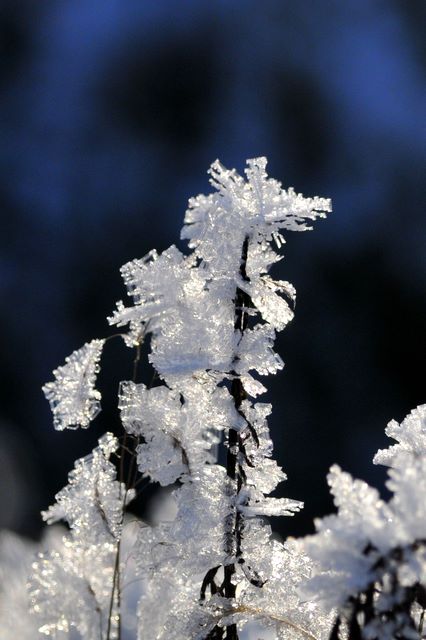
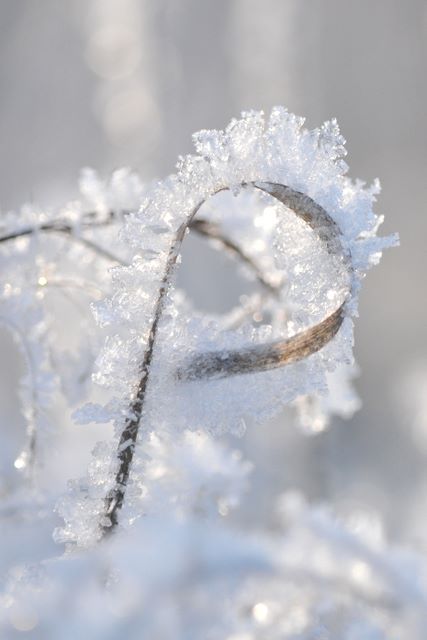
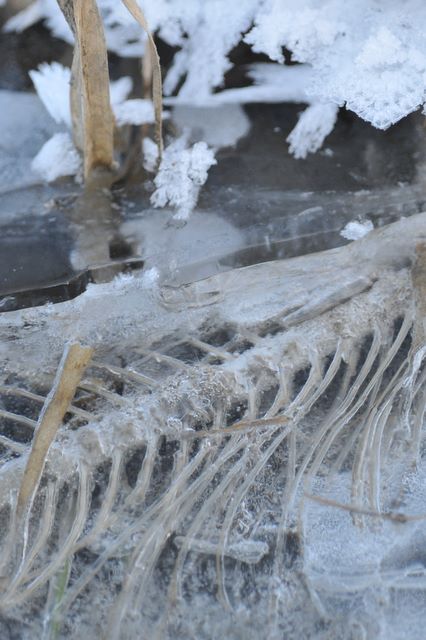
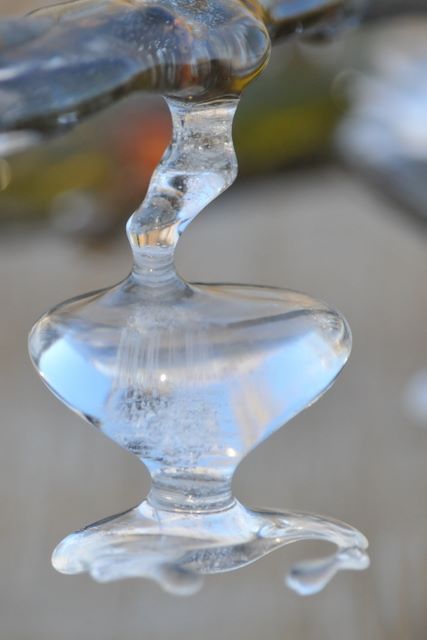
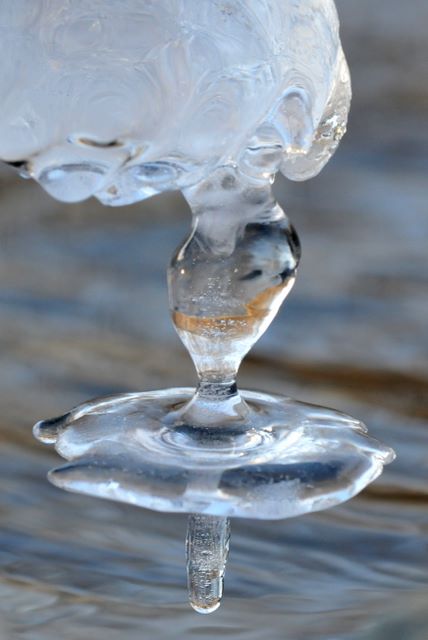
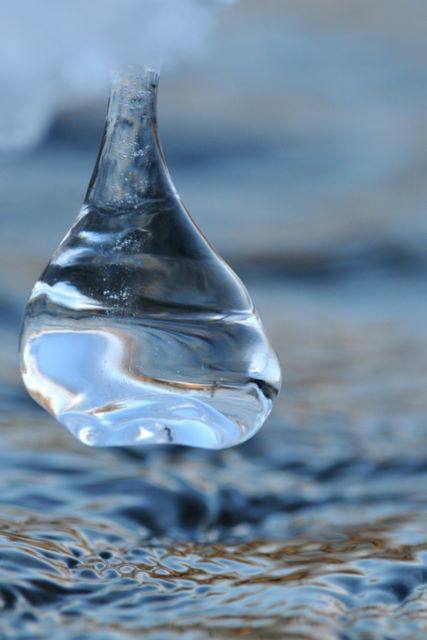 I took a walk down to O'Grady in the afternoon to check out the ice before it melts and to try for a
few photos gulls along the river. The gravel bars are all fringed with a shelf of ice and quiet
backwaters are frozen thick enough to support my weight but there wasn't any slush or ice in the
running water. The ice formations made more interesting photos than did the gulls. I left the 300
f4 lens on instead of swapping it for the more versatile 18-105 which probably would have done a
better job on the ice.
I took a walk down to O'Grady in the afternoon to check out the ice before it melts and to try for a
few photos gulls along the river. The gravel bars are all fringed with a shelf of ice and quiet
backwaters are frozen thick enough to support my weight but there wasn't any slush or ice in the
running water. The ice formations made more interesting photos than did the gulls. I left the 300
f4 lens on instead of swapping it for the more versatile 18-105 which probably would have done a
better job on the ice.
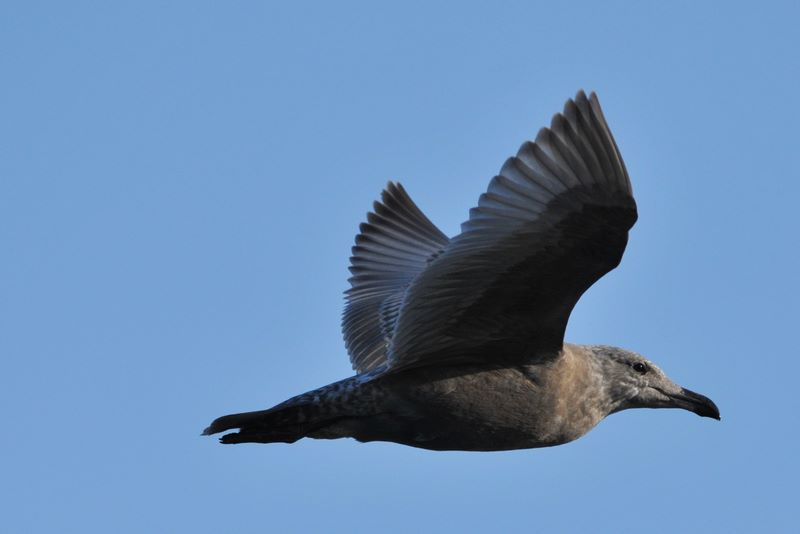
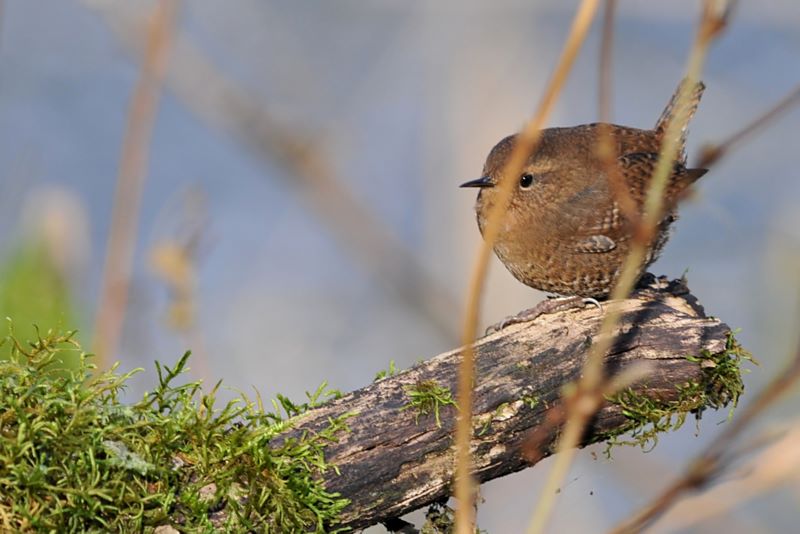 There were still a few dead salmon in the water so the gulls, all glaucous-winged, are still around
along with a few Bald Eagles. Ducks were scarce; I heard gunshots from time to time downstream. In the
woods winter wrens were exploring the frozen leaf litter, their toenails (claws?) making small scratchy
sounds on the dry leaves. If I stood still and happened to be in their path, they would come quite close
to me. I had one good photo op but my only unobstructed shots suffered from motion blur at 1/250.
There were still a few dead salmon in the water so the gulls, all glaucous-winged, are still around
along with a few Bald Eagles. Ducks were scarce; I heard gunshots from time to time downstream. In the
woods winter wrens were exploring the frozen leaf litter, their toenails (claws?) making small scratchy
sounds on the dry leaves. If I stood still and happened to be in their path, they would come quite close
to me. I had one good photo op but my only unobstructed shots suffered from motion blur at 1/250.
High clouds at times brought the temperatures up, though not high enough to melt frost in the shade.








12/13/2009 26- (low 19)
The end of the cold spell.
The end of the cold spell.
12/16/2009 low 40's, rain late
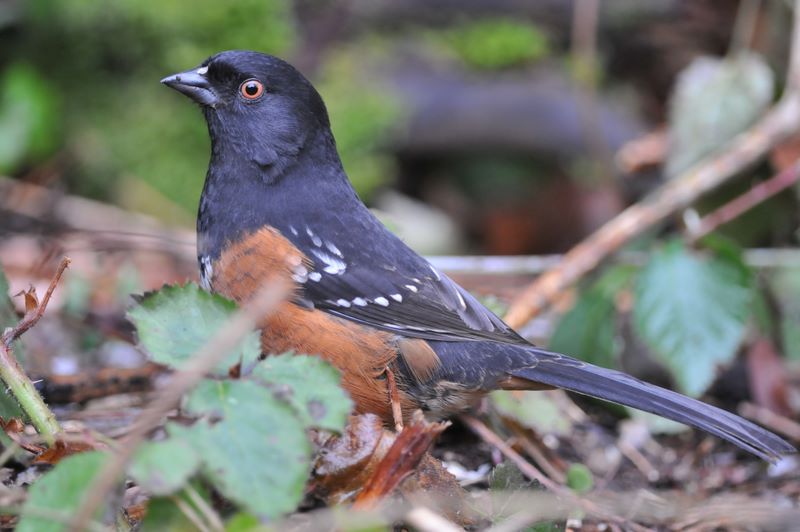
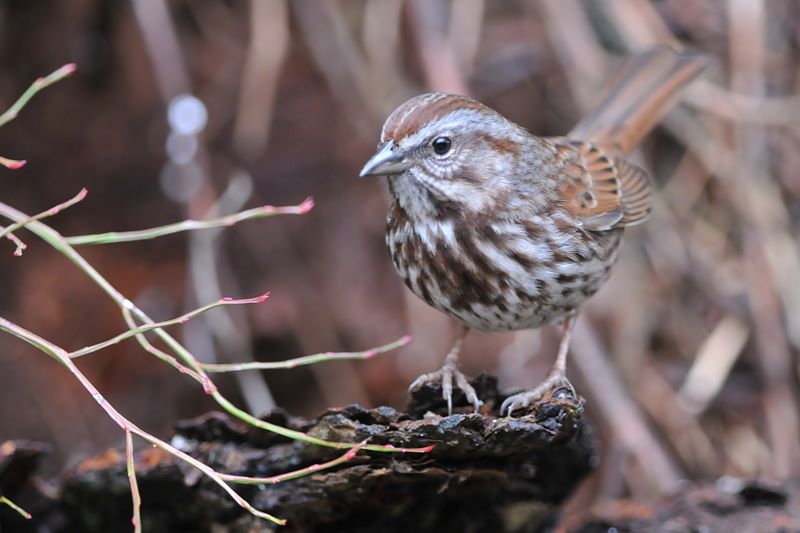
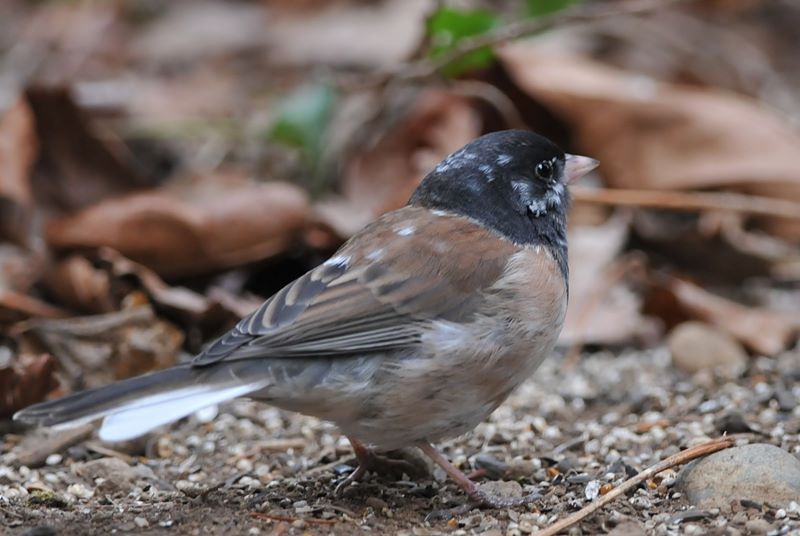
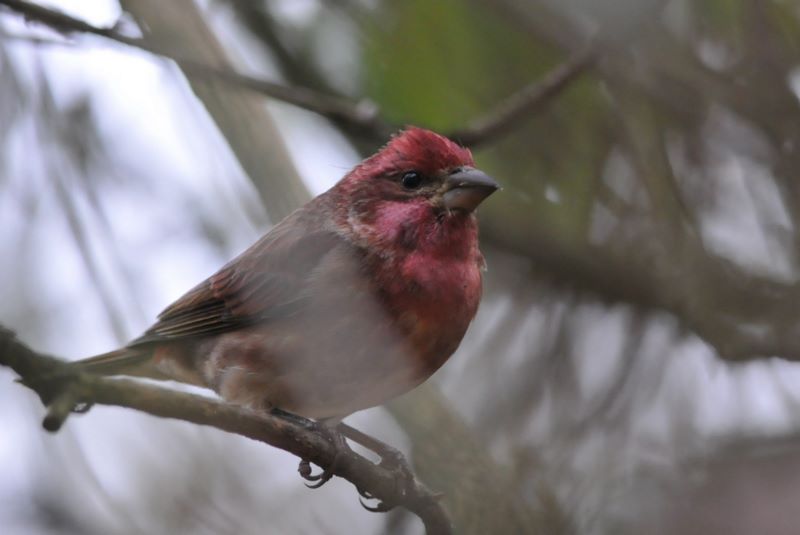
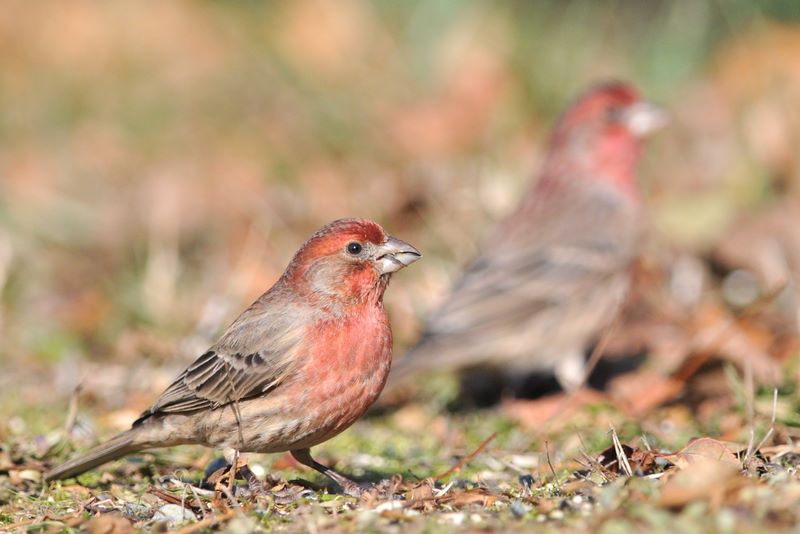





Recent yardbirds photographed from a couple of simple blinds. From L, Spotted Towhee, a pale Song Sparrow, a leucistic Dark-eyed Junco, a late Purple Finch and House Finches
Completed the Half Fanatics Profile Page and layout enhancements today. I thought I finished it
yesterday with the addition of the photo upload functionality but I hadn't tested the revisions in
IE. When I did I discovered that the content div was stacked below the navbar div on the left side
of the page instead of it's intended position to the right of the navbar. Once I fixed that by
adjusting the widths, I found that the masthead, which lined up perfectly in Firefox, remained
offset a few annoying pixels to the left of the content below it. I wasn't able to resolve that
problem, which appears to be related to how Firefox and IE account for borders in their div width
calculations. After reviewing and touching up all the pages I re-deployed them to the web. Next
step is to migrate the new Profile page and layout enhancements to the Maniacs site as well. The
Half Fanatics work has taken me 50 hours or so over the past week; I don't expect the Maniacs work
to go much more quickly due to the extensive refactoring involved.
12/19/2009 Pigtail's Marathon Drizzle, 45
Van move the start from Renton to Landsberg due to permitting difficulties with the city of Renton. For the marathon, we ran from Landsberg down 12.5 miles on the Cedar River trail after a half-mile out and back on the water line trail on the south side of the river. Due to the growing number of runners, she decided to get permits this year, working with Kathy at King County for use of the trail and PNWTF for liability insurance. To cover her costs, which also included registration through Databar and lots of good food at the finish, she charged $5 per runner payable at the start. That approach seemed to work out well.
Despite not wearing quite enough clothing I really enjoyed the run.
Van move the start from Renton to Landsberg due to permitting difficulties with the city of Renton. For the marathon, we ran from Landsberg down 12.5 miles on the Cedar River trail after a half-mile out and back on the water line trail on the south side of the river. Due to the growing number of runners, she decided to get permits this year, working with Kathy at King County for use of the trail and PNWTF for liability insurance. To cover her costs, which also included registration through Databar and lots of good food at the finish, she charged $5 per runner payable at the start. That approach seemed to work out well.
Despite not wearing quite enough clothing I really enjoyed the run.
12/25/2009 Christmas in Jackson Sunny in AM, increasing clouds later, low 30's
The family converged on Jackson for Christmas - our family from Seattle, Silas from Italy, Kirsten from France, Bridget from London, Eric from up the hill, Sarah and Roger from down in the field. On Christmas Eve we went for a walk in the sunshine, decorated the tree, disposed of the frozen Halloween pumpkins in the brook, prepared for and hosted the Christmas Eve party and went to church for the Christmas Eve service. We gathered at Sarah and Roger's on Christmas morning for stockings and their traditional rice pudding breakfast then returned to the house to open the mountain of presents under the tree. I ate a big lunch then got out for a fairly easy ski tour on the trails down to the Eagle Mt golf course. Later we all joined Joe and Virginia for supper at their house.
The family converged on Jackson for Christmas - our family from Seattle, Silas from Italy, Kirsten from France, Bridget from London, Eric from up the hill, Sarah and Roger from down in the field. On Christmas Eve we went for a walk in the sunshine, decorated the tree, disposed of the frozen Halloween pumpkins in the brook, prepared for and hosted the Christmas Eve party and went to church for the Christmas Eve service. We gathered at Sarah and Roger's on Christmas morning for stockings and their traditional rice pudding breakfast then returned to the house to open the mountain of presents under the tree. I ate a big lunch then got out for a fairly easy ski tour on the trails down to the Eagle Mt golf course. Later we all joined Joe and Virginia for supper at their house.





The day after Christmas Daniel, Silas, Kirsten and I skied down to the village and up to the warming shack on the Ellis River trail. We wore ourselves out trying to keep up with Silas. Heavy rain overnight into the 27th turned the hard-packed snow in the driveway to slush so I shoveled it all out of the way. Great Brook cleared all the ice and snow out of its way too. Late in the afternoon the rain finally let up so the boys and I drove down to check out Jackson Falls. We took photos while the light held up then Daniel and David pushed beached slabs of ice back into the raging torrent. Tough work but someone had to do it.
12/29/2009 Jackson Sunny, cold and windy
Packing up was simple so Daniel and I found time for one more ski outing. I used the rental boots because my little toes were sore, and the rental skis because the boots don't fit the bindings on the other skis (other than Daniel's, which I judged too narrow for me). The rental skis were a disappointment, neither gripping on the kick nor sliding on the glide; the wind was biting cold on our faces and the track was icy in places but it was nice to get out one last time nonetheless. On the walk along Wilson road out to the trail I found a flock of redpolls in the road; they let me get quite close but I didn't have the camera.
We left only 15 minutes late. Saying goodbye was difficult; we'd had a nice visit and I wished we could have stayed longer. We ran into traffic entering North Conway but made up some time on the West Side Road. The wind was scouring the fields sweeping plumes of snow up into the treetops and streaming drifts across the road. I was glad to be in the warm car. Around Milton the wind died down for awhile and the temperature rose to 18F before dropping back to 12F as the wind picked up farther south. Just after the traffic circle at 1A I spotted a peregrine riding the wind over Revere Beach Parkway. It sliced down and sailed back up over the fuel tanks along 1A, pulling ahead of us and crossing over to the west where we lost it over the ships in the channel there. Clearly too big for a merlin or kestrel, too sharp for a crow or pigeon, too small and stiff in flight for a gull.
Daniel gave us a scare, discovering just after we boarded the Budget shuttle bus that his wallet was missing. I worried that he'd left it in Jackson but he found it back in the rental car which had already been moved to the overflow lot. He caught the shuttle behind us so we were able to check in together. The long wait I feared at Security failed to materialize; in fact, there was no line and we made it to the gate with 20 minutes to spare. Silas on the other hand found out when he arrived at his terminal that his flight had been cancelled but by then we were already in the air and unable to help. I haven't heard yet what he did during his extra day in Boston.
Packing up was simple so Daniel and I found time for one more ski outing. I used the rental boots because my little toes were sore, and the rental skis because the boots don't fit the bindings on the other skis (other than Daniel's, which I judged too narrow for me). The rental skis were a disappointment, neither gripping on the kick nor sliding on the glide; the wind was biting cold on our faces and the track was icy in places but it was nice to get out one last time nonetheless. On the walk along Wilson road out to the trail I found a flock of redpolls in the road; they let me get quite close but I didn't have the camera.
We left only 15 minutes late. Saying goodbye was difficult; we'd had a nice visit and I wished we could have stayed longer. We ran into traffic entering North Conway but made up some time on the West Side Road. The wind was scouring the fields sweeping plumes of snow up into the treetops and streaming drifts across the road. I was glad to be in the warm car. Around Milton the wind died down for awhile and the temperature rose to 18F before dropping back to 12F as the wind picked up farther south. Just after the traffic circle at 1A I spotted a peregrine riding the wind over Revere Beach Parkway. It sliced down and sailed back up over the fuel tanks along 1A, pulling ahead of us and crossing over to the west where we lost it over the ships in the channel there. Clearly too big for a merlin or kestrel, too sharp for a crow or pigeon, too small and stiff in flight for a gull.
Daniel gave us a scare, discovering just after we boarded the Budget shuttle bus that his wallet was missing. I worried that he'd left it in Jackson but he found it back in the rental car which had already been moved to the overflow lot. He caught the shuttle behind us so we were able to check in together. The long wait I feared at Security failed to materialize; in fact, there was no line and we made it to the gate with 20 minutes to spare. Silas on the other hand found out when he arrived at his terminal that his flight had been cancelled but by then we were already in the air and unable to help. I haven't heard yet what he did during his extra day in Boston.
12/30/2009 Home again Mostly cloudy, 35-48
The heat was off when we arrived home; turns out the burner nozzle clogged again, for the first time in a couple of years. The temperature in the living room when I got up (before dawn) around 7 was 43F. I spent the morning feeding the fireplace with minimal effect on the ambient temperature; around midday we realized that it was warmer outside so we opened the doors. At Susan's suggestion I fired up the stove in the den, leaving the window open while it heated up and burned off the dust. Eventually it warmed up the den nicely and even brought the temperature upstairs up a few degrees. Phil from House of Heat came by later in the afternoon and fixed the burner problem while I was out running. It was a difficult run due to fatigue and stomach discomfort though I felt better towards the end. I made it through by walking 20-30 steps every couple minutes. My HR adjusted to a 10:00/mi equivalent was 129, unusually low.
The heat was off when we arrived home; turns out the burner nozzle clogged again, for the first time in a couple of years. The temperature in the living room when I got up (before dawn) around 7 was 43F. I spent the morning feeding the fireplace with minimal effect on the ambient temperature; around midday we realized that it was warmer outside so we opened the doors. At Susan's suggestion I fired up the stove in the den, leaving the window open while it heated up and burned off the dust. Eventually it warmed up the den nicely and even brought the temperature upstairs up a few degrees. Phil from House of Heat came by later in the afternoon and fixed the burner problem while I was out running. It was a difficult run due to fatigue and stomach discomfort though I felt better towards the end. I made it through by walking 20-30 steps every couple minutes. My HR adjusted to a 10:00/mi equivalent was 129, unusually low.